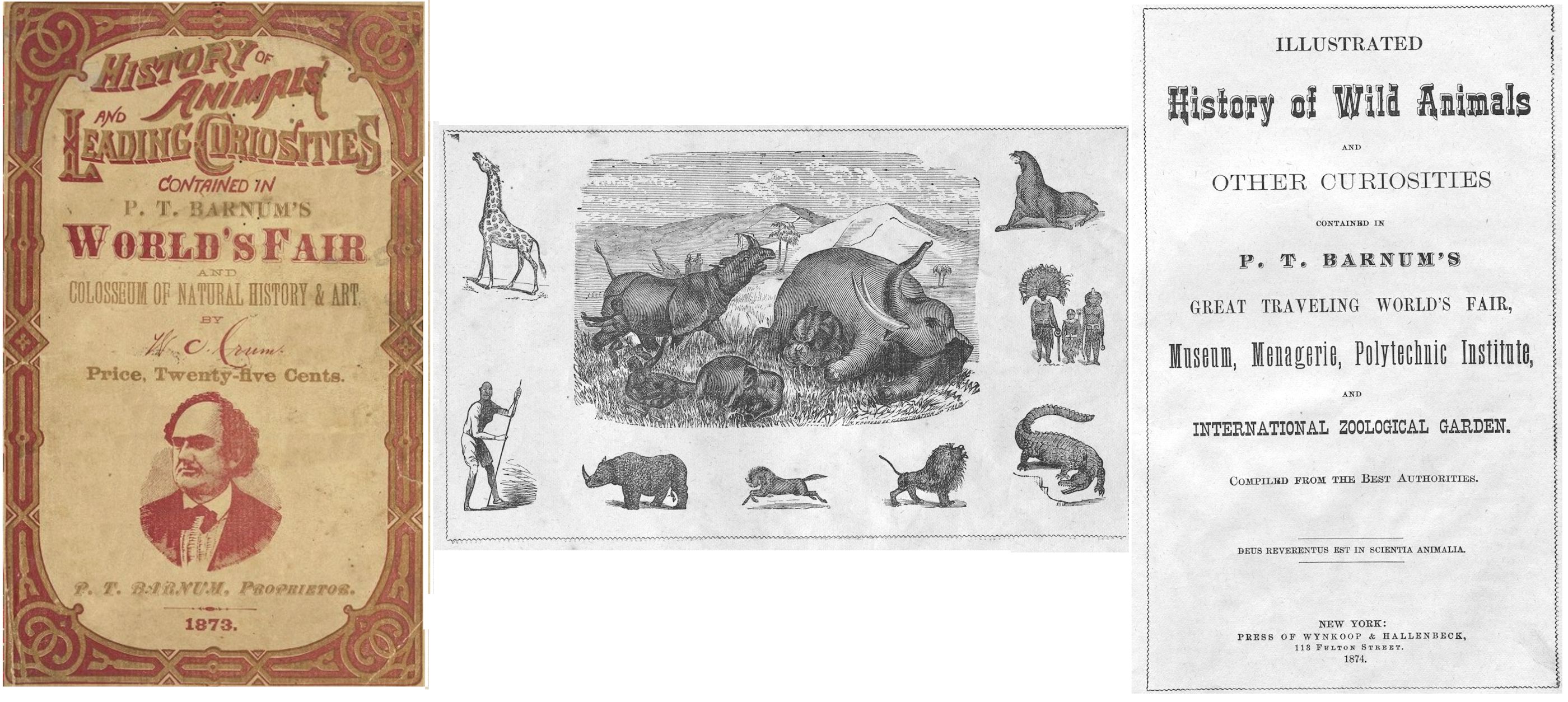
HISTORY OF ANIMALS AND LEADING CURIOSITIES CONTAINED IN P. T. BARNUM'S WORLD'S FAIR AND COLOSSEUM OF NATURAL HISTORY AND ART.
[1873 title: HISTORY OF ANIMALS AND LEADING CURIOSITIES CONTAINED IN P. T. BARNUM'S WORLD'S FAIR AND COLOSSEUM OF NATURAL HISTORY AND ART.]

PRICE, TWENTY-FIVE CENTS.
P. T. BARNUM, PROPRIETOR.
1874.
ILLUSTRATED HISTORY OF WILD ANIMALS AND OTHER CURIOSITIES CONTAINED IN P. T. BARNUM'S GREAT TRAVELING WORLD'S FAIR, MUSEUM, MENAGERIE, POLYTECHNIC INSTITUTE AND INTERNATIONAL ZOOLOGICAL GARDEN COMPILED FROM THE BEST AUTHORITIES.
DEUS REVERENTUS EST IN SCIENTIA ANIMALIA
NEW YORK
PRESS OF WYNKOOP & HALLENBECK, 113 FULTON STREET
1874
TO THE READER.
In the compilation of the following pages, and particularly in the brief treatise on animals, especial pains have been taken to divest the subject, as much as possible, of scientific terms and conventional technicalities. There is danger of an extreme, however, in the opposite direction.
In the ordinary language of zoology, a Greek or Latin appellative, which has been so often and so long repeated as to be quite familiar to minds of ordinary capacity, will not be looked upon as very classical or far-fetched; and should an occasional sentence of technical phraseology be used in the description of animal life, or in speaking of their anatomy and physiology, the interest and importance of the subject under consideration, and not a desire to be considered erudite or scholastic, shall be the only apology offered for their occasional substitution.
The subject of Natural History is one of the most fascinating that can possibly engage the attention of the young. It is invested with a degree of romance and thrilling adventure, inseparable from the illustration, historical and descriptive, of the animal kingdom, as we find them furtively lurking or playfully gamboling in the free exuberance of their own native wilds. It has in it, also sufficient to gratify the love of the marvelous, which every person possesses in a greater or less degree. There can be no question as to the proper method to be adopted in treating upon it, provided one pursues it with reference to thoroughness; but when the study is reverted to as a matter of pastime, the anecdotal rather than the descriptive will be likely to touch the popular chord. It is impossible, however, in the brief space allotted in this volume, to enter very largely into the anecdotal style: we must confine ourselves to pictorial illustrations and personal habits of the diversified forms of animal life, with which an All-wise Providence has "multiplied and replenished the earth." It is truly a wonderful thing to thoroughly understand the structure and anatomical conformation of the lion, tiger, elephant, and rhinoceros; but it is still more marvelous to understand the principle which gives life and animation to those varied forms.
It is not because of the fangs, talons, strength, or ferocity of the tiger that he is predacious, but because the very elements of his constitution are eminently predacious, and in his midnight depredations for prey he simply obeys the behests of Nature's first law - self-preservation. In searching to find out something of the tiger, therefore, we look to the spirit that animates him, and not to the mere outlines of his physical being.
The tiger, lion, leopard, wolf, etc., belong to a separate class, called carnivora; this, from the Latin, means ‘feeding on flesh." All animals that feed on flesh are predacious, that is, "live by hunting." Whether feeding exclusively on flesh makes animals savage or ferocious, or whether the imperative demands of appetite beget ferocity, are questions which need not enter into discussion here.
There is another class of animalia called herbivorous. All herbivorous animals are ruminant, that is, chew the cud. All ruminants are comparatively harmless and inoffensive. Of these, the ox, deer, moose, eland, giraffe, gazelle, sheep, etc., which will suggest themselves as the student of natural history familiarizes himself with their generic distinctions.
There are diversified species of animals; these are, for convenience' sake, divided into groups, and there are certain properties belonging to each family, common to all animals comprehended under that class. "And out of the ground the Lord God formed every beast of the field and every fowl of the air, and brought them unto Adam to see what he would call them: and whatsoever Adam called every living creature, that was the name thereof." - GEN. 11. 19.
It is worthy of remark that the names affixed to the different animals in Scripture always express some prominent feature and essential characteristic of the creature to which they are applied; and there seems to be no valid excuse, in this enlightened age of the world, for the ignorance, which is so prevalent, of the multiplied forms and characteristics of the animal kingdom, when every possible means of enlightenment are placed within the reach of all. There is nothing unreasonable in the supposition that Adam, because of his wonderful knowledge of the attributes and habits of animal life, which caused him to properly name every creature that passed. before him, had, on this account, more confidence and faith in the beneficence of the Creator, and a corresponding sympathy and compassion for the aggregated forms of God's universal creaturehood.
We acknowledge, however, the utter impossibility of the great masses becoming adepts in zoology, since the Government has done so little to establish, in convenient localities throughout the country, regularly organized Zoological Gardens, where all may resort and personally examine the myriad varieties of color and form with which the Almighty clothes His living poems.
In the absence of these advantages to the inhabitants of the cities, as well as the country, a partial remedy is found in the liberality of private enterprise. P. T. BARNUM - the most liberal and enterprising capitalist of the age, and, in the way of public benefactions, a hundred years in advance of all his compeers – in 1865 instituted a project which, had it been carried out, would have culminated in a monumental triumph, and been of incalculable benefit to scientific zoology in America. After the burning of his Broadway Museum and the destruction of valuable acquisitions of years, it occurred to him that, if our government representatives abroad could use their influence to secure curiosities in the respective countries to which they were accredited, a free public Museum might at once be instituted in New York, and proposed the liberal offer of a part of his own establishment, rent free, in furtherance of the plan.
A memorial was accordingly addressed to the President of the United States, asking him to give his sanction to the contemplated project. This memorial was dated July 20th, 1865, and signed by Messrs. E. D. Morgan, Moses Taylor, Abram Wakeman, Simeon Draper, Moses H. Grinnell, Stephen Knapp, B. R. Winthrop, Chas. Gould, William C. Bryant, - Wadsworth, J. C. Quick, Willis Gaylord, - Wetmore, Henry Ward Beecher, and Horace Greeley. Mr. Barnum, encouraged by such a distinguished list of poets, philanthropists, statesmen, and divines, went to Washington with the memorial, where it was in due time presented, and received the following endorsement:-
"EXECUTIVE MANSION, Washington, D.C., April 27, 1866.
"The purpose set forth in this Memorial is highly approved and commended, and our Ministers, Consuls and Commercial Agents are requested to give whatever influence, in carrying out the object within stated, they may deem compatible with the duties of their respective positions, and not inconsistent with the public interest. – ANDREW JOHNSON."
In the meantime, Mr. Barnum had erected his new Museum, farther up Broadway, and had commenced in good earnest to carry out his plan, when another and still more disastrous conflagration than the first put an end to his favorite project; so that, except a small collection which has been gathered in the Central Park, through the liberal contributions of a few private gentlemen, the whole vast continent of America stands to-day with scarcely an apology for a free public exhibition of Natural History and Art. With this consideration staring him in the face, Mr. Barnum has recently instituted a great moral enterprise, by means of which he hopes to be so far recognized by a generous and appreciative public as to be able to keep in motion a Mammoth Museum and Zoological Garden on wheels, to transport it throughout the country, and, by constantly adding to its attractions unique curiosities and rare living wild animals from every quarter of the globe, supply a cosmopolitan vade mecum, the need of which has seriously been felt for many years.
In carrying out this long-contemplated plan, he has established reliable agencies and opened up communication with all the world, to secure, regardless of cost, the most remarkable curiosities, whether living or representative, that have ever been witnessed, and, by means of many colossal pavilions, afford ample opportunity for all to visit without extra charge. To this list will be added, from time to time, such rare living wonders from the realms of zoology as Mr. Barnum may, through unceasing energies, be able to procure. These will be shipped directly to his private Zoological Gardens, in Bridgeport, Conn., now in process of enlargement, and thence be forwarded to the Traveling Museum and Menagerie, to swell the aggregation or take the place of those which may die.
[1873 edition: ADDENDA, NEW YORK, March 29, 1873.
Since writing the foregoing, many important changes in the history and career of Mr. Barnum's great exhibition have taken place. During the traveling season of 1871 the accumulation of rare animals was quite large. In that of 1872 it had increased to such an extent as to induce the proprietor, who had duplicates of nearly all the different species, to organize a separate zoological and ornithological institute, to send to the Southern States, for exhibition, in the large cities only, during the holiday season, as such a vast collection of rare wild beasts, birds, reptiles, and marine monsters had never been seen there before. In the meantime Mr. Barnum opened his Third Museum, Zoological Garden, and Hippotheatron in Fourteenth Street, New York, Nov. 11. On the 24th day of December, this museum building, with nearly all his valuable collection of rare animals, was consumed by ?re. The circumstance of sending such a collection south proved, in this instance, a happy one, as it has been saved to the public, forming the basis of another enterprise, which has already, at this present writing, assumed colossal proportions, and bids fair to rival the famous Zoological Garden of London.Immediately following this great disaster, Mr. Barnum telegraphed to his numerous agents throughout the world, to spare no time nor money, in forwarding him all the choice and rare specimens of animals and birds to be procured, at any sacrifice. By the ?rst of February animals began to arrive from Europe, and from that time forth till spring, scarcely a vessel arrived in New York from foreign ports that did not contain rare consignments for this great collection of living specimens of natural history. It is Mr. Barnum's intention to make constant accessions of every remarkable variety of foreign animals, including, also, the more uncommon specimens of North and South American varieties.
The two beautiful giraffes belonging to him, which were, at the time of the ?re in New York, in the Zoological Garden of Berlin, will take the place of those consumed in December last, their arrival being now daily expected. These interesting creatures are so delicate that they can only be shipped during warm weather. Several expeditions have already been dispatched to the Arctic and North Paci?c regions for more sea-lions and other marine monsters, and to Africa and Egypt, for crocodiles, hippopotami, and other curiosities from the river Nile.
In the meantime the museum department has been largely reinforced. Hundreds and thousands of interesting attractions and curiosities have been added. Among these we might mention the great Talking Machine of Prof. Faber, which imitates the human voice, and speaks several languages with such marvelous exactness as to elicit the praise of all scienti?c scholars and physicists. Also French and Swiss automatons, Fiji cannibals, Modoc and Digger Indians, musical chariots, moving tableaux, gorgeous spectacular transformations, mechanical moving landscapes, ?itting and singing automaton birds, gorgeous moving rustic scenes, and life-like representations of rippling fountains and running waterfalls and cascades, paintings, classic statuary, and other works of art, besides many other rare novelties never before exhibited to the American public.]
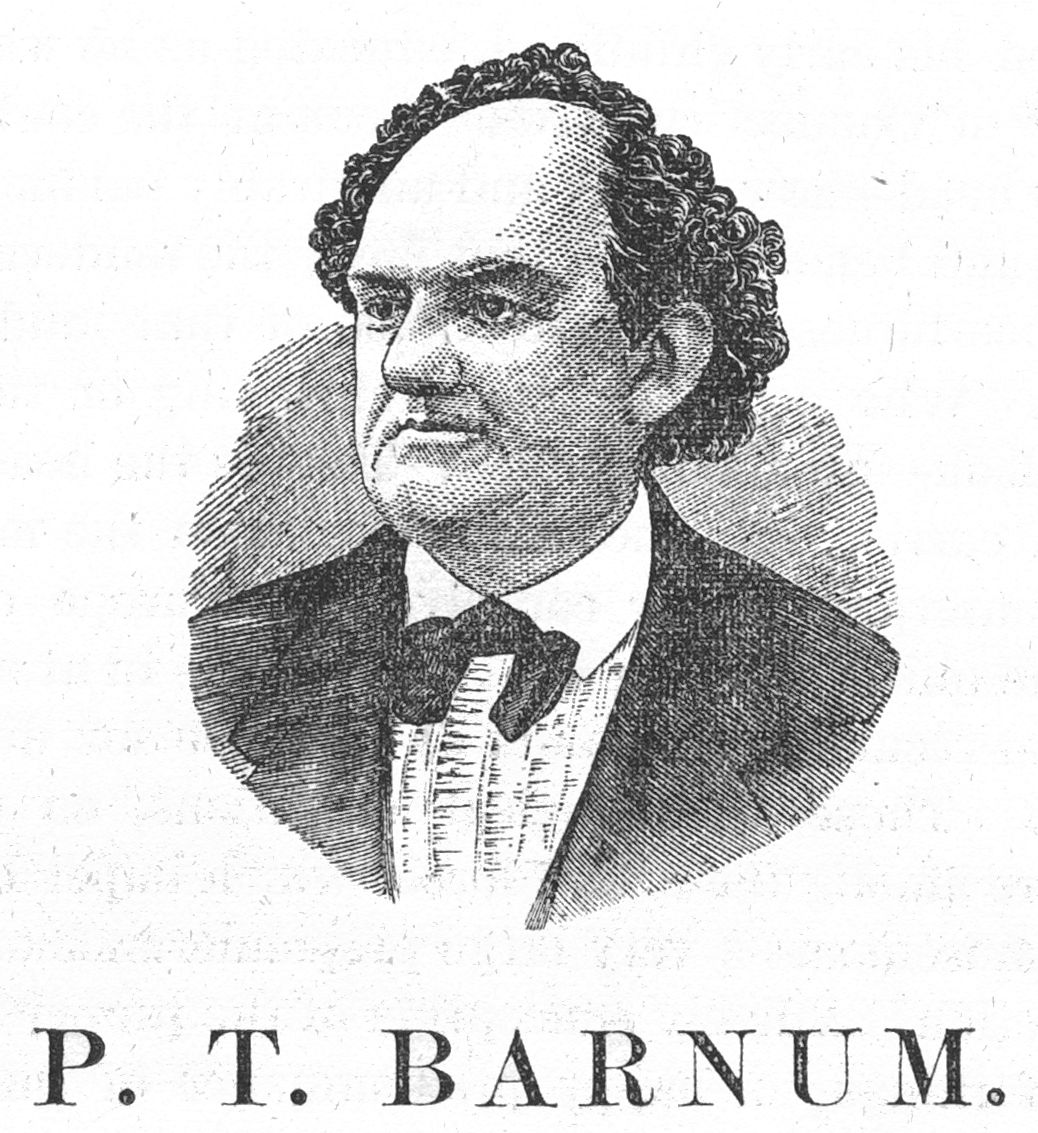
P. T. BARNUM.
"Every man is immortal until his work is done." God did not intend that all men should be either priests, evangelists or prophets. The occupations of men are as diversified as their physiognomies. The demands of the race are as imperious and multiform as the laws that govern our physical being. The elements of human character are as separate and distinct as the species in the animal kingdom. The large, soft, placid eye of the gazelle does not reveal more effectually the sweetness and amiability of its character, in contradistinction to that of the indomitable hyena, or the morose rhinoceros, than the fact which is everywhere recognized of the "eternal fitness of things" in that order of Divine Providence which imposes a diversity, not only in facial contour, but of constitutional idiosyncrasies as well.
This diversity in unity, which characterizes the genus homo , is manifest in all the ramifications of human affairs. P. T. Barnum was born to be a showman - but not a charlatan or a mountebank. In an eminent degree he is endowed by nature to cater to the wants and amusements of the great mass of his fellows. The organs of cheerfulness and mirth are very largely developed, but these are kept in admirable subjection to the greater developments of benevolence and veneration. These inhere from the very nature of that austere and rigid system of moral discipline which marked his early childhood, educated as he was under the "blue code" of Connecticut laws. Look at the conformation of that massive head - how evenly and admirably balanced! That is the head which has planned and carried into successful execution the most gigantic amusement enterprise ever conceived in Europe or America. Those are the quick, piercing eyes which take in at a single coup d'oeil the ever-recurring demands of the race for diversion and amusements. Those craniological elevations, so prominently developed, are among the active forces which impel hi to blend with those amusements a very large preponderance of wholesome moral instruction. A lively conception of the proper relation and utilization of things, a happy predominance of the moral and intellectual faculties; an inherent love of justice and magnanimity, united with a native conscientiousness, cultivated and refined by association with good and great men, have inspired within him an utter contempt for any exhibition which will not repay the visitor a hundred fold for the trouble and expense incurred in witnessing it. For more than forty years he has been intimately identified with the people of both worlds; and so well and favorably is he known as showman, statesman, lecturer, journalist, author and traveler, as well as a founder of cities, and an institutor of the Great American Museum and Colosseum of Natural History and Art, that a bare mention of the name of P. T. Barnum will be quickly understood by the masses, and a synonym for all that can possibly enter into the composition of a successful managerial career. He is, in point of health and vigor, in the very midst of his years. He is capable of bringing to his aid more experience and a riper judgment than ever; and it seems eminently fitting that this last great effort should be the key-stone which is to complete that triumphal arch, the segments of which have been in process of completion for nearly half a century. He appears on the theatre of life's busy stage as modifier and purifier of many of the abuses which have crept into public amusements, and, through his persistent efforts to divest them of immoralities, will challenge the admiration of a carping world.
BARNUM'S MUSEUM, MENAGERIE, AND COLOSSEUM OF NATURAL HISTORY AND ART.
THE GIRAFFE. (Giraffa Camelopardalis.)
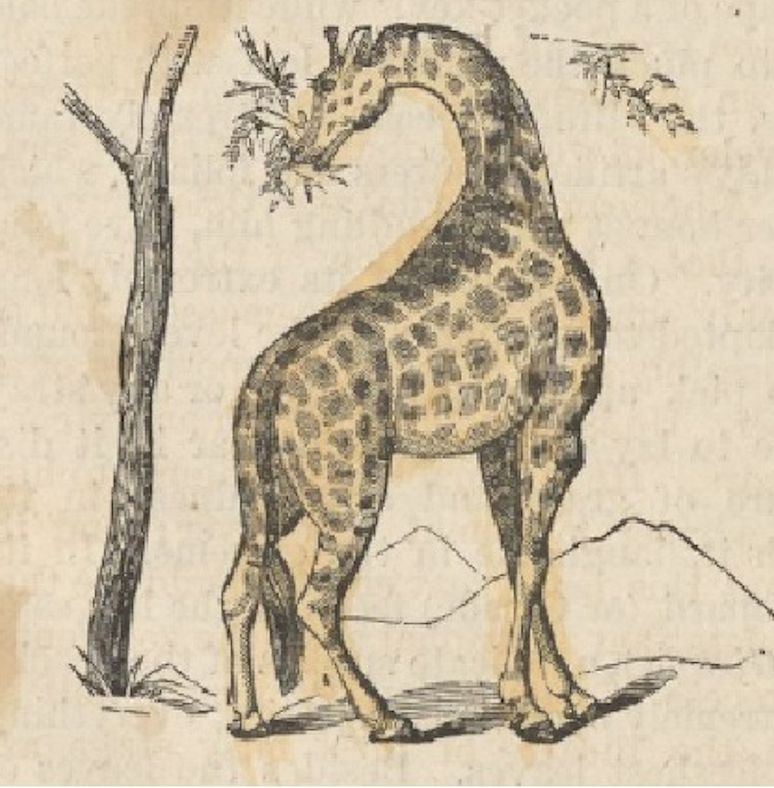
The height of a full-sized male Giraffe is from eighteen to twenty feet - by far the tallest and most stately of all the dwellers that ever walked on the face of God's earthly heritage. It is an inhabitant of the various parts of Africa, the color of the coat being darker in the southern than that of the northern regions of that fer tile abode of the most marvelous of the zoologic race. It towers above its fellows, unique in its proportions, mild in disposition, majestic in mein, and peerless in the lustre of its large, loving eyes. While it includes in its physical make-up the characteristics of an entire tribe, it really seems to partake of the attributes of no other species mentioned in the compendium of generic distinctions. It is an animal of enormous size, but its altitude is attributable to its extra- ordinary long neck and shoulders. There are in the neck of the Giraffe seven vertebrae, the same as other animals; but they are extremely elongated, while the articulation is admirably adapted to the purpose they are called upon to fill.
On first looking at this beautiful animal, one would suppose that the fore legs were longer than the hinder limbs. This, however, is not the fact. The apparent difference lies in the remarkable elongation of the shoulder-blades, and the great depth from the withers to the carotid veins. From the highest point of the shoulder to the caudal there is a gradual slope, or declination, of from twenty to forty degrees, which precludes the possibility of ever making the Giraffe a beast of burden. Upon the head of this strange animal grow two excrescences, resembling obtuse horns - a kind of ossis fungi, in substance bearing a striking likeness to the first developments of the antlers on the heads of the fallow deer. These quasi horns are covered with skin, and on the extreme top protrudes a bush-like tuft of dark hair. Lower down on the forehead, and nearly between the eyes, is another osseous projecture - a kind of apologetic imitation of the horn of the unicorn As the Giraffe browses almost exclusively on the leaves of the forest trees, how entirely in accordance with the will of a Divine Providence has this marvel of the animal kingdom been physically endowed! In order that it might be able to select and gather that kind of foliage best adapted to a palate of exquisite taste, the tongue of the camelopard is provided with prehensile power, capable of contraction or elongation in a wonderful manner. We are informed by those most familiar with the Giraffe, "that it can contract the tip of its tongue into so small a compass that it can pass into the pipe of a pocket- key," while its prehensile powers enable its owner to pluck the minutest leaf with perfect ease. While in captivity, the Giraffe becomes extremely tame and familiar, as many a lady's arti?cial ?owers and foliage, which she chanced to have on her bonnet while fondling him, have paid the penalty of her temerity. On account of its extremely long neck, the Giraffe is not adapted to grazing upon the level ground. Whenever it attempts to pick up a lump of sugar, or any stray delicacy that may chance to lay on the ground near it, it displays a comical admixture of grace and awkwardness, in its grotesque efforts to reach it, laughable in the extreme. In its native country the Camelopard (or Giraffe) feeds on the leaves of the kameel-dorn (Acacia Giraffae), a delicate species of the acacia- thorn. Its appetite is extremely capricious, rejecting everything except the greenest and freshest leaves. Besides the leaves of the palm-tree and camel-thorn, it also feeds, while in captivity, on cut grass, carrots, onions, oats, sweet potatoes, and other vegetables. By its well-known habits of gentleness and playfulness, the Giraffe may well be denominated the coquette of the antelope tribe. When placed on exhibition in the menagerie, it seems to be delighted with the advent of numerous visitors, whom it scrutinizes in the most bewitching and gallant manner, being an enthusiastic admirer of the gay, fantastic attire in which ladies sometimes appear.
Like the eland and kangaroo, the Giraffe is a silent animal, never uttering a sound as an expression of pleasure, or while suffering the agonies even of death itself. From the peculiarity of its gastric secretions, the Giraffe becomes strongly perfumed with the foliage upon which it feeds, exhaling a powerful odor, compared, by Capt. Cumming, to a hive of heather-honey. Destitute of aggressive power, and naturally docile and lamb-like in disposition, the Giraffe can, nevertheless, defend itself against ordinary foes, such as predacious carnivora - heartless denizens of its own native soil. Elevating its graceful neck and head high in air, when attacked by an enemy, it will deliver a shower of kicks with such celerity and precision as to daunt the lion, which it sometimes sends coweringly away to the nearest jungle. On rough, uneven soil, the Giraffe possesses great advantage over the hunter; but, on level ground, the Kaffre Nimrods, mounted on their Pegasian chargers, will spring the lasso over the head of his spotted highness, and soon overpower him by means of the rope to which he is now helplessly tethered. Another method of capturing the Giraffe is by means of stalking, and the pit-fall, identically the same as is used for trapping the rhinoceros and hippopotamus, only the sharp stake for impaling the latter is not used in the capture of the former.
From the general contour of the Giraffe, one would suppose it to be fleet of foot; but this is not the case. When running, it makes a very awkward and ludicrous series of frog-like leaps, its tail meanwhile frisking about at regular intervals, its long neck rocking up and down like a crazy mast at sea, making an alternate obeisance to each successive wave.
The spoor, or foot-marks, which are eleven inches in length, pointed at the toe and rounded at the heel, are very easily traced in the sands of Africa, and, being gregarious, a herd of thirty or forty of them will leave behind them vestiges not to be mistaken.
The color of the Giraffe is a pale, ofttimes creamy light, with large irregularly-shaped spots covering the neck and body. Its hide is enormously thick and obdurate, capable of resisting almost any force the native hunters, with their imperfect weapons, are capable of hurling against it. It is not easily killed; and yet, as strange as it may appear, it is one of the most difficult of the animal kingdom to acclimate, and made to subserve the purposes of a traveling exhibition. During the last eighteen months Mr. Barnum has lost three of these valuable animals while crossing the Atlantic, which cost from $4,000 to $8,000 apiece. In fact, nearly all the showmen of the country have abandoned the idea of attempting to furnish these expensive creatures at all. Those belonging to Mr. Barnum were secured. through the indefatigable labors of his agents in Abyssinia, and are the only living Giraffes on the continent of North America.
THE ELEPHANT. (Elephas Indicus.)
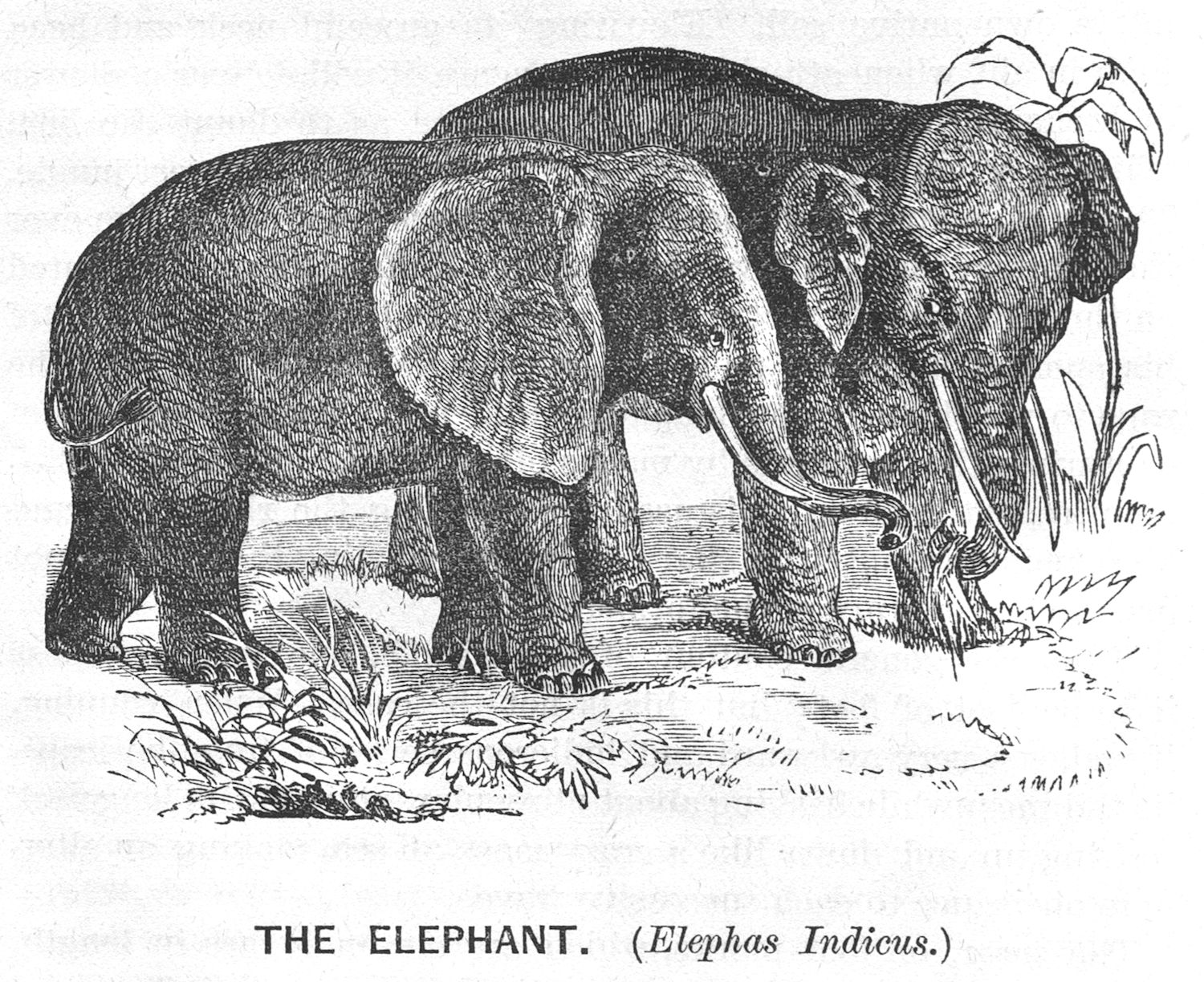
THE Elephant is the largest and most ponderous of the pachydermata, or thick-skinned animals, and, since the days of the Mastodon, is one of the most gigantic specimens of zoology known to the human race. The genus Elephantidae embraces in its nomenclature, according to the generic classification of recognized professors of natural history, the elephants, tapirs, swine, hyrax, rhinoceros, and hippopotamus.
There are found two distinct species, which are well known as the African and Asiatic Elephants. The latter will always be known by the dimensions of the head and ears - one of the most noticeable points of distinction existing between them. The head of the Asiatic Elephant is somewhat elongated, the forehead concave, and the ears of an ordinary size; while the head of the African Elephant is much shorter, the forehead convex, and the ears of great breadth and magnitude, covering nearly a sixth of the entire body. Among the Asiatic Elephants only the male portion are supplied with tusks, while both the male and female of the African species are equally furnished with the long projecting ivories. Both varieties are gregarious - always going in herds, and, when about to cross a river or any body of water, send the smallest first, so that, in case of accident or foundering, the larger ones can come to the rescue.
One of the strangest, yet most useful appendages of the Elephant, is his trunk, or proboscis. This feature of the animal seems to be an extraordinary development of the upper lip or nose. Itis perforated through its entire length by the nostrils, and, at the tip of the trunk, is supplied with a finger-like appendage, by means of which it is enabled to pick up objects of the most diminutive size, or thrust it into the vest-pockets of the bystanders, and triumphantly seize the most trifling bijou that may be concealed therein. The trunk of this huge animal performs a very important part in his well-being; for, without it, he would very soon starve to death and perish. With it he supplies himself with both food and water. It is not only possessed with great flexibility, capable of extension and contraction, but also with enormous strength. There are no less than fifty thousand distinct muscles running longitudinally along the axis of the proboscis, or radiating from the centre to the circumference.
The immense weight of the Elephant is supported by large limbs, perpendicularly set, and so adjusted as to bear a great mountain of flesh for their superstructure, as may be seen on glancing at this giant of the mammalian race. The cannon-bone, as is common with other animals, is not elongated in the limbs of the Elephant; the hind-legs, therefore, are devoid of the so-called knee-joint.
If we investigate the anatomy of this wonderful creature, we will find that the hoof which incloses the foot is composed of a vast number of horny plates, arranged on the principle of the carriage-spring, by means of which the tread of the Elephant is as light, noiseless, and elastic as any of the cat tribe, barring, of course, the vast difference in size. "The points of a good Elephant," says the Rev. J. G. Wood, "are as important in India and Ceylon as those of a horse in Europe." The softness of the skin, the red color of the mouth and tongue, the forehead expanded and full, the ears large and rectangular, the trunk broad at the root and blotched with pink in front, the eyes light and kindly, the cheeks large, the neck full, the back level, the chest square, the fore-legs short and convex in front, the hind-quarters plump, five nails on each toot, all smooth, elastic and round; these are the points of the famous Elephant which was used by Mr. Barnum on his farm in Bridgeport, Ct., for plowing and agricultural purposes. This same Elephant, together with one still larger, and a baby Elephant, are now connected with the Great Traveling Zoollogical Garden. Mr. Barnum is entitled to the credit of converting the first Elephant into a husbandman, or testing his adaptability for general agricultural purposes.
For the most part, Elephants, after they are trained and domesticated, become mild, gentle, and harmless. At certain times, however, they become restive and excited, and then commence a regular tantrum, when they will attack anything or anybody that comes in their way. Fortunately, however, during this temporary paroxysm they are carefully guarded by their keepers, so that accidents of fatality or death are very seldom known as the result of an elephantine "must."
Incidents of animal sagacity are of every-day occurrence, but nothing can compare with that of the well-trained Elephant. Sir Emerson Tennent, in his valuable work on Ceylon, while illustrating the well-known sagacity of the Elephant, says: ‘‘One evening, while riding in the vicinity of Kandy, towards the scene of the massacre of Major Davis's party in 1803, my horse evinced some excitement at a noise which approached us in the thick jungle, and which consisted of a repetition of the ejaculation, Urmph! Urmph! in a hoarse and dissatisfied tone. A turn in the forest explained the mystery, by bringing me face to face with a tame Elephant, unaccompanied by any attendant. He was laboring painfully to carry a heavy beam of timber, which he balanced across his tusks; but, the pathway being narrow, he was forced to bend his head to one side to permit it to pass endways, and the exertion and inconvenience combined led him to utter the dissatisfied sounds which disturbed the composure of my horse. On seeing us halt, the Elephant raised his head, reconnoitered us for a moment, then flung down the timber and forced himself backwards among the brushwood, so as to leave a passage, of which he expected us to avail ourselves. My horse still hesitated; the Elephant observed, and impatiently thrust himself still deeper into the jungle, repeating his cry of Urmph! but in a voice evidently meant to encourage us to come on. Still the horse trembled, and, anxious to observe the instinct of the two sagacious creatures, I forbore any interference. Again the Elephant wedged himself further in amongst the trees, and waited impatiently for us to pass him; and after the horse had done so, tremblingly and timidly, I saw the wise creature stoop and take up his heavy burthen, turn and balance it on his tusks, and resume his route, hoarsely snorting, as before, his discontented remonstrance."
Mr. Barnum, in his last best book, or autobiography, so full of interest and anecdote of "Struggles and Triumphs; or, Forty Years, Recollections of P. T. Barnum" (one of the most charming and interesting productions of his graphic and ofttimes brilliant pen that ever issued from the press - nine hundred pages, thirty-two full-page engravings, reduced from $3.50 to $1.50 - gives us some very laughable instances of his attempt at farming with an Elephant, and says: "Hundreds of people came many miles to witness the novel spectacle. Letters poured in upon me from the secretaries of hundreds of State and County Agricultural Societies throughout the Union, stating that the presidents and directors of such societies had requested them to propound to me a series of questions in regard to the new power I had put in operation on my farm. Among these were:-
"1. Is the Elephant a profitable agricultural animal?
"2. How much can an Elephant plow in a day?
"3, How much can he draw?
"4, How much can he eat?
"5, Will Elephants make themselves generally useful on a farm?
"6, What is the price of an Elephant?
"7, Where can Elephants be purchased.
"I suppose," continues Mr. Barnum, "some of my inquirers thought the Elephant would pick up chips, or even pins, as they have been taught to do, and would rock the baby and do all the chores, including the occasional carrying of a trunk, other than his own, to the depot." While this gigantic co-operative in the primordial occupation of man was daily engaged in the pursuits of the farm, "newspaper reporters," continues the famous autobiographer, "came from far and near, and wrote glowing accounts of his elephantine performances. One of these reporters said: ‘Barnum's Elephant built all the stone-walls on the farm; made all the rail-fences; planted corn with his trunk and covered it with his foot; washed my windows and sprinkled the walks and lawns, by taking the water from the water-basin with his trunk; carried all the children to school, and put them to bed at night, tucking them up with his trunk; fed the pigs; picked fruit from the branches that could not otherwise be reached; turned the fanning-mill and corn-sheller; drew the mowing-machine, and turned and cocked the hay with his trunk; carried and brought my letters to and from the post-office (it was a male elephant), and did all the chores about the house, including milking the cows and bringing in the eggs.'"
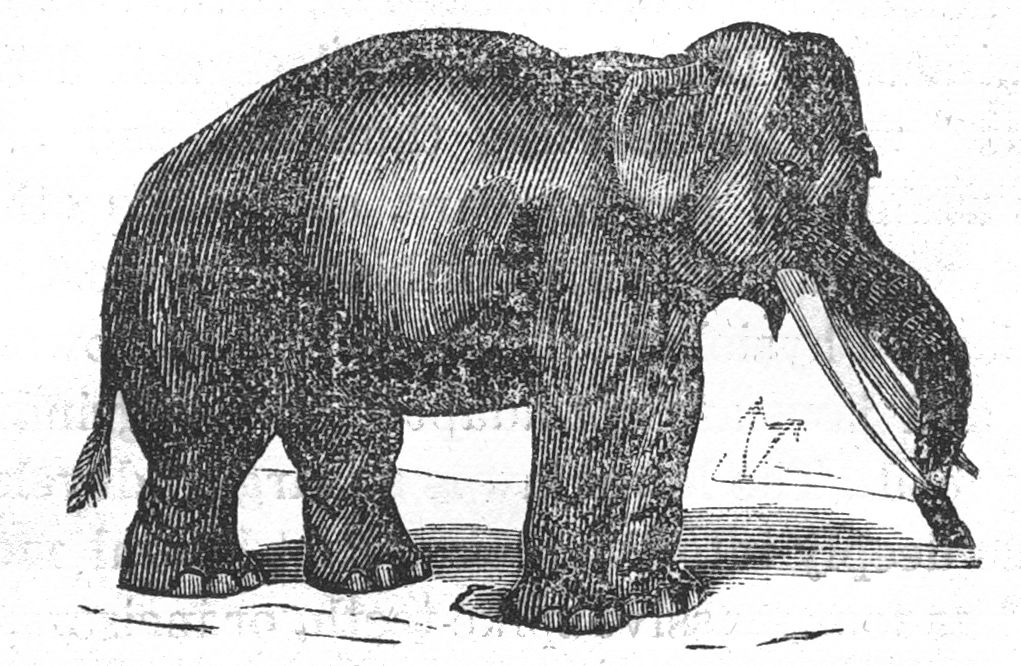
While the foregoing will, of course, be taken cum grano salis, many of the things reported as fabulous come within the range of elephantine possibilities, as is attested by thousands familiar with the personal history of this most intelligent, if not tractable, of God's quadrupedal creaturehood.
The modes of capturing wild Elephants are numerous. One is to pursue a solitary individual in the wilds of the thick forest, and entangle him with a network of massive ropes. Another is by driving a herd of Elephants into a previously prepared pound, kraal, or "‘keddah," and then secure the entrance to prevent escape. The keddah is composed of a series of stout logs set in the ground, which are supported by strong buttresses, and are so arranged that a man can easily pass through the interstices between the logs. The keddah extends sometimes many hundred feet, being much wider at the mouth or entrance, and gradually converges to a fatal point, where the poor brutes are overcome by force of the artifices and strategy of the experienced Kaffres. These Kaffres, when everything is made ready, gather in immense numbers, and form a circle around the herd of Elephants, which they either decoy or actually force into the ill-fated inclosure; and, by means of torches, spears, shouts, and waving of flags, overcome the unwary victims with fright and fatigue, when they finally fall an unwilling and desperate prey to the sagacity of these uncultured Nimrods of the desert wilds.
Elephants in captivity are frequently seen, as almost every large concern that travels through the country is possessed of one or more of them; but they are such an interesting creature, and form so striking a feature in the make-up of a show, that they always seem to be invested with new interest, being objects of universal observation. Those connected with P. T. Barnum's Mammoth Traveling Museum and Zoological Garden are magnificent representative specimens, one of them being a performing or trick Elephant. The Asiatic varieties are the most valuable, and usually the best travelers. They are sometimes rendered very serviceable to a menagerie, as they will push heavily loaded wagons up a hill, or assist wonderfully in extricating them from muddy roads, pit-holes, and deep morasses.
THE LION.
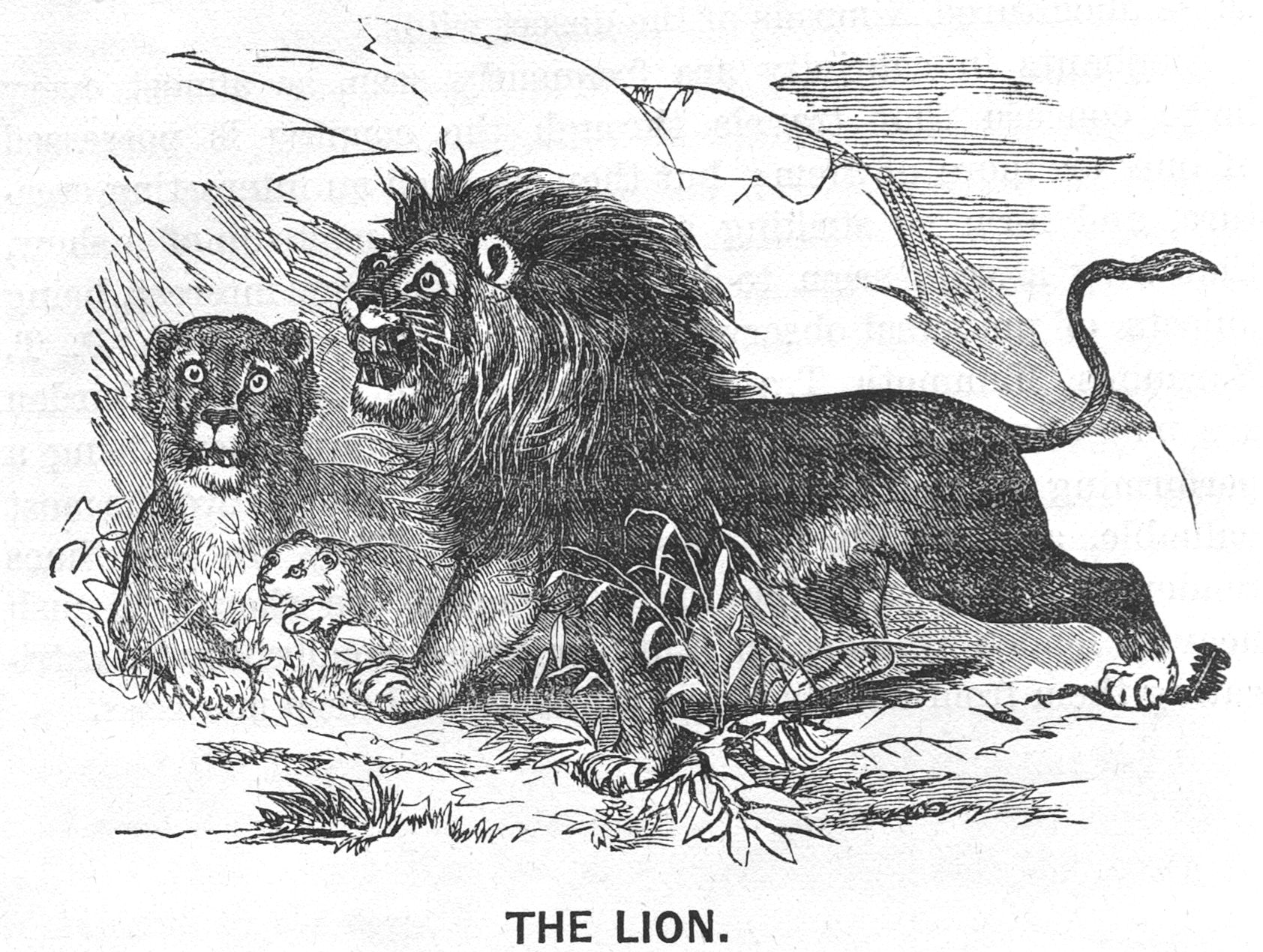
THAT majestic, yet terrible animal of the genus felidae, which walked before Adam in the Garden of Eden, and by him denominated Lion, is not, as is generally supposed, the "king" of wild beasts. Among the gradations of the animal kingdom, there is no other creature possessing more marked or diametrically opposite elements of character. If he is bold, fearless, and fierce, making "night hideous" with his howling thunders, and shaking the earth with his awful and terrific roars, so, on the other hand, is he one of the slyest, most timid, stealthiest, and most cowardly of the feline species. Physiologically, he is a most powerful animal. His iron teeth and jaws are not adapted to the grinding process for masticating food. The lower jaw is so largely developed at the base, and fits so deeply into the socket, that lateral motion is impossible. He has four massive spike-teeth, or incisors, two above and two below, by means of which he seizes his prey, and, after a fearful laceration, swallows his food in ponderous chunks, without stopping to masticate it or regard even the necessities of his fellows. The vertebrae, ribs, and hip-bones are so exquisitely wrought together as to unite a graceful flexibility of movement with great muscular power. The average height of the larger specimens is four to five feet, and its length from nine to eleven feet. From the fearful anecdotes told in illustration of his superior strength and prowess, it is not to be wondered at that enthusiastic naturalists have denominated him "king" of the brute creation. ‘This notion, however, has, of late years, by experienced Asiatic hunters, been controverted. In many instances, the large royal Bengal tigers are found to be his superiors. The Lion is nevertheless, a magnificent and noble creature, well deserving his royal title - rex animalia. It has generally been supposed that there are several varieties of the Lion. But the later investigations of eminent naturalists have demonstrated the fact that there is, in reality, but one species, modified into permanent varieties, according to the country and climate in which it lives. The finest specimens of the known varieties are found in the scorched and desolate regions of the torrid zone, in the deserts of Sahara and Biledulgerid, and in all the intermediate parts of the vast continent of Africa.
In these desert regions, from whence mankind are driven by the rigorous heat of the climate, this noble animal reigns supreme - monarch of all he surveys. His disposition seems to partake of the ardor of his native soil. Inflamed by the influences of a burning sun, his rage is tremendous and his courage undaunted. The color of the Lion is a tawny yellow, while upon the belly impinges a soft, beautiful light, making a harmonious contrast with the darker hues upon his back and shoulders - in some of the varieties bordering on black, as it becomes more or less blended with the thick shaggy mane of the male. The ears are blackish, and the caudal extremity is decorated with a long thick tuft of black hair, which distinguishes the Lion from all other members of the cat tribe. The Lioness is about one-fourth smaller than the Lion, and has no mane of any pretensions.
Among the collection which has been sent to Mr. Barnum, by his agents in Europe, are two Royal Babylonian Lions, and a pair of beautiful Black-maned Lions, the second pair ever imported, and, as far as we know, the only Black-maned Lions now in America. The color of the eyes is always the same in all the known varieties, being a of bronzed, yellow, with black dilating pupils, and, when excited, or viewed in reflected light, have the flash of fire in them perfectly appalling. The same sleepy, indolent habits which characterize the Felidae in general, is remarked in an eminent degree in that of the Lion. If those known to naturalists as "man-eaters," and which the poor Kaffres so much dread, are apparently more formidable than any others, itis attributable to this laziness and indolence in supplying themselves with necessary food, more than to any distinguishing attribute of their physiological conformation; because the genus homo is an easier prey to capture than many of the more fleet or ponderous quadrupeds of the mammalian race.
The Hottentots and Kaffres are themselves but a step in advance of the brute, as they slay their fellow-beings with the most barbarous inhumanity. Ofttimes they leave the dead bodies of their victims, what they do not eat themselves, to rot in the jungles, or their bones to bleach beneath the arid sun of the desert wilds. The Lion which passes by these dead bodies - if the hyenas, jackals and vultures have not already devoured them - will satiate himself upon their flesh; and, once he tastes of the caro humanus, it is not to be wondered at if he grows ravenous in his depredations upon neighboring tribes, and eventually becomes classified as a man-eating Lion. The truth is, there is no such distinction, for all the species alike will, if interfered with or driven by necessity, devour a human being as quickly as any other kind of prey.
As near as we are able to determine, the average age of the Lion is about thirty years, although he has been known to attain to nearly twice that period. He arrives at maturity in about five years. The length of the mane increases in the male until he is twenty years old; after that time it begins to fade and lose its lustre and brilliancy.
The Lioness usually brings forth her young in the most retired and inaccessible retreats, and, when disturbed, will defend her whelps to the last extremity. In her anxiety to provide for the wants of her little ones, the Lioness will scour the country in every direction, and, at such times, becomes more fierce even than the Lion himself, and has been known to perish in her desperate efforts to secure necessary food. - The old lion perisheth for lack of prey, and the stout lion's whelps are scattered abroad."–JOB iv. 11.
Great efforts have been made to domesticate the Lion, but without success. You might as well attempt to change the spots of the leopard. The method of capturing the Lion differs according to circumstances or locality. The old ones are taken by means of a pitfall, kraal, or kloof; but the most successful method is to hunt them in their lairs, and, after dispatching the old ones, to rob the young whelps which are "scattered abroad."
The habits of the Lion and the Lioness afford many spirited and ofttimes sublime metaphors to the sacred writers, and give to the Hebrew poets some of the happiest allusions and inspirations found in the Old Testament scriptures. The "Lion of the tribe of Judah" is one of the sublimest sentiments in the entire apocalyptic vision. "Behold, he shall come up like a lion from the swelling of Jordan." - JER. i. 44. Isaiah, describing the happy time of the Messiah, says, "the leopard shall lie down with the kid, and the calf, and the young lion, and the fatling together; and a little child shall lead them." "The lion hath roared, and who shall not hear." "The king's wrath is as the roaring lion." Solomon says, "A living dog is better than a dead lion," - showing that death renders those contemptible who are otherwise great, powerful, and terrible. "Then went Samson down, * * and behold, a young lion roared against him. And the Spirit of the Lord came mightily upon him, and he rent him as he would have rent a kid, and he had nothing in his hand."–JUDGES xiv. 5,6. Parallel passages multiply upon the mind, but, fearing the danger of prolixity, we forbear.
THE RHINOCEROS. (Rhinoceros Unicornus.)
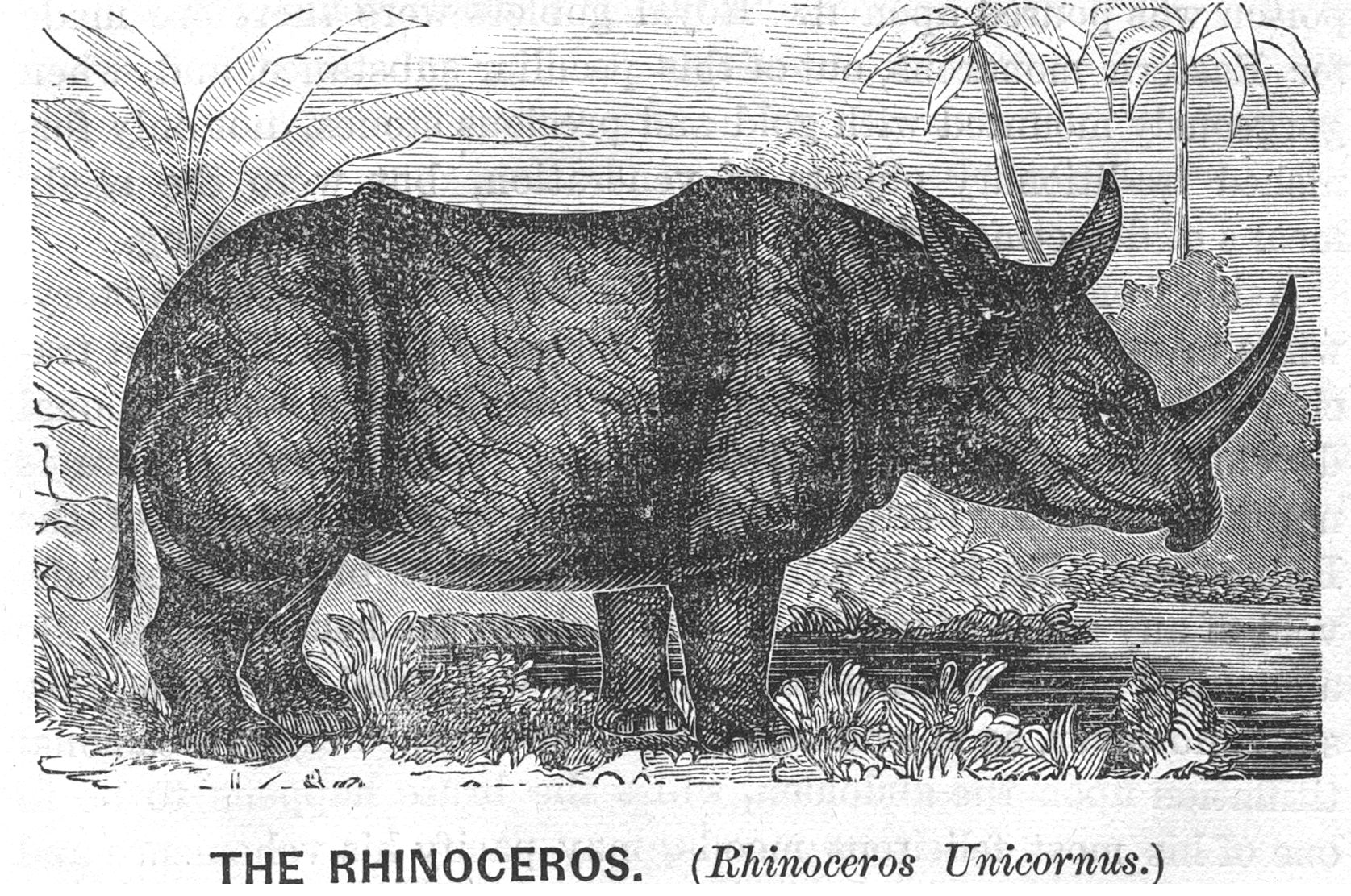
THE Rhinoceros is one of the most remarkable of the pachydermatous mammalia, closely allied to the elephant, tapir, and the hippopotamus. There are several varieties still extant, many of the earlier species having become extinct, which can only be recognized by their fossiliferous remains. There are two or three species found in Asia, Sumatra, and Borneo, while there are several inhabiting the various portions of Africa.
There are a few characteristics common to all the varieties of this remarkable group: one is the almost uniform conformation of the body, excepting size, and the other is the horny projection from the nose, the Indian Rhinoceros having but one, while the African varieties have two. This so-called horn is of peculiar structure, and is no way connected with the skull. It seems to be developed exclusively from the skin, and belongs to the same rank as the hirsute, bristles, spirus, and quills of other animals. They grow with the development of the animal, until they become long, sharp, and inflexible, capable of doing fearful execution as a weapon of aggressive or defensive warfare. If closely examined, these cornia will be found hard and smoothly polished at the tip, while the base is rough and split into innumerable filaments, constituting a kind of cushion to soften the concussion caused by its frequent onsets with its enemies. In the days of Pliny (Historia Animalia), a notion obtained that the substance of which the horn of the Rhinoceros is composed possessed a sure antidote for poison, by causing effervescence whenever a liquid poison was poured upon it. Royal goblets were therefore made for Eastern monarchs, out of this peculiar substance, and, when gorgeously mounted with gold and precious stones, not only furnished traditionary objects of veneration, but were the ready means of detecting attempts to administer any deadly drug.
Aside from the interest inspired by the study of natural history, while investigating the diversified forms of animal life, and tracing the analogy which exists in the physical and constitutional development of the aggregated forms of the mammalia, there is nothing peculiarly inviting in the appearance or manner of the Rhinoceros. He is an ugly and disagreeable brute, utterly devoid of any sense of gratitude, and irate to the last extreme. No amount of good treatment or caressing will avail with him. Possibly, however, as is evidenced in the swine species, an occasional titillation upon the abdomen, while the brute happens to be in one of his most felicitous moods, may pacify his vehemence and cause him, for the time being, to passer hors de lui-méme, or forego his habitual penchant for mischief, being constitutionally bellicose. On looking at him for the first time, the first thought that suggests itself is the striking similarity between the Rhinoceros and an overgrown hog, or the vlacke vark. They both belong to the same generic class. One has just about as much intellectual sense as the other, and both will habitually "return to their wallowing in the mire." There is, however, an instinct of jealous gallantry even in this thick-skinned monster; for, like the elephant, buffalo, lion, and other animals, during the season of "wooing" he becomes vicious, concealing himself in the midst of the thick jungles, whence he dashes out suddenly and attacks every object that comes within his reach. In every species, whether of the unicornus or bicornus varieties, the Rhinoceros is defective in sight, from the fact of his not being able to see objects perfectly, in front of him, so deeply are his eyes set in his head. This discrepancy, however, is more than compensated in the fact of his superior acumen in scent and hearing, warning him of the approach of danger.
The skin of the Rhinoceros is very thick, capable of resisting the force of an ordinary bullet. In the Asiatic species, the heavy flabby folds in which the skin is gathered hang massively over the shoulders, throat, flanks, and haunches, which give the animal a very rough, uncouth appearance. The skin upon the abdomen is comparatively soft, which, like the heel of Achilles, seems to be the only vulnerable point of attack. The horn of the Indian Rhinoceros is not so long nor well-developed; yet, even with this short weapon, he is capable of doing fearful execution in ripping up the earth and defending himself against the onsets of the largest elephants, against many of which he is represented, by experienced hunters, to be more than a match. The average height of the Rhinoceros is about four feet, although they have been known to attain to six feet. Its color is dark purplish brown, approximating, in some of the Borele varieties, to a deep black.
There is a white species of the Rhinoceros; but, like the white elephants, they are objects of religious veneration on the part of the inhabitants. It is considered an ill-omen when one of them is permitted to be carried into captivity. Mr. Barnum, conscious of this fact, tried for many years, when he owned the old Broadway Museum, to obtain these varieties, but could never succeed, notwithstanding the fabulous prices (in gold) offered to overcome the scruples of those superstitious natives. King Ava, who glories in the title of ‘‘Lord of the White Elephants," generally monopolizes every white elephant and rhinoceros in his domain, as he employs them, especially the former, in state processions and parades, decorating them with rich ornaments of gold and priceless jewels, quartering them in the most magnificent houses of state - their eating-troughs being made of solid silver, decked with gold. This will account for the fact that none of these white varieties, either of the elephant or rhinoceros, have ever been imported into this country. Mr. Barnum, in December last, offered $25,000 each for a white elephant and rhinoceros, safely landed on the dock in New York City; and he hopes, therefore, through the influence of his personal friend, Lord Bright, whose son is en bon rapport with the royal court of the "Lord of the White Elephants," to be able to gratify the curiosity of his American friends, although at a fabulous price, by affording them an opportunity of seeing the first white elephant and rhinoceros ever witnessed in America.
BEARS. (Ursidae.)

THERE is no class of animals of which more that is interesting might be said than that of the Ursidae, or Bear family. Their history, habits, forms, and characteristics are inwrought in the mind of people everywhere. There is no child, however unenlightened in other matters, but has seen or knows something concerning "Old Bruin." Already crowded for space, which must grow "small by degrees and beautifully less," the reader will accept as an apology a bare mention of this interesting subject.
The family is not so large in variety as it is wide in extent. It is a native of all climes, and will be found, in some of its varieties, in all parts of the earth. From the hot sands of Borneo to Nova Zembla, from the Arctic regions to the pampas of Central and South America, in the British possessions, California, and Mexico, will this artful and frolicsome creature be encountered. In its natural condition the Bear is comparatively harmless, is capable of domestication, and becomes playful in its frantic comicalities. But, if driven to close quarters, or desperation from hunger, or the female becomes robbed of whelps, then it is becoming to "stand from under," for there are few Davids who are able to defend either themselves or their flocks and herds from its ravages. During five months of the year there is but little seen of Old Growler, that is, of the American varieties, as he goes into winter quarters and remains in a state of indifferent stupor, requiring no food of any amount, coming out in the spring-time fat and "sleek as a bear."
Among the varieties known to naturalists are the Black Bear, Brown Bear, Grizzly Bear, Thibetan, Malayan and Bornean Sun Bears, Sloth Bear, Cinnamon and White Polar Bears, Poonah, or Large-lipped Bear, etc. These differ in size materially, but in their essential characteristics never. Their food is composed of vegetables, nuts, fruits, insects, saccharine and animal matter – being both herbivorous and carnivorous. The Bear is often spoken of as a fierce, savage animal; but we think, with very few exceptions, the imputation is unjust.
Many years ago, when Western New York was a vast wilderness (the story was told me by an eye-witness, a lady of seventy years), a gentleman and two ladies started in a skiff to cross Seneca Lake, from the vicinity of Rock Stream. When about half-way across the lake (five miles wide), they discovered a large Black Bear making with all speed for their frail little bark. Of course, all were greatly frightened. The gallant young oarsman plied himself lustily, but to no purpose. The monster made for the bow of the boat, the ladies for the rear, when, to their amazement, old Bruin clambered up the side and seated himself in self-composure, and remained dignified and quiet until he reached the other shore, where he disembarked and made for the forests. He had been enjoying a summer's bath, became fatigued, and was too glad at the prospect of a safe passage over the cerulean bosom of that lovely lake. It is only when driven by necessity that the Bear becomes savage or dreadful.
Many expressive metaphors have been furnished by the poets of Palestine, from the well-known habits of this interesting animal. "Let a bear robbed of her whelps meet a man, rather than a fool in his folly.". - PROV. xvii. 12. "I will meet them as a bear that is bereaved of her whelps, and will rend the caul of their heart." - HOSEA xiii. 8.
POLAR BEAR. (Thalarctus Maritimus.)
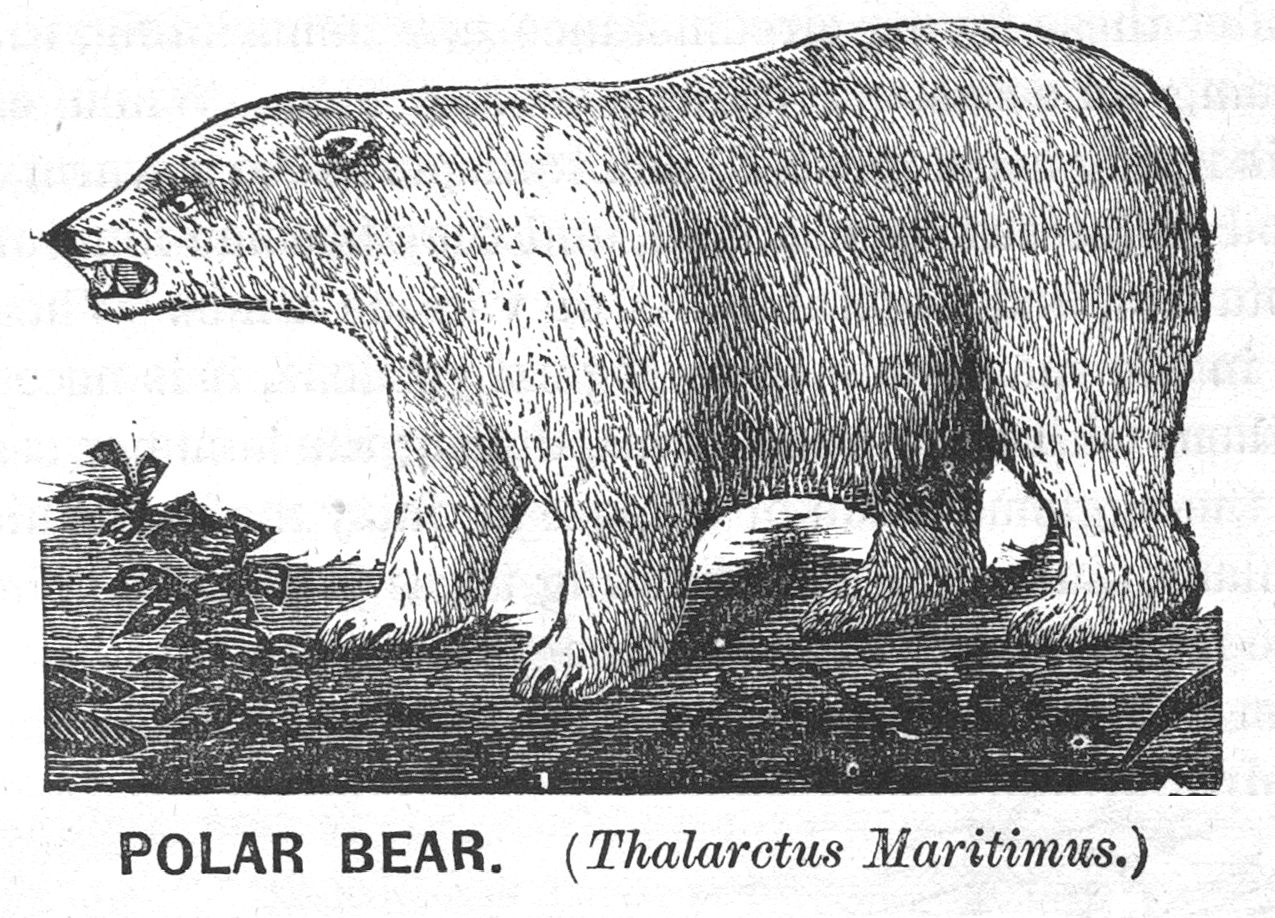
THERE can be no question as to the unity of origin and homogeneity of the genus ursus. If there be any exception, it might be, urged in favor of the Nennook, or White Polar Bear, whose neck is a little longer, its skull flatter, and the feet longer, which are covered with fur on the bottom. This slight difference, however, is attributable to change of climate and food, and accords with the wisdom and economy of a Divine Providence. It is a fact in zoological science that, among vertebrates and crustacea, some members of each group partake of maritime or aquatic habits. The Polar Bear is an illustration of this principle. In the cold, desolate, barren habitations of the Arctic regions, where this animal is found, it feeds on fish, seals, and deer, and what little vegetation may chance to grow. In order to capture the seals, walrus, sea-dogs, and fish, it is forced to plunge into the sea, and swim or dive for its prey; to do this successfully requires certain aptitudes, and God has mercifully granted these in lengthening his feet, diminishing the head, and pointing the nose, in order that he may propel himself through the water with greater facility; while the fur upon the bottom of its feet enables it to stand firmly on the slippery ice, and protects it from the piercing cold. According to Drs. Hall and Kane, who have thoroughly explored the Arctic country, these solitary representatives of the ursine race, in that rigorous clime, are often carried out for many miles to sea on the floating cakes of ice. Their powers of endurance under these trying circumstance are remarkable, their only relief being an occasional seal or a stray fish. When captured (which is rarely accomplished) and transported to a warm climate, their food is necessarily changed, and they become fond of bread, milk, potatoes, and vegetable diet of various kinds. When on exhibition in the menagerie or zoological gardens, it is necessary to supply them with mountains of ice, during the summer season, to prevent the agglomeration of adipose or fatty matter, which lines the cellular tissues. Notwithstanding these precautions, however, there are few of them kept any length of time, and they therefore often become subjects of the skilful taxidermist. The specimen in Mr. Barnum's collection is one of the largest in the country.
THE TIGER. (Tigris Regalis.)
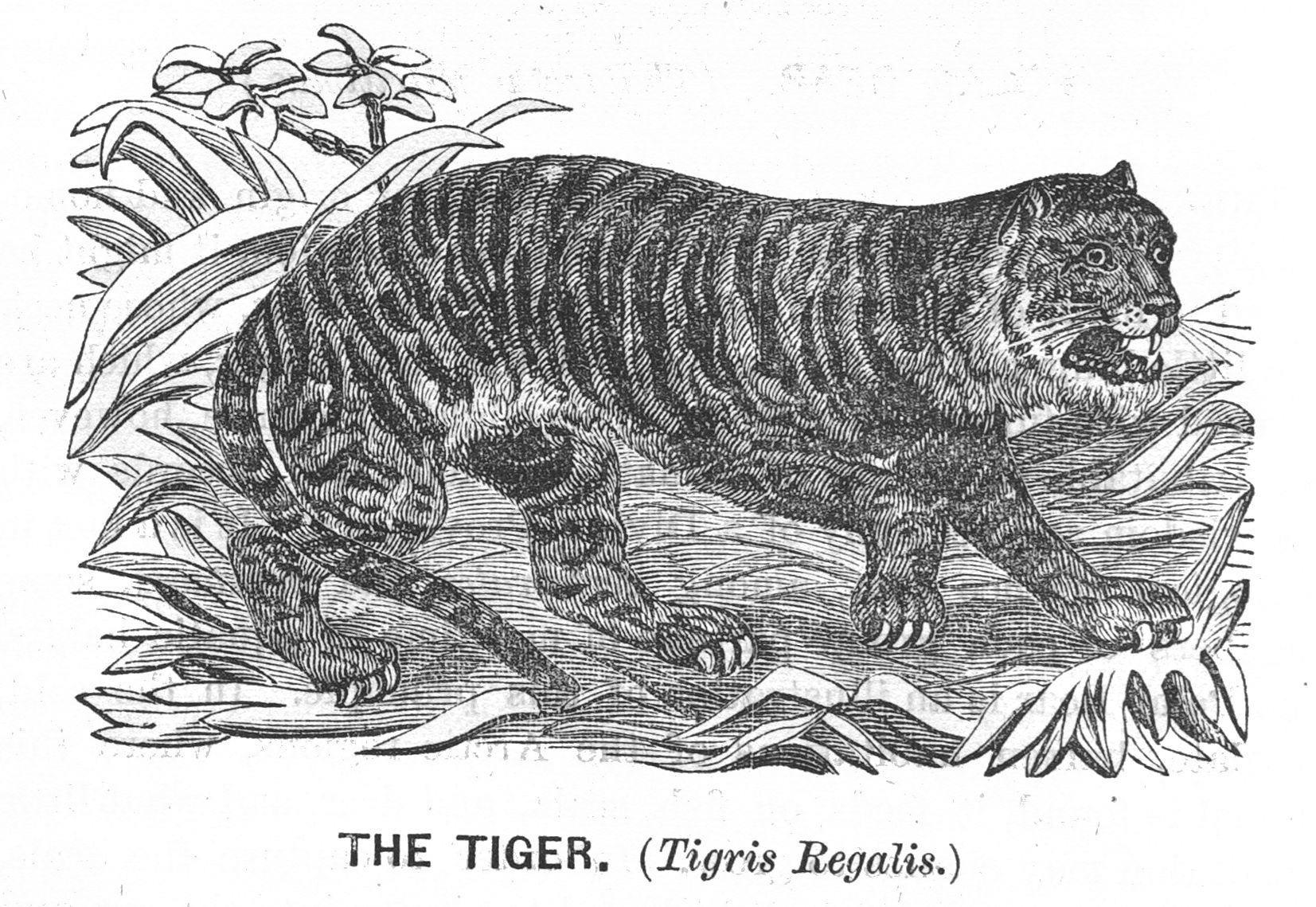
THE TIGER is one of the most beautiful of the feline species. In strength, prowess, and agility, it exceeds even the lion; while the softness of its exquisitely marked fur, the gracefulness of its form. and its supremacy over the beasts of the Asiatic jungles, have won for it the distinguished title of royalty. The Tiger is never found in any other country save that of Asia; and in Bengal, it sustains the same relation to other animals as the lion does in Africa - that of sole monarch over the kingdom of animated nature. Upon a magnificent groundwork of bright tawny-yellow is mathematically arranged, nearly at right angles, a series of dark stripes, some single and others double, suggestive of the beautiful stripes of the zebra, which distinguish it from all other varieties of the tigrine carnivora. It varies in length according to climate and condition, the largest and finest specimens being thirteen feet from tip of nose to tip of tail, and about four and a half in height. The vertical stripes upon the body harmonize with the weird and dusky grass of the jungle, so as almost to defy detection by an approaching enemy. Behind these vegetable tufts, or under the broad expanding shrubs of the korinda, the Tiger conceals itself, and watches for the first opportunity to pounce upon the unsuspecting prey. Experienced tiger-hunters are in the habit of supplying themselves with a dress having a tint similar to the warm reddish-brown assumed by the dried multiform leaves of the jungle. With this dress they amalgamate, chameleon-like, with the seared palms and shrubs with which they are surrounded, and thereby ofttimes escape the observation of the Tiger's sight. Should his keen, penetrating eyes, however, detect a human being clothed in these tawny habiliments, he becomes suspicious and turns slowly away, not being able to comprehend the meaning of so strange an object. In contradistinction to the well-known habits of all other animals, which are so careful in regarding and protecting their offspring, the Tigress, on the apprehension of danger, suddenly converts her young family into a pioneer band, and sends them out ahead to do picket duty, while she cautiously follows on behind, not the "shadow," but the substance of "coming events." Familiar with these habits, the hunters will allow the cubs either to pass on undisturbed, while they reserve their ammunition to make war on the mother, or will capture one or more of the little whelps, and carry them off into captivity.
The Tiger is not an open, but a dangerous foe. Like the lion, it will stalk an unconscious prey, whether it be man or beast, stealing silently and treacherously upon the unwary victim, preferring a woman or a helpless child for the object of its attack. The localities most frequented by this insidious "terror" of the human kind, are the crossings of nullahs, or the silent ravines through which the water-courses run.
The Tiger is possessed of enormous paws. These are loaded The Tiger is possessed of enormous paws. These are loaded with long, sickle-like talons, with which they deliver a rapid succession of blows, cutting like so many sharp knives, which enable it to strike to the earth the largest animals known to zoology. They have been known to kill and devour the largest ox before abandoning it. They are voracious eaters, preferring the fresh, warm blood as it flows from the wound, and rarely leave a carcass, until devoured, unless driven away. There are several so-called varieties of this animal, usually classified by naturalists as the Bengal Tiger, White Tiger, Brazilian Tiger, and the Jungla, etc. But these distinctions exist more in name than in reality. There is no such animal as the Brazilian Tiger. This unique genus of the cat tribe exists only in Asia. What is commonly described and exhibited through the country as Brazilian Tigers are a nondescript or mongrel, between the American jaguar and puma. Those called White Tigers are mere albinos. The tigrine stripes have become less distinct, through climatic and other influences; the color is partially changed to a creamy-white; but they cannot, upon any principle, either of habit or anatomy, be ranked as permanent varieties. As articles of commerce, the skin, teeth, and talons of the Tiger bring a high market value. The utter extinction of this race of animals is greatly apprehended. Legislation and religious scruples have been the only means of perpetuating his existence. A strange polytheistic mythology has clothed this animal with a sacred mantle, so that it requires much nerve and enterprise to be able to secure them as specimens of zoology to be placed on exhibition. Mr. Barnum has the largest Tigers ever seen in captivity.
Mr. Barnum encountered more trouble and expense in procuring his beautiful specimens than any one of all the animals in the collection. His agents in India engaged an army of Fakirs and Shikarries, who, with the aid of a herd of elephants trained for the purpose, succeeded in forcing a group into the jungles, which they entirely surrounded, and by a series of pitfalls, bamboo traps, and other devices for capturing these wily creatures, were enabled to secure alive, after a most desperate encounter, a pair of the finest Bengal Tigers ever imported. These will be viewed with great interest, as much for their beauty as the romantic manner in which they were captured for the great showman.
THE LEOPARD. (Leopardus Varius.)
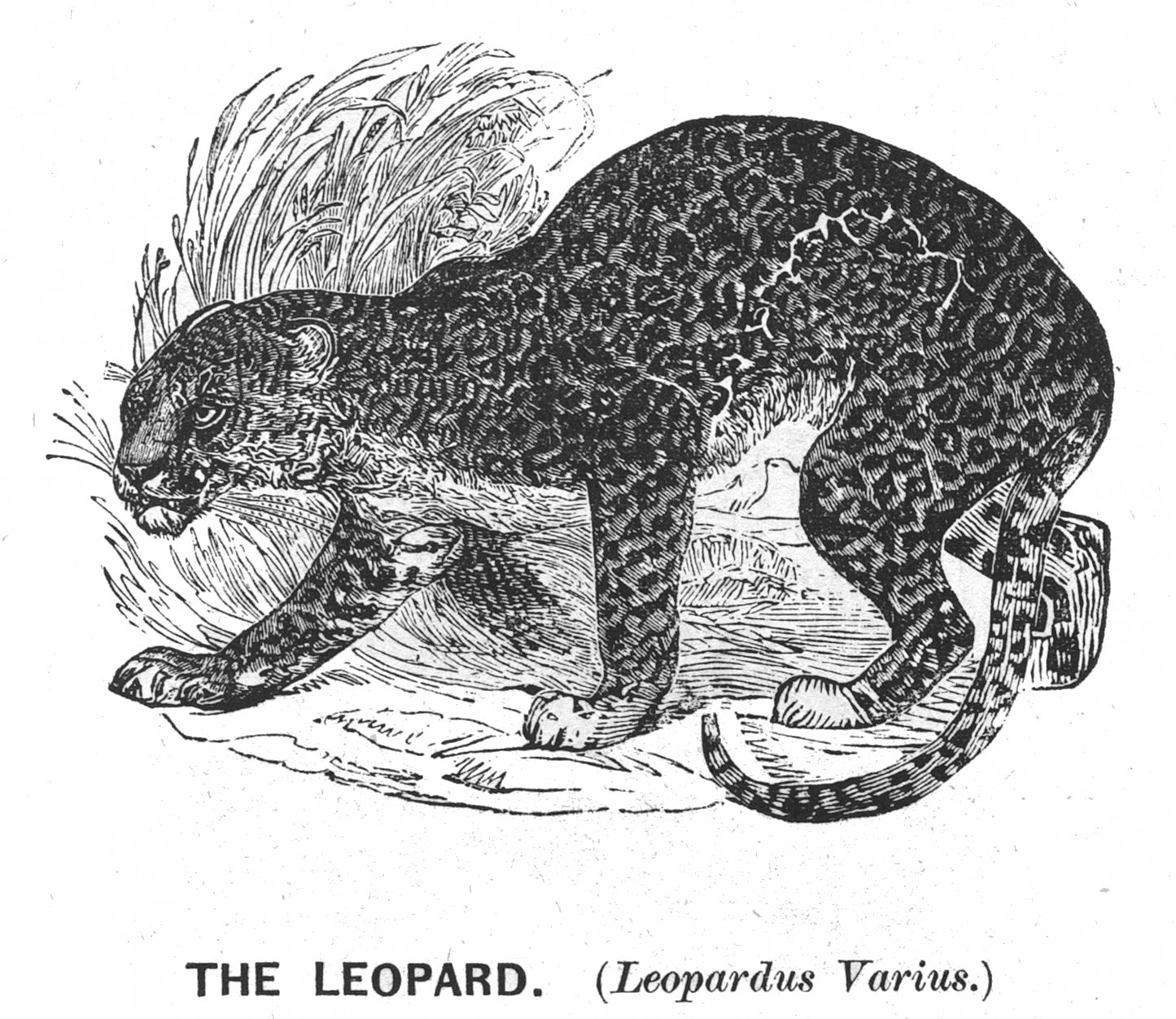
THERE is an essential and marked difference between the tiger, which is a native of Asia, and the Leopard, which is a native of both Asia and Africa. This beautiful creature is one of the most graceful and agile of the cat tribe. In its dimensions it is much less than the tiger; but in the markings of its skin, and the rosette-shaped configurations of its bodily covering, it is in every respect surpassingly lovely. In its anatomy it does not differ materially from the tiger, or any of its confréres in the Western World, such as the jaguar or puma of South America. But it is possessed of an accomplishment which neither the lion nor tiger can boast, - that of climbing and sporting in the forest-trees. On this account it is called by the natives of India Lakree-bang, or Tree-tiger. In Africa, this animal is sometimes mistaken for the tiger by those not versed in zoology. This will account for the "tales of adventure" by pseudo-tiger-hunters, who unwittingly lay the plot of their thrilling exploits with the tiger in that trackless region where no genuine specimen of this animal was ever seen! In Africa, the Leopard is much dreaded for its well-known habits of depredation among poultry, flocks, and herds. It will crouch among the thick branches of trees, watch an opportunity to seize birds, monkeys, or pounce upon the antelopes, elands, camelopards, and even human beings, which pass by the way. "Therefore will I be unto them as a lion: as a leopard by the way will I observe them."–-HOSEA xiii. 7.
The prophet alludes very poetically to the swiftness of this animal, while referring to that "hasty nation," the Chaldeans, whose horses "are swifter than the leopards, and more fierce than the evening wolves." - HAB. i. 8._
HUNTING LEOPARD. (Leopardus Praedens.)
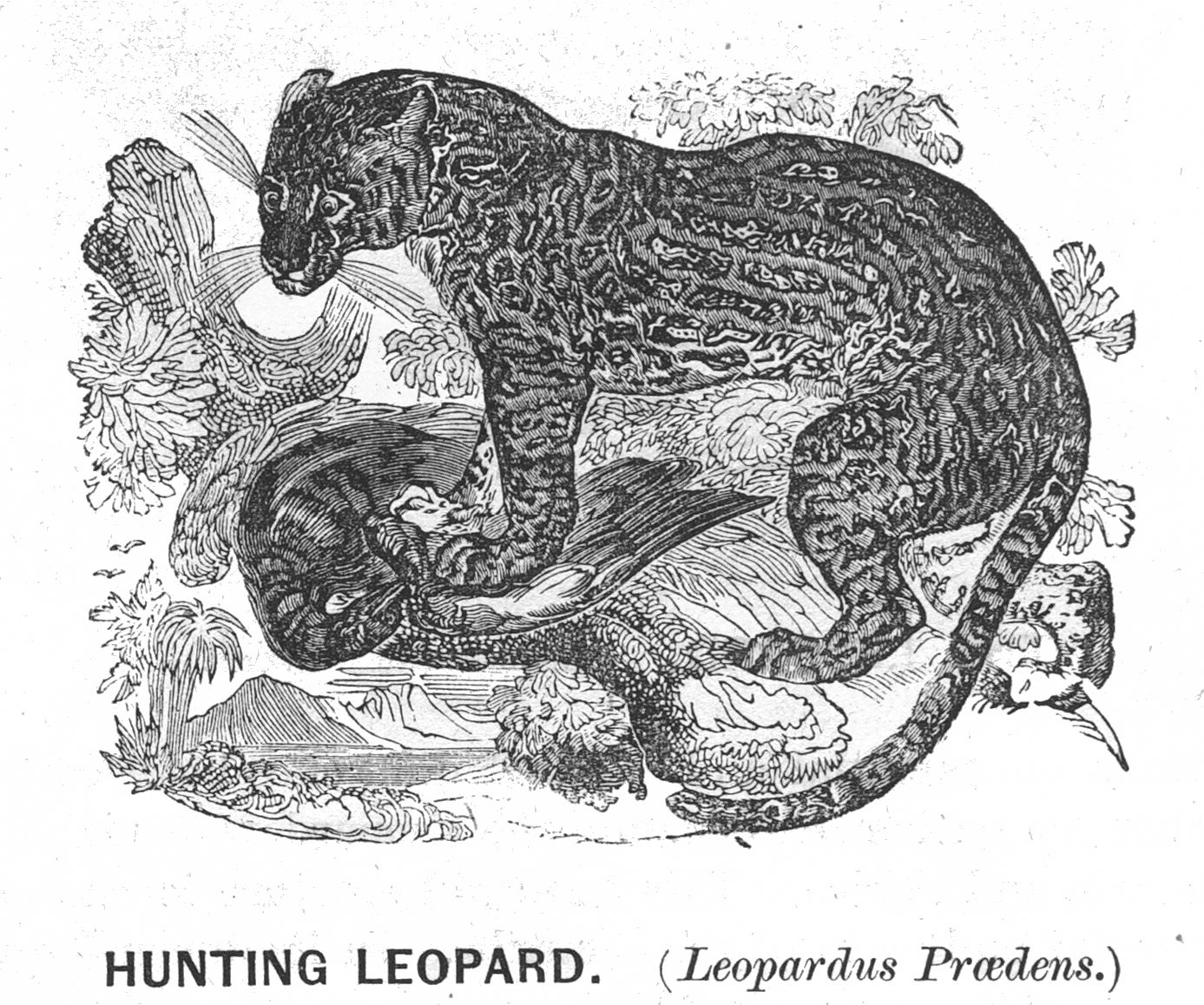
THERE is another kind of the Leopard family (somewhat apocryphal, I imagine) called Cheetah, or Hunting Leopard. Accordingly, however, to the best-recognized authority, there is substantially no distinction to justify the name. All varieties of which we have any knowledge are hunters; in fact, that is the distinguishing characteristic of the tribe. This beautifully-marked spotted creature has a very ancient history, and figures prominently, in consequence of his bright golden hues, in the Old Testament, forming some of the most beautiful similes of the Hebrew poets. According to Pliny and Jerome, this famous animal existed in large numbers in ancient Palestine. Bochart affirms that the name given to the Leopard was the same in Chaldean, Syriac, Arabic, and Ethiopic, which shows the estimation in which he was held by both sacred and profane historians of the olden time.
"Come with me from Lebanon, my spouse," says Solomon: "look from the top of Amana, from the top of Shenir and Hermon, from the lions' dens, from the mountains of the leopards." - ANT. iv. 8. "can the Ethiopian change his skin, or the leopard his spots?" - JER. xiii. 23.
Nimrod, the mighty hunter, is said to have derived his name from the Leopard. If this be so, the well-known predatory habits of that lawless freebooter, whose depredations were not confined to quadrupeds alone, may well be likened to the artfulness and treachery of the Hunting Leopard.
"Proud Nimrod the bloody chase began, -
A mighty hunter, - and his prey was man."
THE JAGUAR. (Felis Onca.)
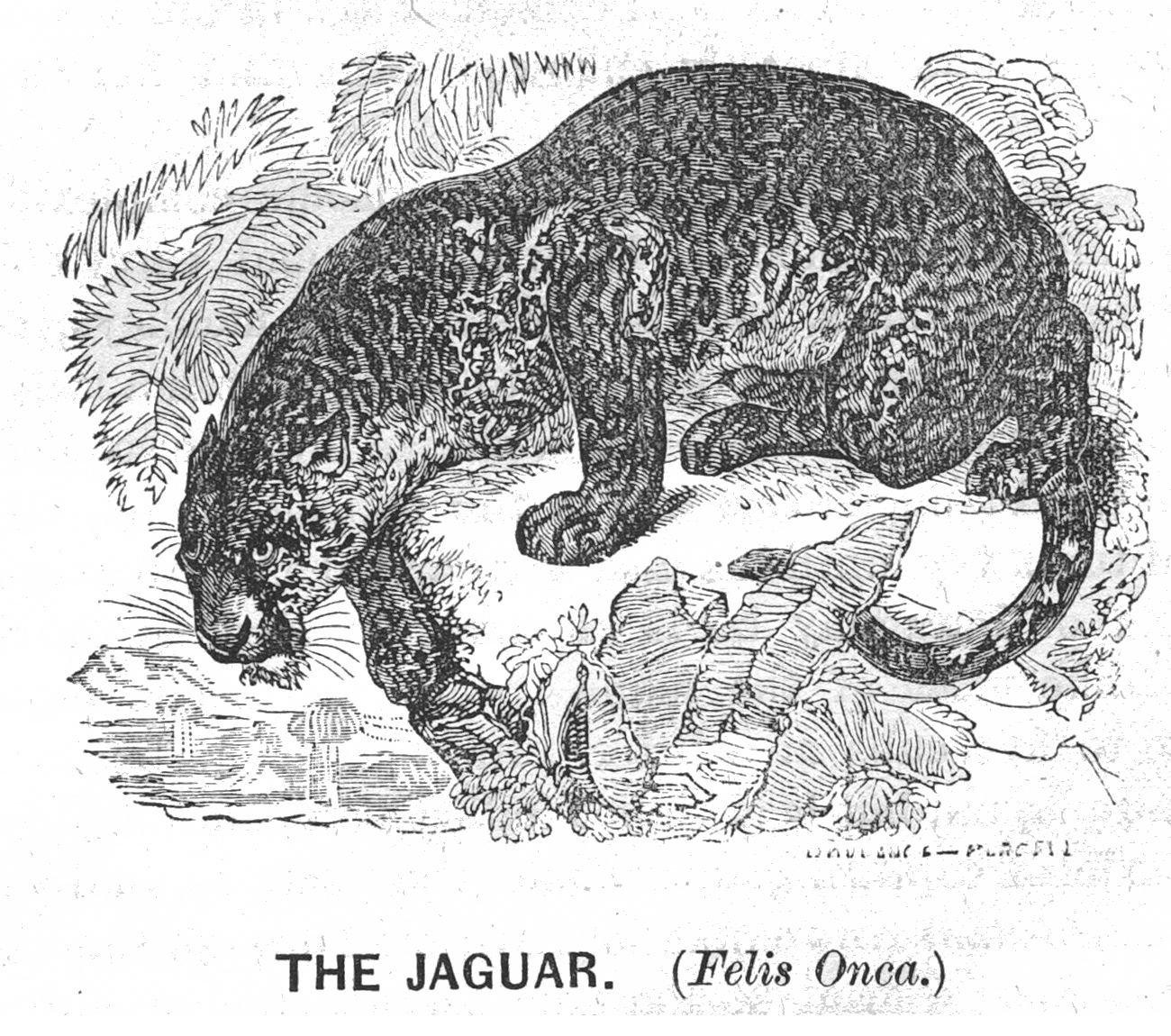
WE come now to speak of one of the most beautiful and interesting inhabitants of the forests in the Central and South American States. So nearly allied in external appearance is the Jaguar to his transatlantic relatives, that he has been denominated by some naturalists a leopard, by others a tiger. Those varieties found in Brazil, therefore, have been classified as Brazilian tigers, the absurdity of which has already been alluded to. The Jaguar is found only in the New World. It is larger than the African leopard, and, in its arborial habits - for it is an excellent climber - resembles its spotted cousin over the waters. The difference, however, between the American Jaguar and the African leopard is remarkable. The tail of the former is much shorter than that of the latter; while the angular-shaped configurations, or marks upon the skin, are larger in their proportions, and, on certain parts of the body, run in streaks and abrupt irregular lines. There is in the centre of these peculiarly shaped figures a small black dot or period, which seems to be placed there by the hand of the Great Limner, to terminate the sentence of effulgent splendors which are everywhere read in the tegumentary coverings of God's living poems. The color of the skin varies in different specimens; but the richness and beauty of the tint, and the softness and exuberance of the silken fur, make it extremely valuable as an article of commerce. Humboldt and Cuvier attribute the varieties of tints in animals to the amount of iron in the system, those of the dark-colored specimens - as has been demonstrated in the blood of the negro - being more liberally endowed with that health-giving element.
The Jaguar, notwithstanding his handsome complexion, is a terror to all his neighbors. He will seize and carry off many of the largest animals, such as horses, deer, monkeys, cabiais, tapirs, etc. He has been known to swim across a large river, kill a horse, drag him to the bank, plunge into the stream, dragging the dead animal with him to the opposite bank, up which he would tug away until his prey was carried off in triumph. In the plains of Paraguay he is as much dreaded as the lion in Africa. Like most of the feline species, the female Jaguar has from two to five cubs at a litter. In captivity it becomes very docile and playful, but is always handled with caution.
The mode of capturing it is about the same as that adopted by the Kaffres and Hottentots in Africa. Through the kindness of the American Consul at Paraguay, a personal friend of Mr. Barnum, he has secured some choice specimens of this interesting animal, and it is with pleasure we are able to announce their advent to the great zoological collection.
THE PUMA. (Leopardus Concolor.)
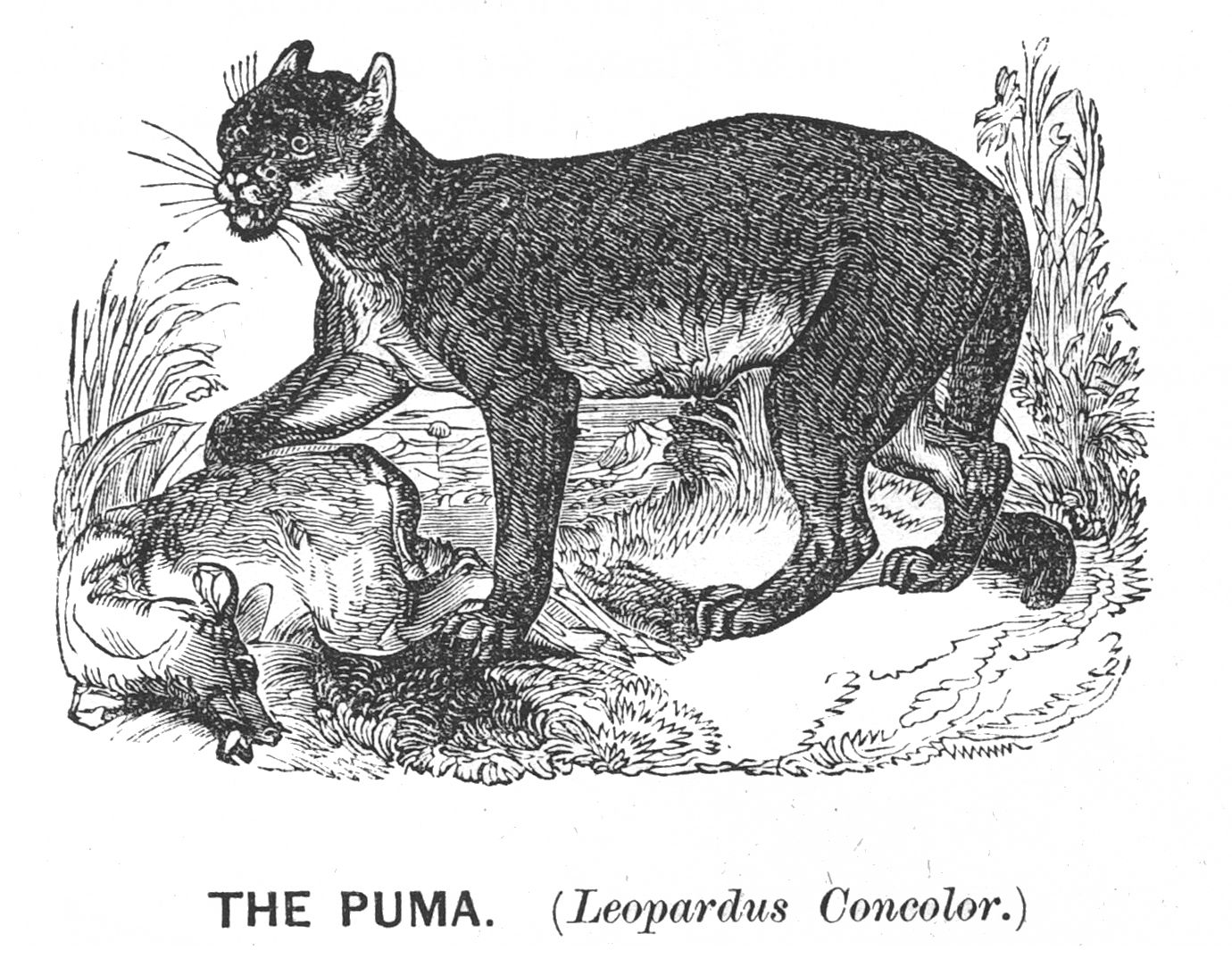
DIFFERING in its color and habits from all varieties of leopards heretofore mentioned, the Puma, on account of its generic ramifications, is a complete embodiment of diversity in unity. It is no compliment to this felis multis nominibus to say that it has been called a panther, carcajou, cougar, American lion, catamount, and "painter," all of which is not very creditable to our national claims to zoological science as illustrated in the history of the past. When viewed in the light of its external being, however, without the aid of scientific research, it is not remarkable that this animal appeared to our forefathers in all its diversified forms; nor is it strange that reports, legendary and unauthentic, should have obtained, investing it with so many titles. The tyro in zoological science, who, while undertaking to describe a certain animal, said it was "half horse and half alligator," is not altogether without a parallel, even in this advanced age of progressive thought and research.
The Puma is not so large as the jaguar, while its head, in proportion to the body, is considerably less in size. It is, nevertheless, a powerful animal, and, though not so resolute or aggressive, one to be avoided. Its total length is about six feet, and of proportionate height. It is a native of both North and South America, and subsists entirely by depredations, making frequent incursions upon neighboring flocks and herds, and has been known to kill fifty sheep in a single night. It is naturally cowardly when brought face to face with man, but quick to attack children. It is of a uniform (concolor) light, tawny tint, fading into a delicate gray, approximating under throat and upon the abdomen to a pure white. The limbs are large and disproportioned, not possessing that exquisiteness of outline observed in the leopard and jaguar. They are well adapted for climbing trees, where this animal spends nearly half its time, concealing itself so adroitly among the branches as almost to defy detection. The cabiai and peccary are its favorite prey, upon which it suddenly springs, and strikes to the earth by a single blow.
THE BLACK LEOPARD.
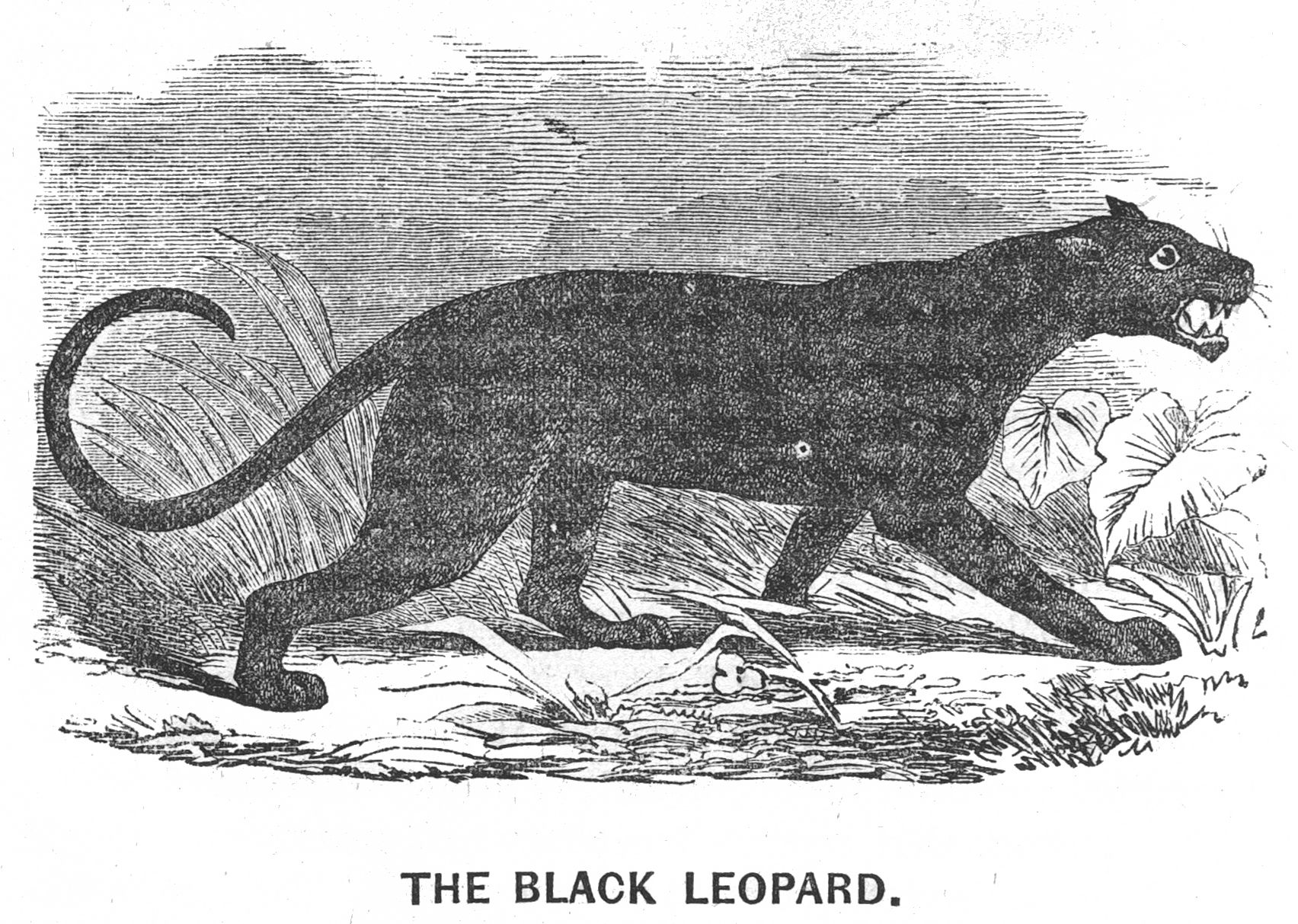
THERE is found in the vicinity of Java a species of leopard, which, from the darkness of its fur, is called by Pliny Felis Leopardus melas, that is, "Black" Leopard, or, by some naturalists, designated the Black Panther. There is, however, as has been observed in regard to the tiger, no justification for classifying it as a separate or distinct variety. The general groundwork of the silk-like integument with which the bodies of all the species are covered possesses a rich golden hue. This is heightened in its transcendent loveliness by comparison with the rich dark studding of the rosette-shaped spots which, at irregular intervals, dot its lithesome form. These spots are as changeless as the sable skin of the Ethiopian. There have been found a few hybrid specimens, crossed betwixt the Indian and African varieties, which, on first beholding, seemed to be almost black; but, on close inspection, never fail to reveal the ever-present pardine spots.
What is perhaps the most remarkable circumstance connected with this interesting animal is the fact that, while stroking his back in the dark, with the human hand, those faint outlines of rosette-shaped spots, which are during the day scarcely perceptible to the eye of the casual observer, gradually develop into regular pardine configurations of the most brilliant and lustrous hues.
Mr. Barnum, through the instrumentality of his friend, M. Du Chaillu, has succeeded in securing one of these beautiful, dark-colored creatures, which, I believe, is the second one of the kind ever imported or placed on exhibition in this country. About twenty years ago, Mr. James Raymond secured one of these curious specimens, but it was so badly injured, while being captured, that it died a short time after its arrival.
Noticing the accounts of the arrival of the Black Leopard, published in the New York papers, Mr. George N. Weston, son of a missionary to India, writing to Mr. Barnum from Stamford, Conn., says: "I congratulate you on its safe arrival. It is a very rare animal, even in India, and, as late as 1865, there had never been but three captured. I was in Calcutta with Capt. Isaac Parrington, of the ship ‘Golconda,' in ‘65, when one of these Black Leopards was brought there; and, after being exhibited for about a month, and seen by thousands, the Captain brought it to bring to this country, paying about twelve hundred rupees for it. The poor fellow, however, died of the mange off the Cape of Good Hope."
The engraving does not do justice nor does it fairly represent this choice exotic from the free and open zoologic fields of Central Java, whence he is so ruthlessly transplanted. In his habits he is identical with his African cousin, and seems to enjoy his captivity with perfect nonchalance. Some very interesting and amusing incidents are narrated by his captors, of this malapert pet, but we lack the space to give them here.
THE CAMEL. (Camelus Arabicus.)
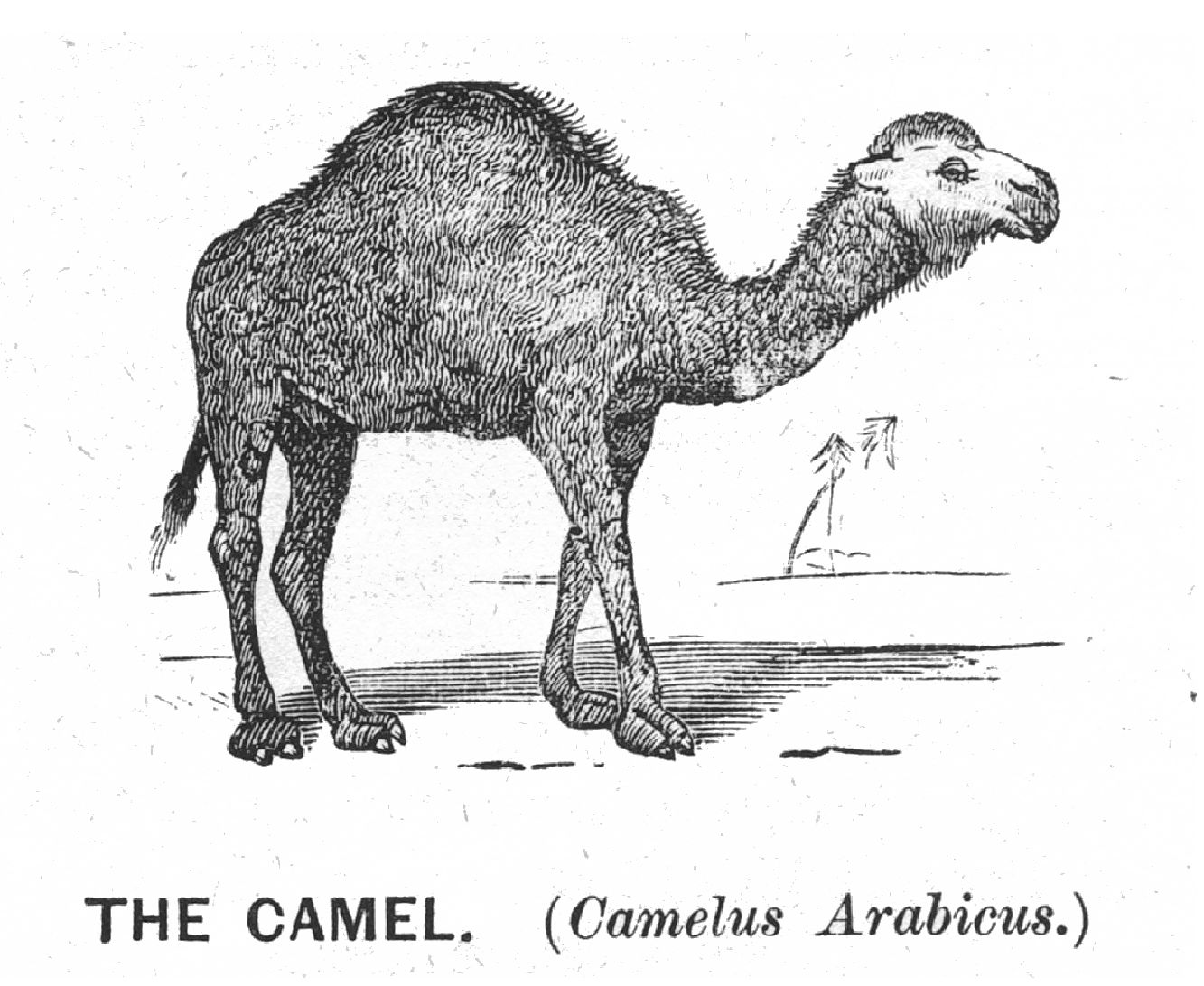
THIS animal seems destined by nature to fill a very important part in the affairs of mankind. Its height ranges from six to eight feet. Upon the back of the Arabian Camel is a single large adipose excrescence, called hump; upon that of the Mecheri, or Bactrian Camel, there are two humps,–these being the leading characteristics which distinguish the two species. The color of the single-humped animal is a light brown, with occasional variations of shade, from dark to a dirty white. Among the Bactrian or double-humped species, these variations are more marked in contrast, occasionally there being found one almost white. The one belonging to this Menagerie is of this description, and, with a single exception, the only one of the kind now in the country.
The Dromedary, though not a separate variety, differs somewhat from the common Camel. It is not so large or so well adapted as a beast of burden, but is very fleet of foot, and ordinarily used to make rapid transits across the arid sandy deserts of Arabia. The unusually large herd of Camels exhibited in Mr. Barnum's collection were purchased, a few years ago, from King Theodorus of Senegambia, taken by Mons. De Lesseps to work on the Suez Canal, and, at the conclusion of that gigantic enterprise, sold to Mr. Barnum's agents in Europe at an enormous price; whence they came in healthy condition, inured to hard toil, and well adapted to the purposes of long drives and constant travel, to which they are subject while making a tour of the country in connection with a zoological institute on wheels.
Camels are very intimately connected with ancient history, sacred and profane, as they figure conspicuously in the affairs and wealth of oriental princes in all the past. Job is said to have had three thousand; while the sons of Reuben captured from the Hagarites, in one battle, fifty thousand of these useful allies. They have often been used in war, to carry the baggage of oriental armies, and even to mingle in the bloody tumult of hand-to-hand combats.
The White Bactrian, or two-humped species, which are very rare on account of their color, are objects of great veneration among the Arabians, from the supposed relations they sustain to Damordara, one of the divinities of pantheistic mythology. Like the white elephants, they are so highly esteemed as to be almost impossible to procure for expatriation, with a view to place them on exhibition, either in Europe or America.
The hair of the Camel is very useful and valuable as an article of commerce. Cloth made from this material was worn by the ancient prophets and princes of Israel. John the Baptist appeared in Galilee in a raiment of camel's hair, made after a coarse and rude manner, in striking contrast with those who dwelt in palaces and wore "soft raiment" As the Camel was intended to traverse the unproductive and parching sands of the desert, Nature seems to have adapted the animal to the climate in which it exists. Its head, neck, and body are long and almost devoid of flesh. The legs are large and muscular, supported by very large, broad, elastic hoofs or feet, while the body is withered into proportions narrow and economic, provided internally with a "reticulum" of honey-comb cells, in which a large quantity of water may be absorbed, sufficient to endure the deprivations of a transit across the dreary desert.
THE OUNCE. (Leopardus Uncia.)
THIS animal differs materially from other varieties of the feline species. It is a native of Asia. The specimens engaged by the proprietor were captured near the Persian Gulf, and they are expected to arrive in time to join the menagerie some time in May or June. In general appearance the Ounce resembles the leopard. Its fur is much longer, and the rose dots less distinct. It inhabits the mountainous regions, its long bushy fur qualifying it to endure the rigors of a colder climate than that of the leopard. The color of its body is lighter than the latter animal, being of a grayish white, with a slight tint of yellow.
THE AFRICAN ZEBRA.
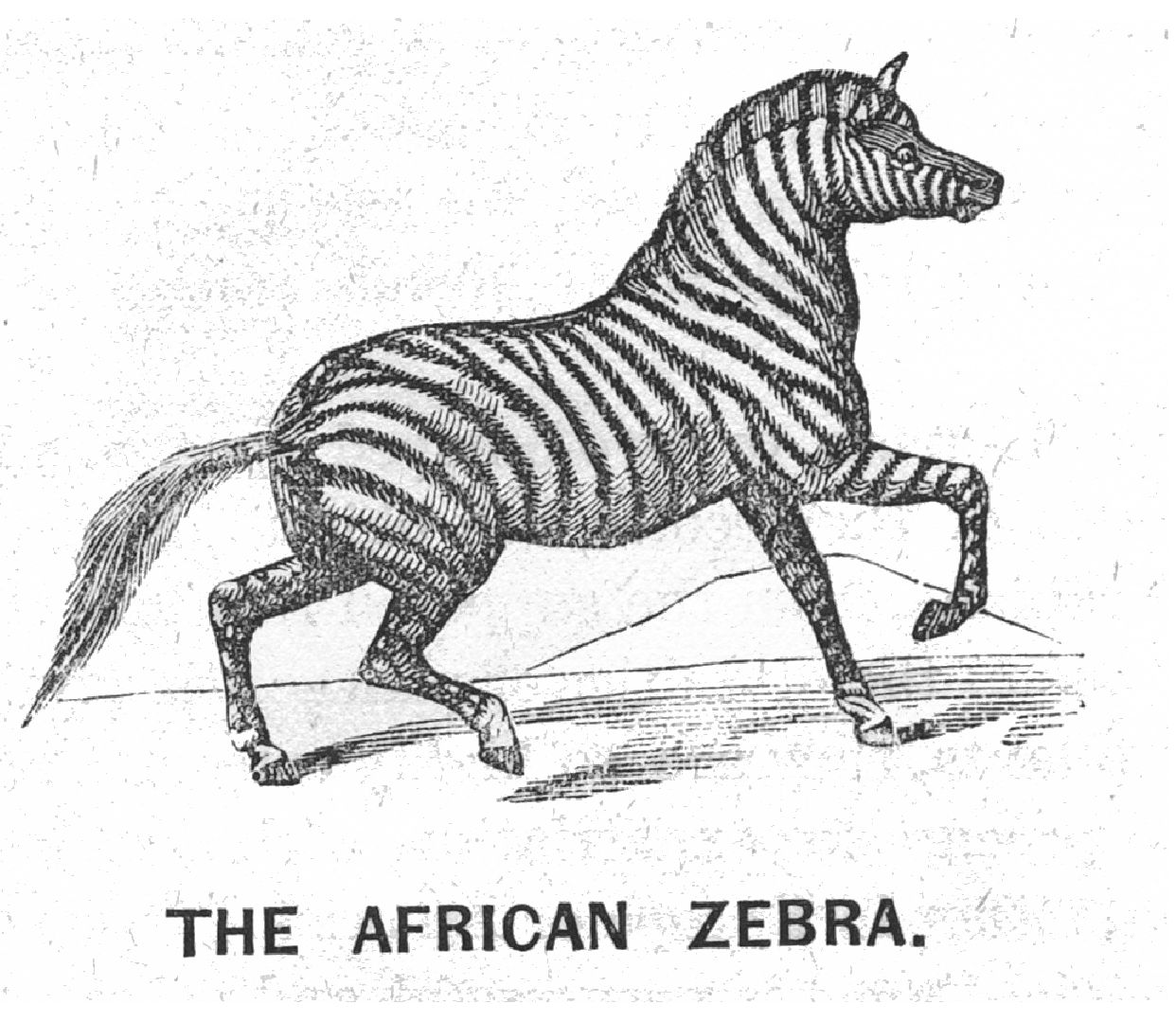
THE Zebra is one of the most conspicuous and exquisitely marked of the hippo-asinine tribe. Nature is very profuse, if not partial, in her tegumentary pencilings and elaborations among certain of the species, the Zebra being highly favored in this respect. Upon a groundwork of creamy white, the broad sable strokes of Nature's limner are drawn at right-angles upon the body, neck, and limbs of this remarkable animal, while the solar rays of a torrid zone deepen the lines to a jet-black, making one of the most brilliant contrasts of color to be found among all the aggregated forms of the equine race. The skin, which is soft and velvety, augments the splendor and lustre of the sheen. The peacock, however, despite the gorgeousness of its plumage, has an ugly foot, and its songs are as harsh as the raven's croak. After you have described the exterior of this hippotigris, therefore, the most interesting part of the story is told. His disposition is ugly, fierce, and indomitable. His ranges are among the mountainous districts of Senegambia, which he prefers to the arid plains of Abyssinia and Central Africa.
Prof. Rarey, the celebrated horse-tamer, encountered more trouble in his efforts to subdue one of the Zebras of the British Museum than all the wild horses on the Continent. Like a Mississippi mule, it will kick viciously with all four of its feet, and laugh to scorn all attempts at domination or subjection. The specimen connected with this exhibition is remarkably fine and well proportioned.
AFRICAN ELAND. (Oreas Canna.)
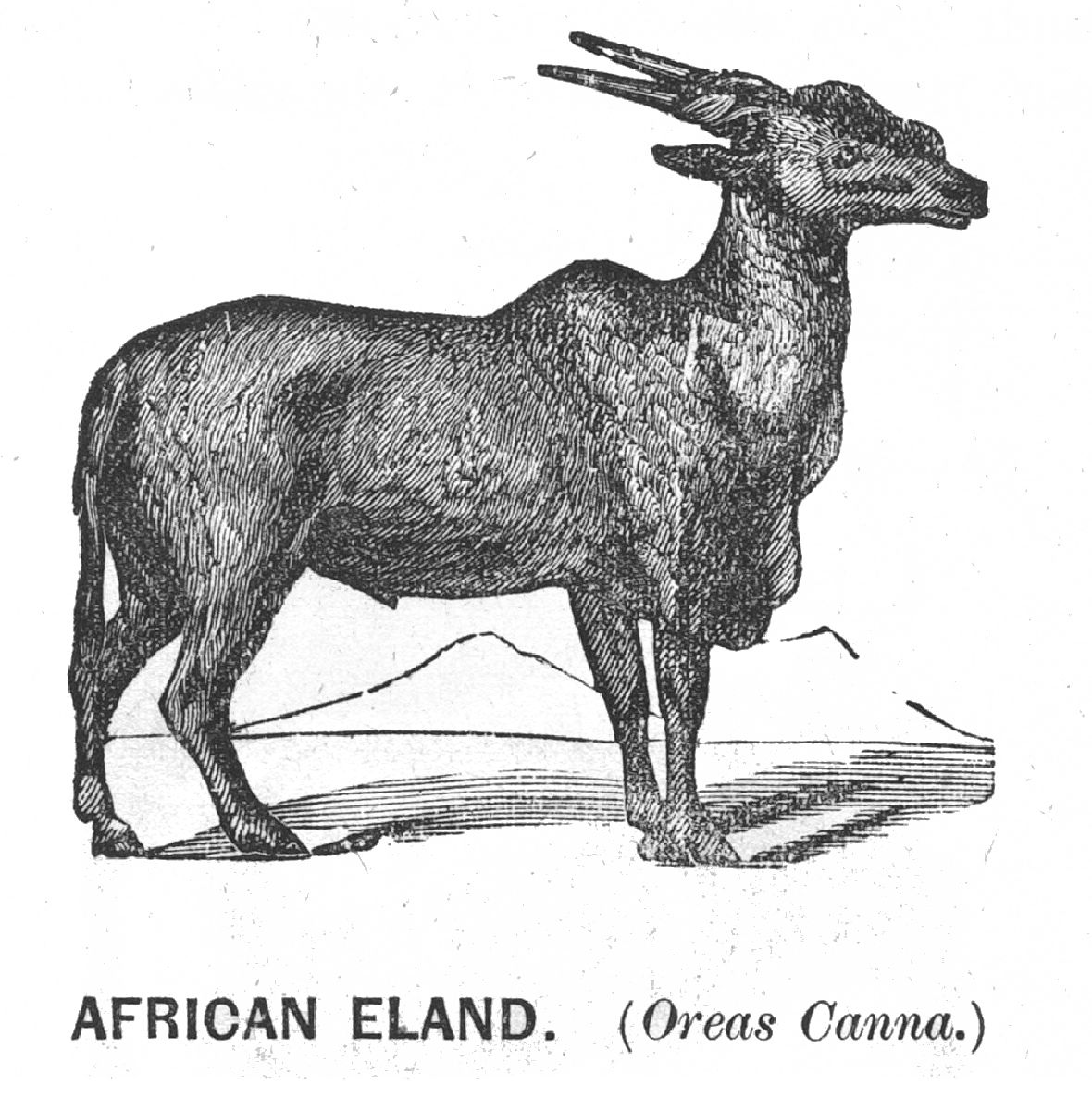
THE Eland, or Impoofo, is one of the most ponderous of South-African Antelopes, and frequently attains the dimensions of a very large ox. The first specimen sent to Mr. Barnum was over six feet in height, and such was its enormous size and weight, that it was unable to endure the stormy mid-winter passage across the Atlantic. Its body was, therefore, consigned to the angry elements, to furnish a temporary repast for the aquatic carnivora in the realms of Undine.
Mr. Barnum, the enterprising proprietor of this exhibition, not to be baffled in his purpose of bringing together the largest aggregation of animals ever witnessed in America, forthwith telegraphed to his agent in Europe, and we have the satisfaction of announcing the arrival of another magnificent specimen, which will be found among the Antelope collection.
Its flesh is excellent for food, being tender and delicious – a thing most remarkable, when we remember that the meat of most all other animals in Africa, according to the testimony of African explorers, is as dry and tough as sole-leather. As with the camel, so with the Eland; we behold in the economy of its nature the handiwork of an All-wise Creator, which enables it to subsist for months without drinking water. Its color is a pale grayish-brown, tinged with fawn-like stripes dimly outlined on the body of some of the varieties, while the horns are of large size, nearly straight, and spirally twisted. It is extremely raven ous in its appetite for food, the daily rations required making no small demands upon the exchequer, so that what it lacks in liquids is more than compensated in the extra demands for solid matter.
THE YAK. (Poephagus Grunniens.)
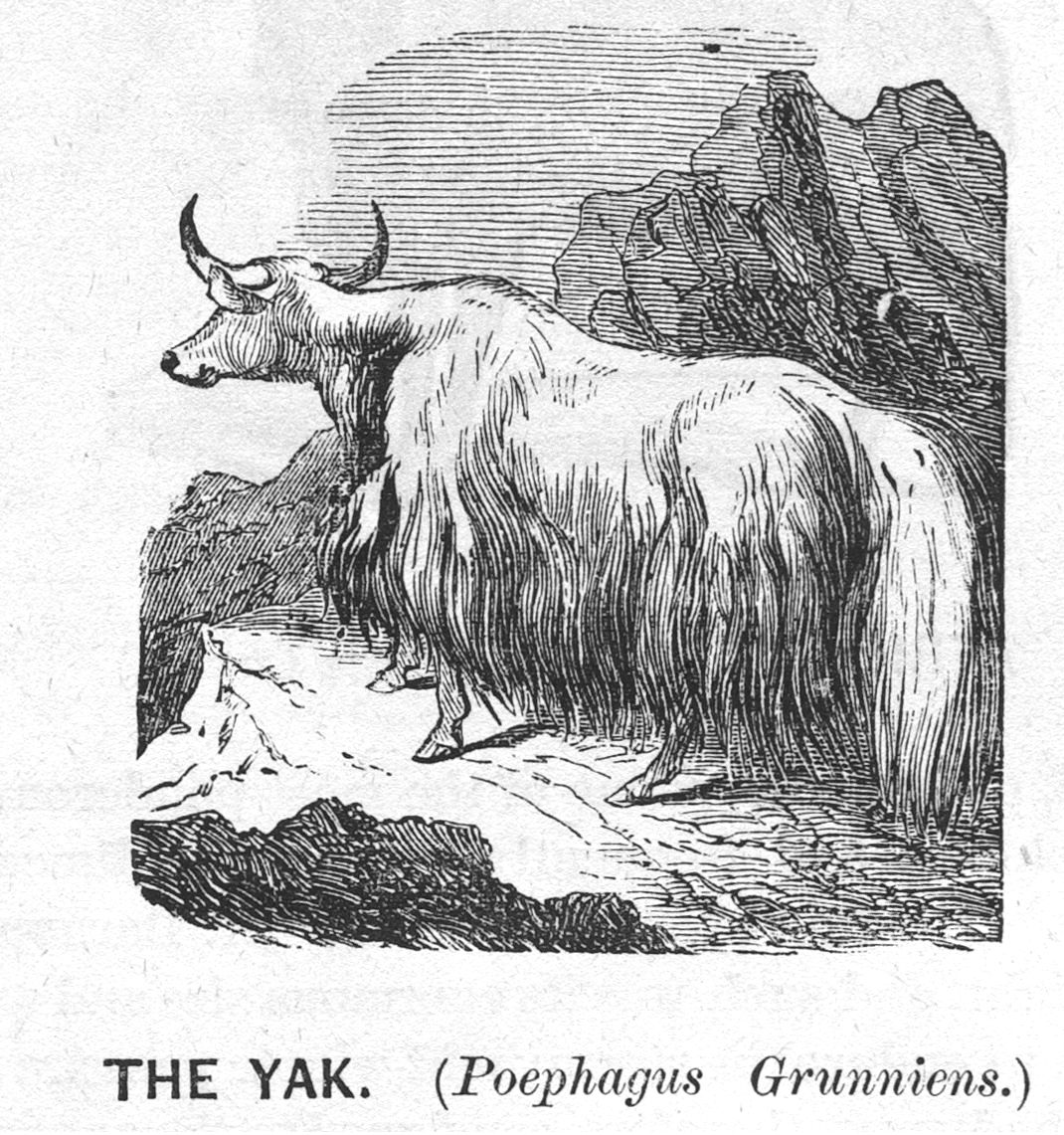
THIS rare specimen of the bovine race, as its name implies, is called by the natives of Asia the Yak, or Grunting Ox. The ancient Hebrews named every animal by the onomatopoeia process, from the noise it made. On this principle, Varro deduces his Latin name, ursus, a bear, from its growling propensities. The Yak is found among the highest plateaus of the Thibetan Mountains, ranging between the Altai and the Himalayas. It is easily domesticated, and is often brought into requisition to subserve the purposes of man. It is a large, handsome animal, with a high head and a proud look, challenging the admiration of all who behold it. The above cut gives a good illustration of its bodily conformation. The large heavy fringes of hair which depend from the sides and lower parts of the body, and the thick silken tufts of its bushy tail, are extremely valuable as articles of commerce, and constitute one of the staple fancies which decorate the wardrobe of our fashionable belles. It is dyed into all sorts of brilliant colors, and is extensively used to embellish the caps of Chinese Officials. The tail of the Yak, when highly colored, is carried before officers of state in their anniversary pageants, the number used indicating their rank.
The specimen sent to Mr. Barnum, from China, by Gen. Tom Thumb, is the only one of this variety ever placed on exhibition in this country. There have been one or two plebeian apologies, but nothing like the noble specimen sent by the appreciative little general to his life-long benefactor. It is totally devoid of horns, and would, therefore, be recognized by expert herdsmen as belonging to the "mully " variety, as is often seen among bovine species in all countries, a principle to which the Yak forms no exception. It is often used by the Asiatics as a beast of burden. If too heavy a load is imposed upon him, he manifests his displeasure by a loud, monotonic, melancholy grunting, painful to hear, and lugubrious in its pitiful appeals to heartless persecutors.
THE OCELOT. (Leopardus Pardalis.)
THIS interesting tribe of cats is very numerous in all wild and uninhabited portions of America, from Baffin's Bay to the Gulf of Mexico. They are known as grey ocelot, painted ocelot, margay, leopard-cat, tiger-cat, wild-cat, lynx, etc., being modifications of the same species, differing somewhat in size and markings, but possessing substantially the same attributes and characteristics. A portion of their food consists of certain kinds of herbs and grasses. It is supposed that all carnivorous animals were originally intended to feed on herbs, etc.; but, like man, these diversified specimens of the feline race "have sought out many inventions." The rapid advance of civilization has driven them out of the country, and they seem destined to a slow but sure extinction.
VLACKE VARK, or ABYSSINIAN WART-HOG.
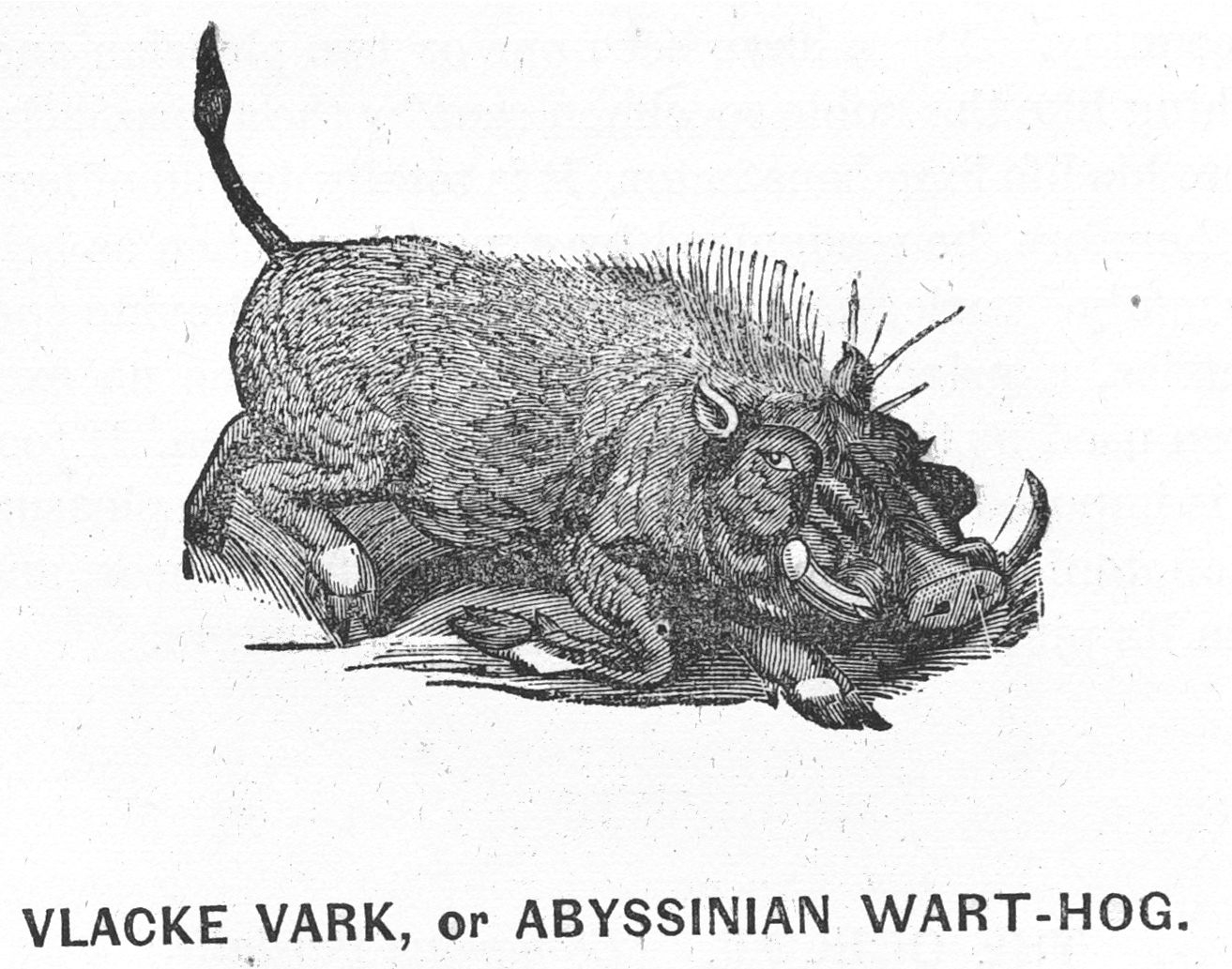
THIS animal belongs to the family of swine. In the conformation of its head it bears a striking resemblance to the hippopotamus, although smaller and more densely covered with hair and bristles. It is a formidable-looking beast, and seems to be an intermediate species between the rhinoceros and hippopotamus. The first specimens of this strange-looking animal were imported from Abyssinia, to the Zoological Gardens in London, about twenty-five years ago. Mr. Barnum happened to be in London, exhibiting General Tom Thumb before Her Majesty Queen Victoria and her royal consort, Prince Albert, besides many other of the crowned heads of Europe, when these Emgalla, or Abyssinian Wart-hogs, were first installed at the Royal Gardens, at Regent's Park, London. Of course, all the city was in excitement to see the marvelous nouveaux arrivés from the unexplored regions of Abyssinia. The great American Show Prince - who always had an eye to business - noticing the interest and excitement which these beasts caused in London, determined to secure one or more for his American Museum in New York. But, as remarkable as it may appear, after a lapse of twenty-five years, he has but recently been able to secure for his great Zoological Institute the first ever seen in America. It will be exhibited in conjunction with his Great Traveling Museum, Menagerie, Polytechnic Institute, International Zoological Garden and Hippodrome, during the traveling season.
The general color of the Vlacke Vark is of a blackish hue on the crown of its head and neck, and along the ridge of the back, and a dull brown on the remainder of the body, with a greyish tint upon the abdomen. The tusks of an adult male are about twelve inches long, and are a most terrible weapon. They have been known to cut a large-sized mastiff nearly in two, by a single stroke, or sever the fleshy parts of a man's thigh. When pursued by Kaffre huntsmen, it presents a ludicrous appearance. The shortness of its neck and the flabby excrescence upon either side of the cheek preclude the possibility of eyeing its pursuers; it is therefore obliged to elevate its snout perpendicularly in the air, so as to look over its own shoulder. This comic position is heightened in effect by a stiff upright tail, which seems to stand as a rear sentinel to guard the approach of its enthusiastic captors. It is, however, when driven into close quarters, a savage and determined foe, and will fight to the last extremity. Its retreating haunts are among the labyrinth of holes abandoned by ant-bears, into which it plunges back foremost, and suddenly disappears out of sight. The structure of the teeth is very curious, and well worthy scientific investigation. This animal is sometimes known as Aethiopian Wild Boar, or the Abyssinian Phacochaere, although it differs materially from that animal. It lives to the age of fifteen or twenty years, and is a terrible pest, on account of its frequent depredations. This specimen will be viewed as an object of great interest by naturalists.
NYL-GHAU. (Portax tragocamelus.)
THIS curious specimen of the Northern India antelope, as its name implies, is the "blue cow" of Asia, spoken of by Pliny the younger. It appears to sustain the same relation to its African confréres, the koodoo and bosch-bok, as the puma and jaguar of Central and South America do to the lions, tigers, and leopards of the Old World. The color of the body is slate-blue, the face exquisitely marked with minglings of umber and sepia, the eyes large and lustrous, the neck long and stout. Itis supplied with a dark mane, and a long, heavy tuft of coarse hair, which depends from the throat. The male is about four feet high; the female is smaller, without horns, and of a reddish-grey tint. The horns of the male are about eight inches long, thick at the base, annulate, and slightly divergent. The fore-legs are thick, straight, and well set; the hinder limbs, from their obtuse angularities, give the animal the appearance of being higher before than at the haunches.
The Nyl-Ghau feeds solely on vegetation, is not very social in disposition, but pairs off with its mate, where they are found in comparative solitude in the thickly wooded districts of Northern India. It is almost indomitable, hard to capture, irritable in temper, capricious in its friendship, and, when forced into close quarters, drops on its knees and leaps forward, utterly regardless of all obstacles, dashing right into the face and eyes of its astonished pursuers. But few of these strange creatures have ever been imported. No zoological collection is considered complete, however, without specimens of the Asiatic Antelopes; and students of natural history, therefore, will appreciate the liberality of the management in securing a good show of the real blue ox of India, which they will be pleased to find in the Great Menagerie collection.
KANGAROO. (Macropus Major.)
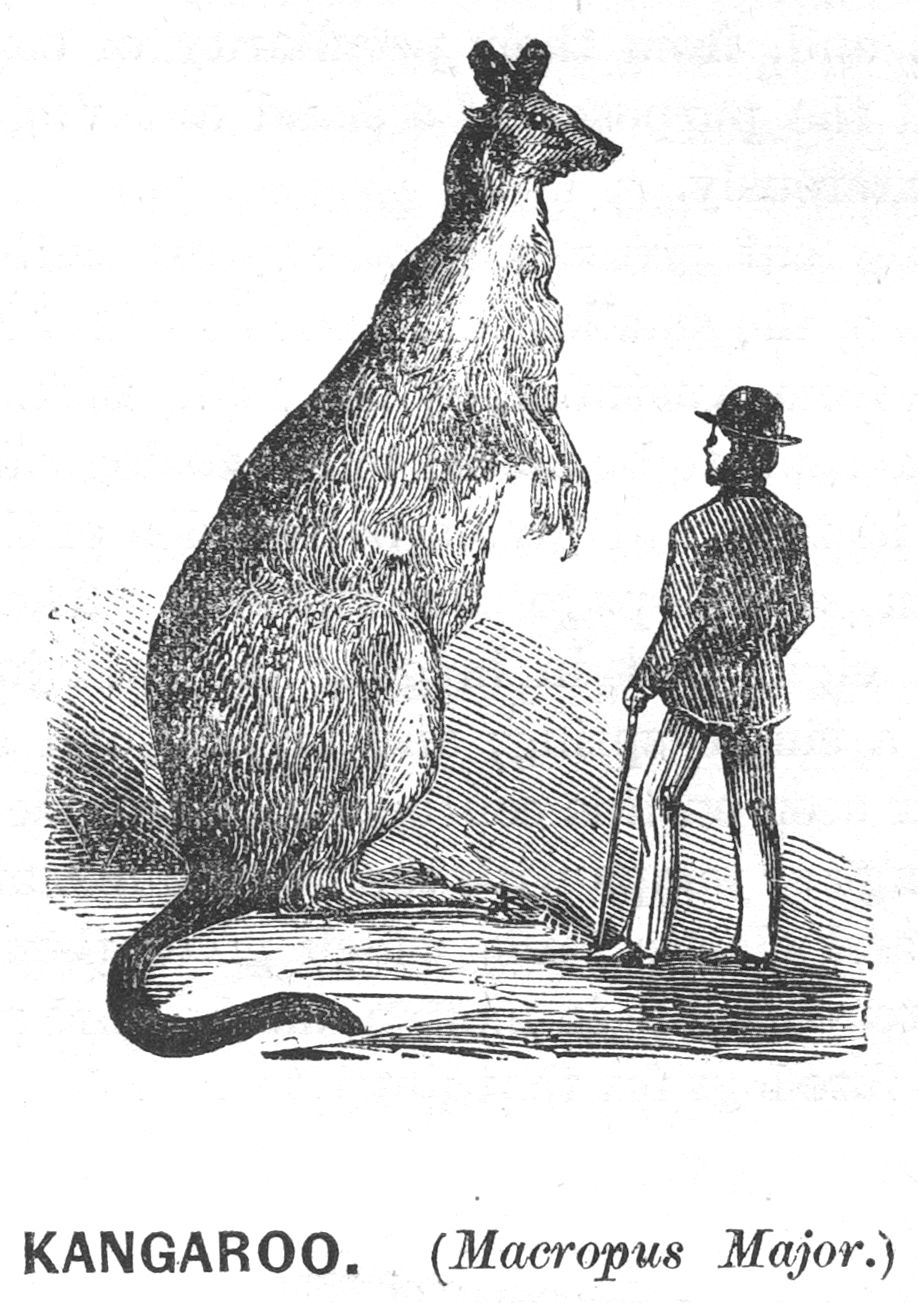
THERE are many varieties of macropidae, the Kangaroo being the largest and most remarkable. These animals are called marsupial, from the fact that in the female there is a pouch, or marsupium, upon the external abdomen, in which the young, after birth, are safely housed and nourished, and whence they come and go with impunity, until they are about ten months of age; the number of young rarely exceeding two at a single birth. There are said to be eighty varieties of the Kangaroo, which is extremely doubtful. The largest and most noted of these are the Giganteus, Woolly, or Red Kangaroo; all others are mere subdivisions of the same genus, the modifications being more in size than habits or characteristics. Among the smaller of the family may be mentioned the kangaroo rat, hare, and the brush-tailed bettong. The tree kangaroo is so called from its well-known habits of climbing or springing into trees; while the rock kangaroo is known from its habits of isolation among the rocks and cliffs, where it is often found separated from its more gregarious brethren, preferring darkness rather than light for its depredations. The color of these animals is an ashen-grey, with a gradation of shade, being lighter or darker in the different species; while upon the breast and abdomen of the doe, or female, there is no inconsiderable admixture of pure white. The fore-feet are black, and, from their peculiarity of conformation, answer very well the purposes of a hand and fingers, which they manipulate dexterously.
The foregoing cut gives a good representation of a doe or female Kangaroo, the smallest of a pair of Giant Kangaroos sent to Mr. Barnum from Australia, by his little friend, General Tom Thumb, as a present to be added to his zoological collection. A glance at the picture will give a better idea of these interesting creatures than a full-page description. These magnificent specimens are eight feet in height, and will jump more than fifteen feet at a single spring, and are, beyond all controversy, the largest ever seen on this continent. Their method of locomotion is by springs or jumps with the hind limbs, aided by the use of their long and elastic tails, which gives them an extremely comical appearance while in motion, as they are rarely known to use their short fore-legs for that purpose.
HIPPOPOTAMUS. (Hippopotamus amphibius.)
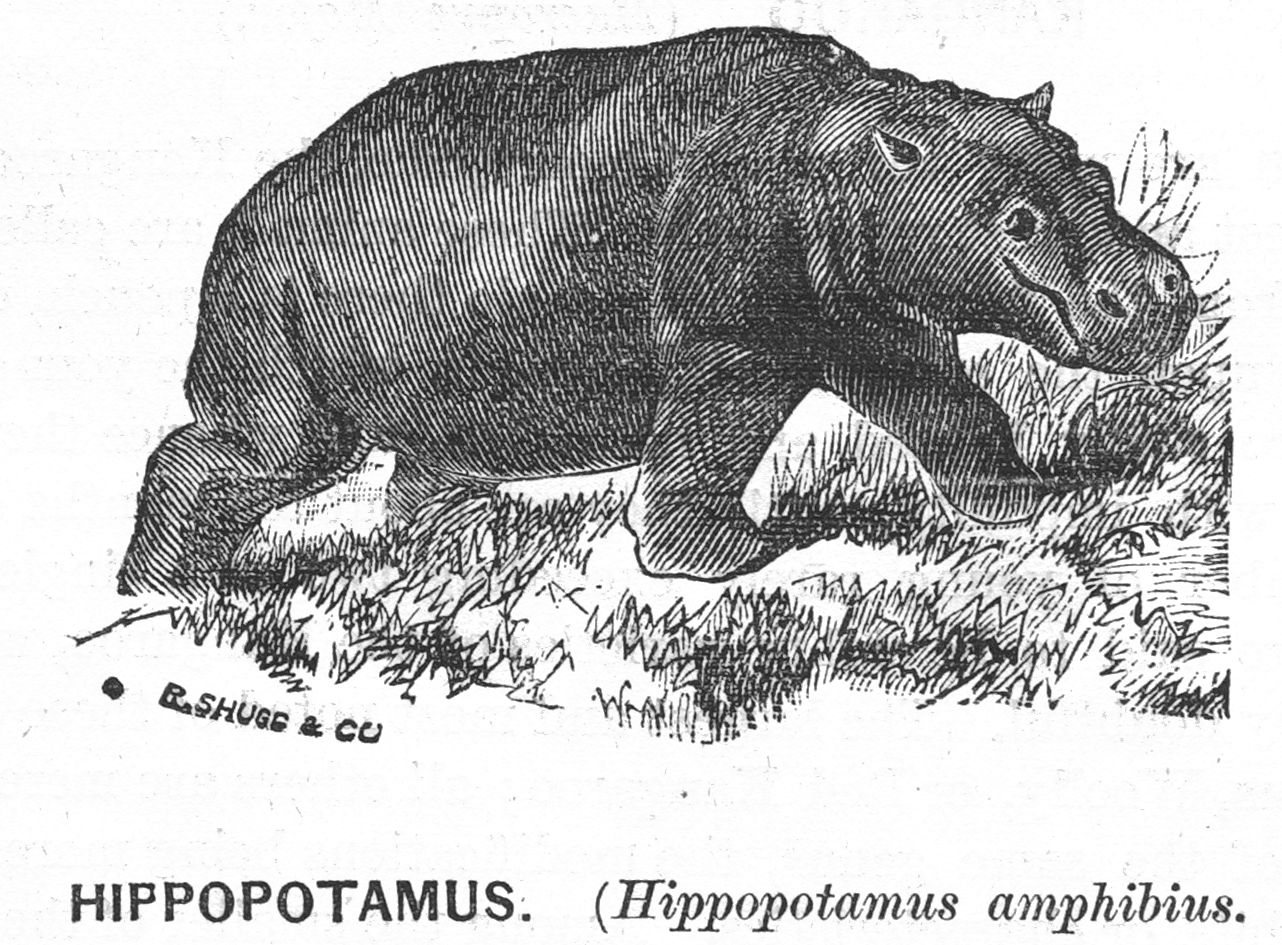
P. T. BARNUM is entitled to the credit of being the first and only manager in America to secure and place on exhibition a live Hippopotamus. At great risk of life and property, and at an actual outlay of gold sufficient to constitute the ransom of a king, he introduced into his Museum, in 1860, one of these amphibious monsters from South Africa; and the most money ever made in one season by any traveling concern was in 1862, by Messrs. G. F. Bailey & Co., who exhibited him throughout the Northern States and British Provinces, having leased the animal from the great Show Prince for that purpose. On the opposite page our artist has succeeded so admirably in delineating this ugly, uncouth-looking brute, that any further attempt at pen illustration seems supererogatory. Suffice it to say, however, there are several varieties found in all parts of Africa, always in proximity to rivers and streams of water, in which element they spend more than half their time sleeping or floundering, a terror to both land and marine monsters, and a havoc to all neighboring crops. Their legs are short, but their bodies of enormous size. Their skin is of a dark. reddish-brown color, full of cracks, chaps, and cross-etchings, with dapplings of irregular dark spots on the sides and upper portion of the body. The skin is from one to two inches thick, full of pores, through which exudes a disagreeable oily substance - probably the brute's only antidote against disease, arising from its indiscriminate mixture and caperings in all kinds of malarious waters, which abound in the latitude of its habitation. They have been known to grow to seventeen or eighteen feet in length, and from five to six feet in height. Their enormous teeth and tusks are formed scissors-like, with which they clip the vegetation upon which they feed, like a pair of shears. The tusks of the Hippopotamus, or River-horse, are very solid and compact, admirably adapted for making delicate philosophical apparatus and articles of dentistry. It is an expert swimmer, and, like the elephant, possesses the faculty of sinking or rising in the water at will. Itis captured by means of traps, pitfalls, harpoons, and massive nets of rope - being able to capsize the largest vessels used for this purpose. The appetite of this animal is voracious, having a stomach capable of stowing away five or six bushels of provender at a single meal. As its natural element is water, it will be readily seen how difficult and hazardous is the attempt to procure one of these marvelous beasts for exhibition in a traveling show, as it must always be supplied with a tank of water, out of which it will not subsist for any length of time. No-one but the liberal and audacious proprietor of this mammoth enterprise would think of providing the public with such a rare amphibious specimen of zoology, when the above-named facts are taken into consideration. And yet, in the face of all this, Mr. Barnum is determined that the people shall be gratified, by importing another Hippopotamus at the sacrifice of any time, money, or expense. As an expedition has been fitted out expressly for that purpose, it will readily be seen that the cost of such an enterprise cannot fall short of $25,000.
THE MALAYAN TAPIR. (Tapirus Malayanus.)
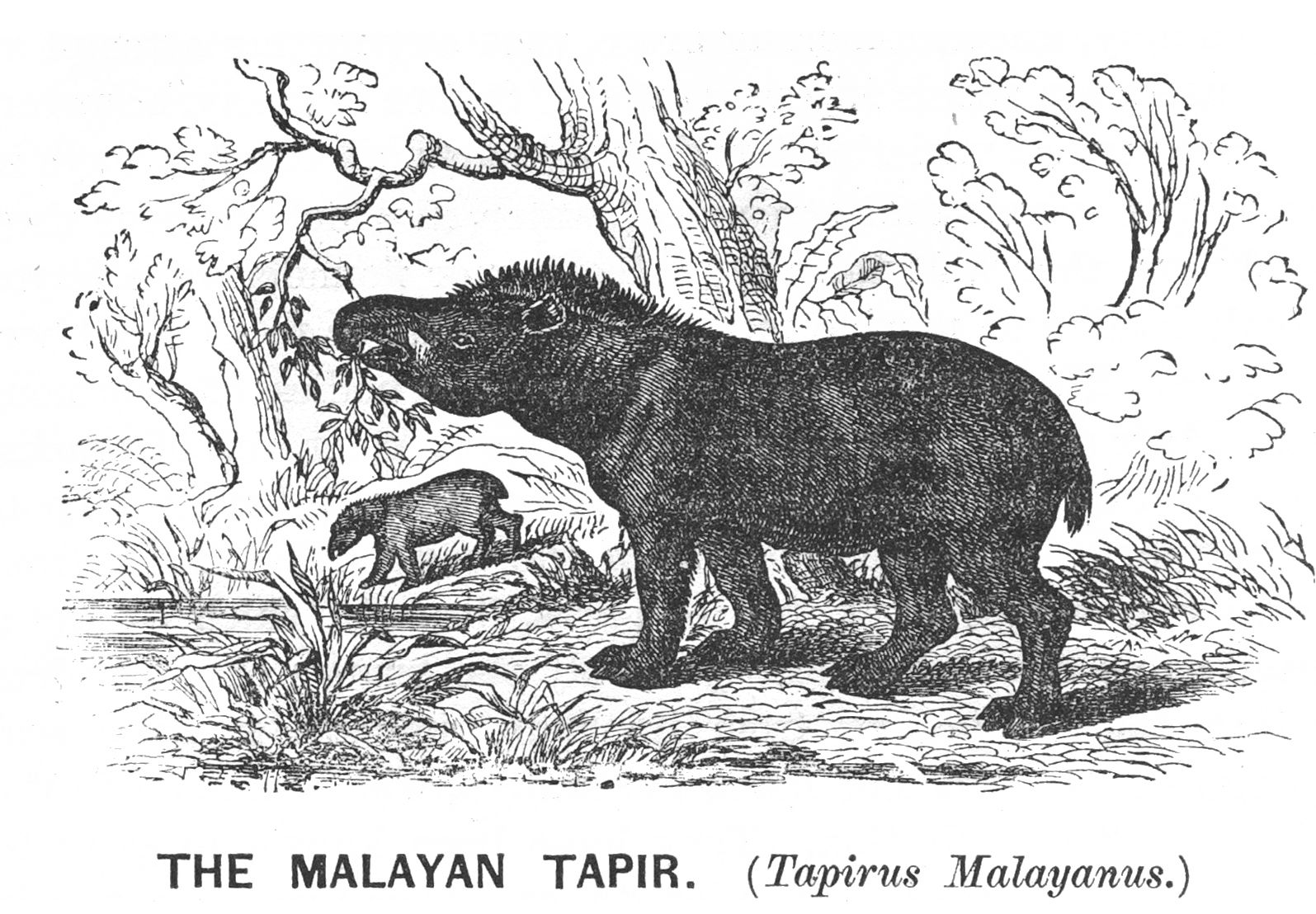
Tais Tapir is a transition from the elephant to the swine species, about half-way intermediate. There are but two varieties known to zoology, although fossiliferous remains of this animal testify to the fact that, at an early period of the world's history, other and much larger varieties had an existence. The Malayan Tapir exists in large numbers in Malacca and Sumatra; but, being a shy animal, inhabits the dense and inaccessible forests, where it is rarely seen, even by the natives. It is very fond of the water, and contents itself by walking on the bed of the stream only, as it is not an expert at swimming. The Malayans call the Tapir Kuda-ayer, or River-horse, from its aquatic proclivities; but that it is amphibious, as has been averred by certain writers, is an assertion that has no foundation in fact. The color of the adult Malayan Tapir is a dark sepia, almost black, except upon the rear portions of the back and haunches, where it is light, as if a white mantle had been dropped upon its back by some talismanic Elijah of the antediluvian period, giving it a strangely picturesque appearance. There have been very few of the Malayan species imported; they are, therefore, objects of great curiosity among the zoological collection.
SOUTH-AMERICAN TAPIR.
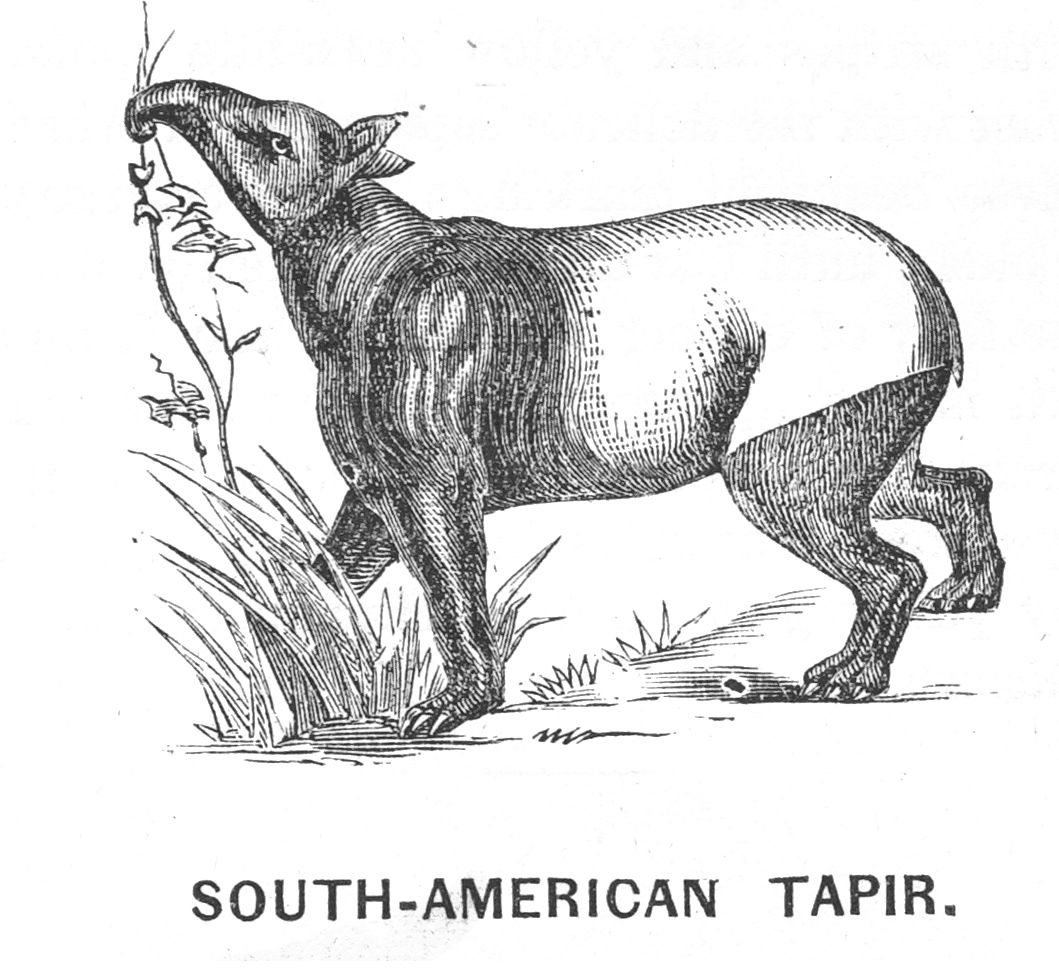
IN many respects the American Tapir differs from that of the Malayan. It is found in large numbers in Central and South America, always in the vicinity of rivers, preferring the thick coverts of dense forests, whence they issue only by night, in search of food. The American variety are good swimmers and divers, and very often elude their pursuers by suddenly plunging in the water and diving out of sight, or so concealing themselves among the shrubbery, brakes, and water-lilies, as to avoid detection. As numerous as they are, however, it is extremely difficult to capture them; hence, few are found in captivity. It is a strict vegetarian, using its long prehensile nose, or proboscis, to pluck the grass, leaves, herbs, etc.. upon which it subsists. While walking or running it carries its head very low, and is never diverted either to the right or left of its path, whatever obstacle there may be to encounter. Its thick tough hide is capable of protecting the animal from thorns, brambles, and thick craggy branches of the forest-trees, through which it passes on its head-long way during the darkest midnight hours. The Tapir, though a large, bulky animal, falls an easy prey to the jaguar, which, concealing itself in the overhanging branches, springs suddenly upon the back of the poor brute, and strikes it to the earth. When thus attacked, the Tapir will sometimes rush through the thick underbrush and try to scrape the jaguar off; or, if in proximity to a river, will plunge in, and either drown the foe or compel it to relinquish its hold. The Tapir is comparatively harmless, easily tamed if taken young, and frequently becomes an unwelcome and too familiar pet. The young are most exquisitely variegated with stripes and yellow fawn-like spots, forming a striking contrast with the delicate sepia tints of other portions of the body. These beautiful markings, however, disappear as the animal grows older, until lost altogether, like those of the American deer. The folly of calling this animal the Hippopotamus of South America is very apparent, when we reflect that neither in looks nor characteristics is there the slightest similarity between them. And yet some managers insist on trying to impose upon the people by palming it off as a Hippopotamus. Sic transit gloria spectaculorum.
THE EGYPTIAN CROCODILE.
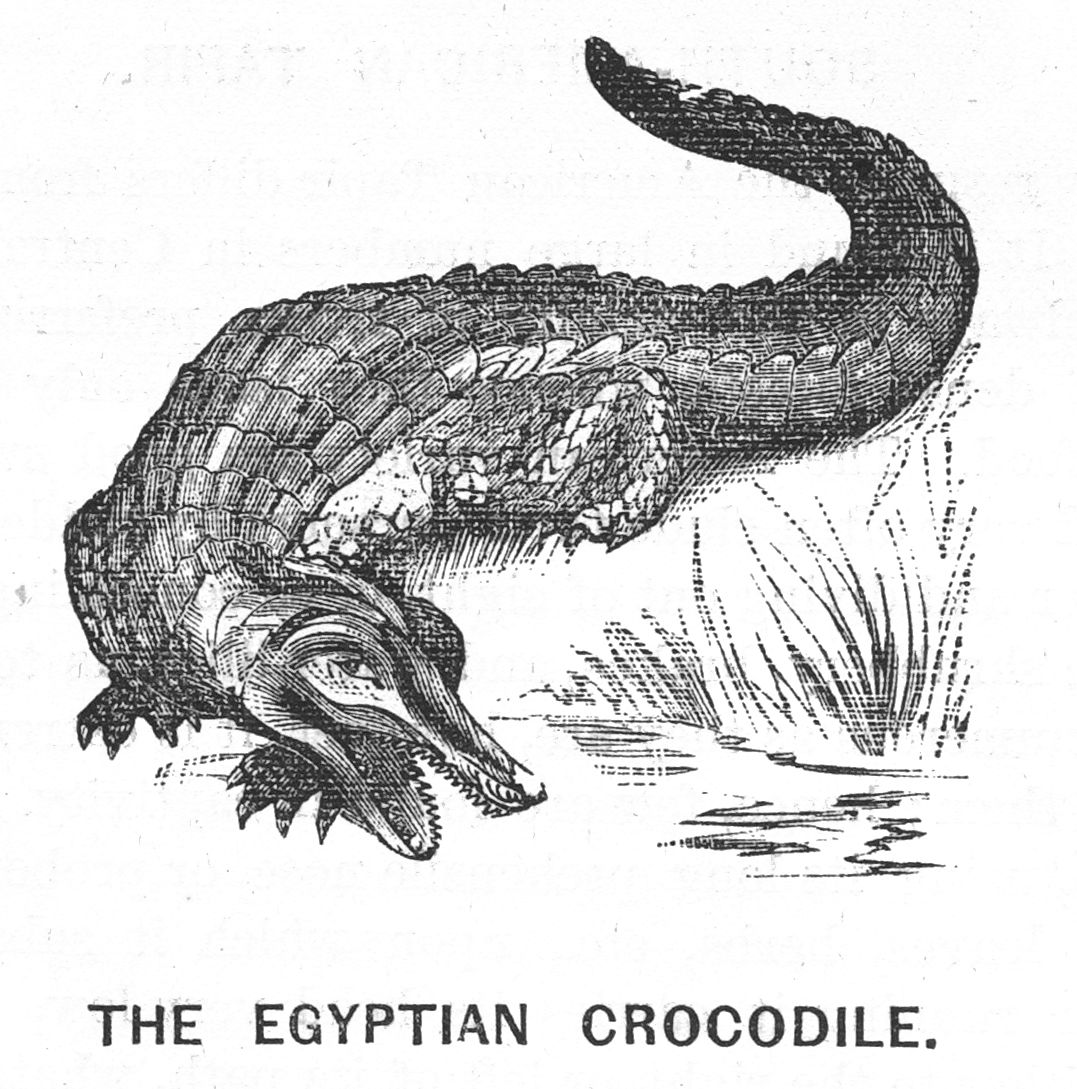
THE Crocodile is a natural inhabitant of the river Nile, and other Asiatic and African rivers. It is a carnivorous reptile, amphibious in habit, and belongs to the saurian group. It is of enormous size, strength, and voracity, a rapid swimmer, swift on foot, but, on account of its great length, slow to turn round. It will attack mankind, or any of the larger animals, with the most daring impetuosity. In proportion to size, it has the largest mouth of all living monsters known to ancient or modern zoology; moves equally the upper and lower jaw - that of the upper having forty, and the lower jaw no less than thirty-eight massive teeth. It is liberally furnished with a thick coat of mail, so scaly and callous as to be absolutely impervious to the hardest bullet, the only vulnerable point being directly under the belly. They are generated from eggs resembling those of the goose, which the female deposits in the sand, two at a time, leaving them to incubate solely through the genial warmth of the sun and soil. They grow to a great length, averaging from sixteen to twenty feet when perfectly developed. The Crocodile from Egypt has a strange counterpart in America, in the family of El lagarto, corrupted from the Spanish, by early English settlers, into Alligator; it is not, however, identical with the Crocodile, although the difference is more specific than generic. Their comparative merits will be better judged of on examination, however, as the enterprising proprietor has procured, at a great sacrifice of labor and expense, species from both Egypt and Florida in the U.S. That the Leviathan mentioned in the book of Job was nothing but the Crocodile of the river Nile, is no longer a question of doubt by either naturalists or commentators of any pretensions. "Canst thou draw out leviathan with a hook, or his tongue with a cord which thou lettest down?" ‘His scales are his pride, shut up together as with a close seal." - JOB xli. 1-15,
MERIANS OPOSSUM. (Philander Dorsigerus.)
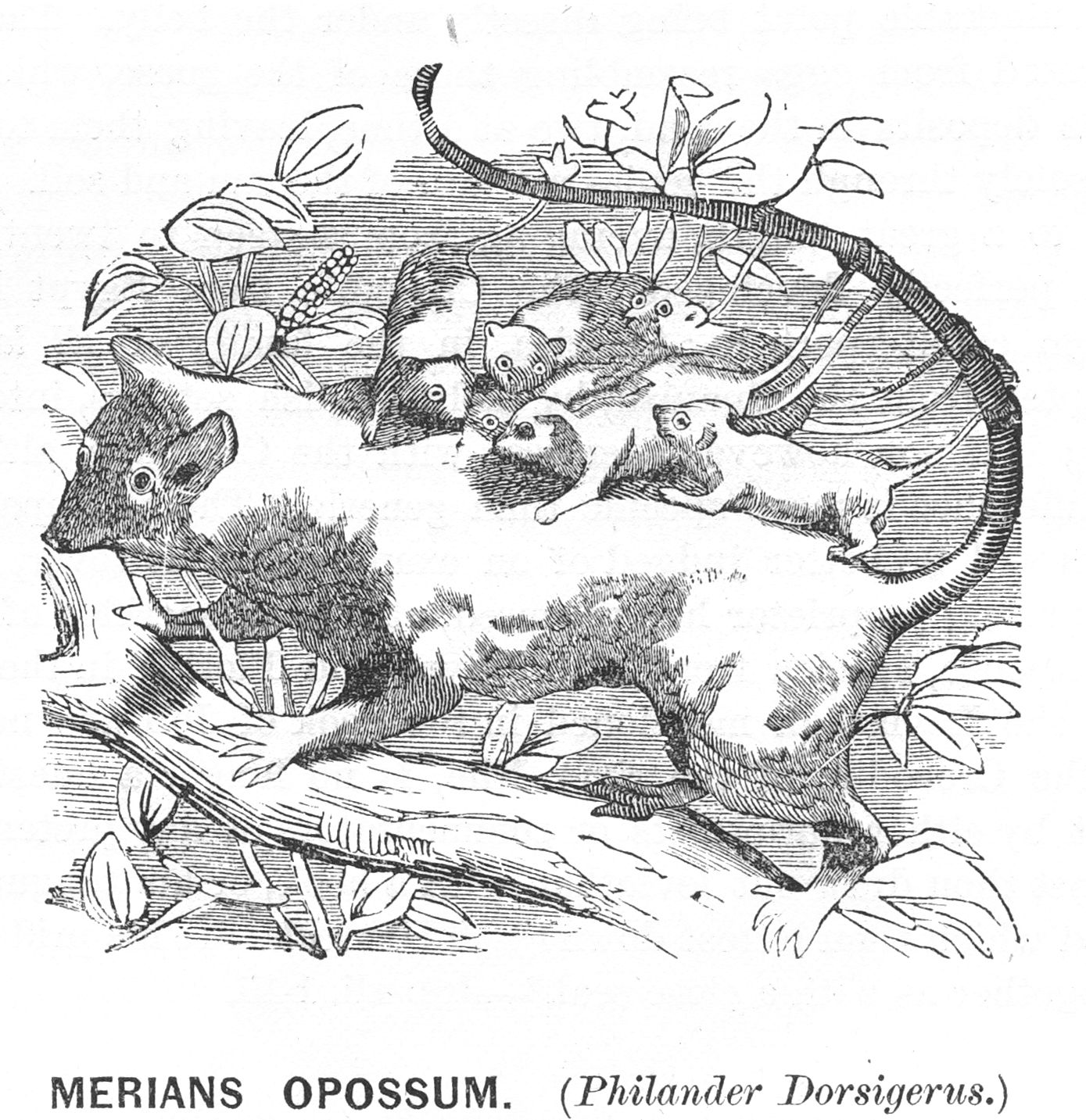
OUR artist has given us above a very clever representation of one of the varieties of the Opossum, which, though it belongs to the family of marsupials, is devoid of the true pouch, as illustrated in the character of the kangaroo and the Virginia and Crab-eating Opossums, which are supplied with a veritable marsupium. This Opossum is called "dorsigerus," from the Latin word dorsum, the back, from the peculiar habit of this beautiful little creature, which bears its offspring upon the back, as seen in the picture. At a very early age, these tiny young Opossums mount sur le dos of their doting mother, where, with their little hand-like feet, they cling to the fur, while their prehensile tails are securely entwined around that of the mother, forming a series of narratives extremely suggestive, - a tale of filial and maternal affection rarely exemplified in the habits and instincts of other members of the macropidae group. They are confined almost exclusively to this country, their habitation being principally among trees, where they display their arboreal antics to good advantage.
SPOTTED HYENA. (Crocuta Maculata.)
SOMEHOW or other, there is associated with the very name Hyena something that is mean and contemptible. There is in its nature more than is expressed in the picture. It sustains the same relation to the animal kingdom as the shark does to the fishes of the sea, or the crow and buzzard to the fowls of the air - a scavenger of no mean pretensions. While we admire the economy of Nature, which makes one portion of creation the instrumentality of ridding the earth of putrefaction, we can entertain but little less than contempt for the instrument thus used in its accomplishment. Not so much, perhaps, on account of the instinct of the animal, which compels it to hunt up and devour decomposed or decomposing animal matter, as the abuse of its prerogative in haunting graveyards, and unearthing from their sepulchres the departed dead, and ruthlessly dragging forth to light those whom, through love and affection, we have buried, as supposed, forever out of sight.
There are several varieties of the Hyena - such as the Crested or Striped, Brown, and the Tiger-wolf or Spotted Hyena - which are found in large numbers in Asia and Africa. The habits of these vary but little; the spotted variety being the largest and most powerful, having jaws and teeth of extraordinary strength, and between their tremendous fangs a human body, or the massive thigh-bones of an ox, fly in splinters with a savage crash that makes the spectator shudder. The skull of the Hyena is of a remarkably solid formation, and so rounded and arched as to give it enormous power. The zygomatic arches of bones that extend from the eyes to the ears, and the deep bony crest that projects beyond the brain cavity, serve to attach and knit together the powerful muscles with which this animal is supplied, both in its neck and head. The eyes are wide apart, of a dark, dull, round, repulsive aspect; the muzzle is short; the tongue is rough, thorn-studded, like that of the feline species, for rasping every vestige of flesh from the bones of its prey. The color of the hair is a light-brown or gray, with a long crest or mane on the neck and shoulders, and also on the breast and throat, the tail being comparatively short and bushy. It lives in holes, or among rocky, retired places; and as the sun sinks in the West, it comes forth in search of food. It is said to utter a long, melancholy howl, terminated by a hysteric bark, mingled with a fiend-like laugh, which, heard in the desert, amid scenes of the wildest description, suggests to the mind of the solitary traveler the forms of some ghosts, goblins, or spectral ghouls, searching for their unnatural feast. The smell of the Hyena is so rank and offensive, that even the jackal is said to leave a carcass whenever the Hyena comes near to participate in the moribund repast. They are indomitable in disposition, - although Prof. Charles White, the famous tamer of wild beasts, better known as the lion-king, who is connected with this establishment, is determined to subdue a pair, in order to give a performance with them in the public exhibition.
THE MOOSE or ELK. (Alces Malchis.)
In some portions of Europe, an adult male Moose attains to enormous proportions, being nearly as large as a medium-sized elephant. It is the largest of the Deer tribe, and has horns of great reach and breadth, widely palmated at their extremities, and so ponderous in weight as to challenge our wonder, if not admiration, at the facile manner with which this magnificent animal wields them. Mr. Saml. Booth, the popular pictorial printer, of New York, who never allows anything marvelous to escape his observation, has in his private cabinet one of the largest and most interesting specimens of Moose's horns we remember to have ever seen. They are over four feet apart from tip to tip, and weigh about forty pounds. The specimen came from the north of Europe, where the Moose attains its largest size; and, from the forks and annulations of the antlers, we should judge the animal to have been about twenty years old when the horns were removed. In America, where this noble animal was formerly found in large numbers, it is better known as the Elk. The muzzle is extremely large and lengthened in front, which imparts to the countenance of the Elk an expression decidedly unique, while the nostrils are widely distended, rendering it keen and quick-scented to detect the presence of an unseen foe. Its color is dark brown, that of the legs being blended with yellowish-white hues, and, with its massive horns thrown gracefully back upon the shoulders, the animal presents a picturesque appearance, notwithstanding the awkwardness of its gait.
In many localities of the United States, beautiful villages have sprung up into existence, called "Elkland," from the large numbers of these majestic animals found during the earlier settlements of the New World. However, like many of the undisputed wild denizens which occupied these primeval forests in bygone days - the Deer, Elk, Stag, and Roebuck - they are slowly but surely passing away; a few more generations, the rapid advances of civilization, and these interesting creatures will have gone forever.
It is this fact which has stimulated many private gentlemen, as well those having the management of our public parks, to provide for these beautiful creatures, and preserve them intact from the ravages of the ruthless sportsmen.
FALLOW DEER. (Dama Vulgaris.)
THIS beautiful creature is one of the most lithesome and exquisitely marked of the stag species. Whether we contemplate it as the "hart" of the Psalmist, the "hind" of the Pentateuch, the "stage" of the Prophet, or the " wild roe" of Samuel the Judge of Israel, it presents to our minds the same sentiments of inspiration, and challenges our unbounded admiration, as an appropriate figure so often used by the Sweet Singer of Israel more than three thousand years ago, expressive of the pure sentiments of devotion which the familiarity with these free and noble animals so rapturously called forth. Although the name of the "hart" is a generic word, including all the species of the deer kind, whether they are distinguished by round horns, as the stag, or by flat ones, as the Fallow Deer, or by the smallness of the branches, as the roe, yet it is a fact worthy of observation, that the hind, the roe, the hart, and the antelope, were held in ancient times, and still continue to be, in the highest estimation in all the Eastern countries, for the voluptuous beauty of their eyes, the delicate elegance of their form, and the graceful agility of all their movements. Hence it is that the names of these lovely animals were almost perpetually applied to persons, whether male or female, who were supposed to be possessed of any of their respective qualities. Saul was called, for instance, the "Roe of Israel." "Agahel was as light of foot as a wild roe." "Her princes are become like harts that find no pasture; they are gone without strength before the pursuer." - LAM. i. 6. If we descend to the classics, we shall find the graphic Homer representing his hero, Achilles, as "swift-footed" and graceful as the tread of the "young roe on the mountain's brow." As seen in the picture, the Fallow Deer is covered with a spotted coat, washed with pure white under the throat and upon a portion of the limbs, while the horns are palmated and graceful in their altitude and expansion. It is largely used for private and public parks, and adds much to the beauty of the lawn.
APES, MONKEYS, and BABOONS. (Simiadae.)
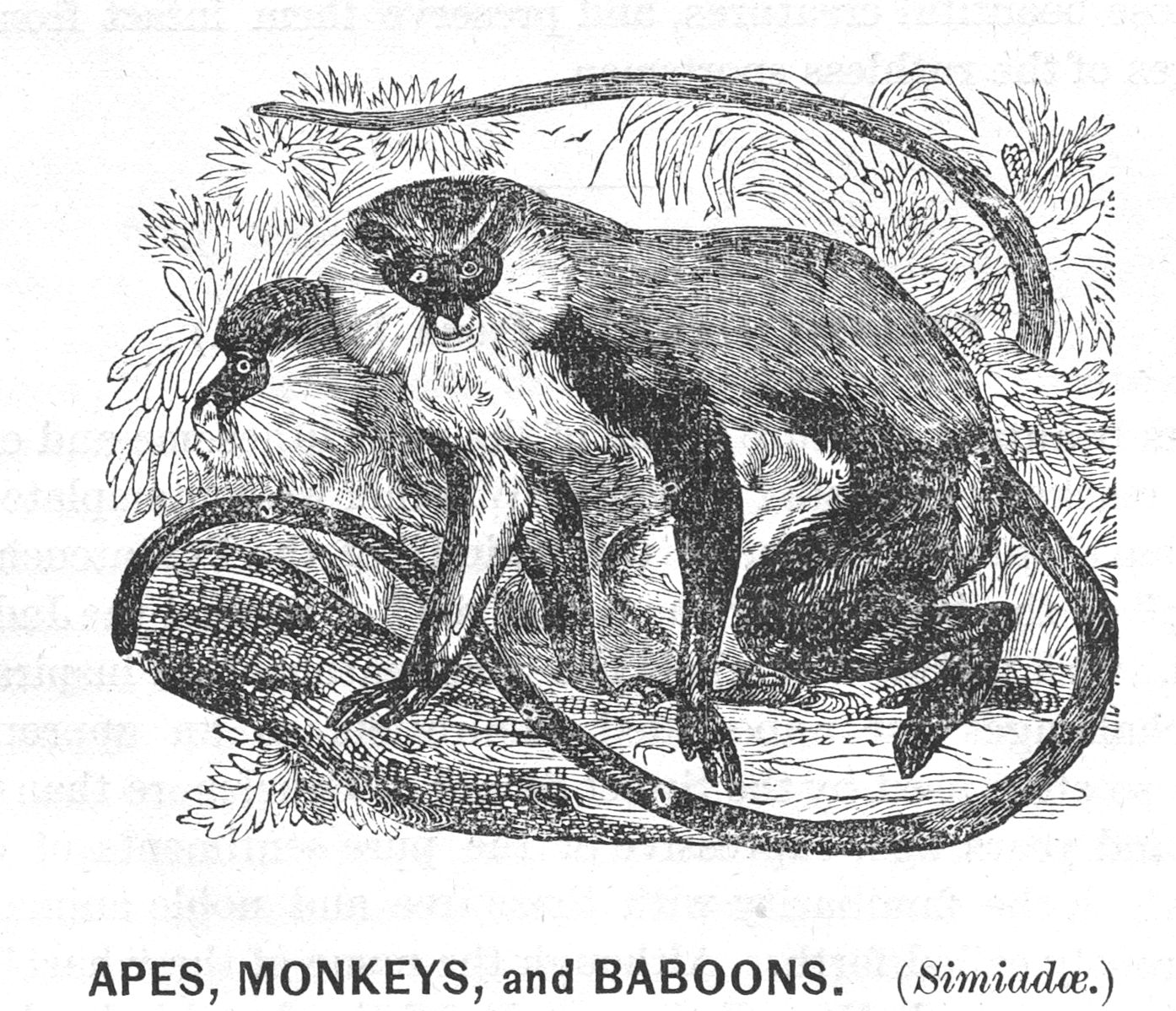
WE come now to speak of a very remarkable group, called quadrumana, or monkey tribe. Our artist has given above a fine representation of the Simia group (Presbytes Melalophos), which, on account of their very long prehensile tails, will swing themselves from one part of the cage to another, or from tree to tree, and, if they wish to cross a stream of water, will intertwine themselves into a chain of a dozen or so and swing across with ease and safety. The number and variety of the Ape tribe is almost legion. They are found in Asia and Africa, South America, and In many of the islands of the sea.
Among the more prominent varieties are the Gorilla - a genus considered somewhat apochryphal for many years, but now admitted and classified in the compendium of generic distinctions, - the Chimpanzee, Orang-Outang, Siamang, the Lar, silvery and agile Gibbon, the Simpai, the Colobus, Genereza, Grivet, Vervet, White Nose, Patas, Diana, Mangabey, Barbary Ape, Wanderoo, Baboons, Gelada, Chacma, Mandrill, Coaita, Marimonda, Ursine Howler, Capucin, and a hundred other American varieties, not necessary to mention for want of space. The entire group of simiadae are but a mockery or caricature of the human race, and no person can investigate these strange imps without reflecting how vast is the difference between the brute and the intellectual creatures whom God has so highly favored. And yet, the subtlety, cunning, endlessly varied pranks and tricks of these creatures show them to be the most subtle and intelligent of any other creature of the animal kingdom, man alone excepted. It is a remarkable fact that, both in the physical and arterial conformation of the orang-outang, there are many striking similarities to the human form divine, although there is an impassable gulf which no Darwinian theory of animal transmutation will ever pass; and to suppose that any portion of the human race have ever descended through a gradation from the monkey species is a blasphemy and an open attempt at impeachment of one of the noblest attributes of Divinity. If there be any theory to suggest, it would be that ono of the ape tribe, instead of the serpent, was used as an instrument for the temptation of Eve in the Garden of Eden, as it was called the most subtle of all the beasts of the field; and the curse of the race is, - "on thy belly (all fours) shalt thou go all the days of thy life." However, this is no place to theorize. The fact exists that these always interesting creatures will attract our attention, in spite of ourselves, and nothing in a zoological garden will gather a crowd of eager and grinning spectators quicker than a well-filled cage of these famous caricaturists of the genus homo. It is quite likely that Prof. Darwin himself has obtained much of his theory from the well-known characteristics of these heterogeneous caricaturists of our race.
SEA-LION. (Otaria jubata.)
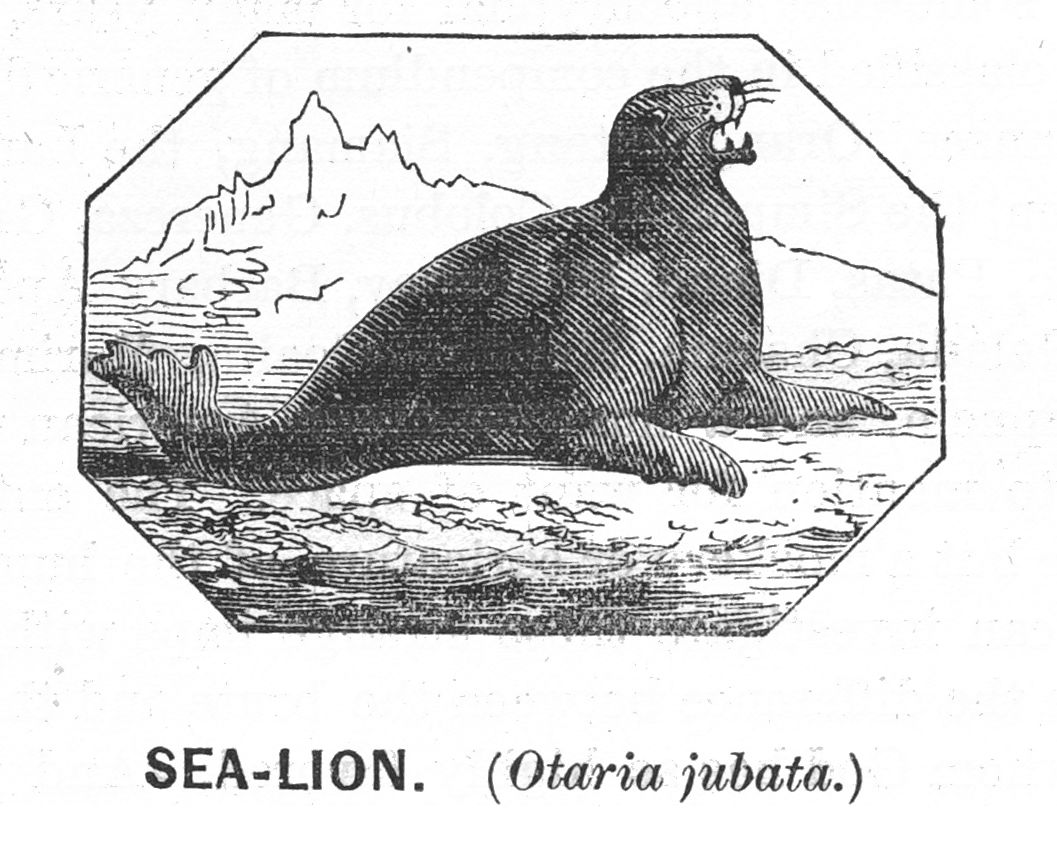
THE Seal, Walrus, Sea-Leopard, Sea-Elephant, and Sea-Lion belong to a maritime genus called Phocidae, and are remarkable for their habits as well as the formation of their bodies. They are found in the extreme northern solitudes of both hemispheres, their principal food consisting of fish. The Sea-Lion is so called from its fancied resemblance to the royal quadruped which reigns supreme in Africa. It attains to from eight to ten feet in length, and, when in good condition, weighs from eight hundred to a thousand pounds. The color of an adult male Sea-Lion is a reddish-brown, which becomes paler with age. Upon the neck and shoulders grows a heavy mass of stuff - curly, crisp hair - bearing a striking resemblance to the lion. The female is devoid of this peculiar hirsute development. During the months of July and August these interesting creatures are found on the coasts of Alaska, where they congregate in immense numbers to rear their young, which they watch with a jealous care during the first few weeks of their life. They are peaceful and inoffensive animals, and are taken in large quantities by experienced hunters. The walrus and sea-elephant, however, are more fierce and intractable, rarely suffering themselves to be captured, and, if taken at all, it is at the end of a fearful, if not bloody contest. A group of several hundred of these animals are boisterous, blatant, and vociferous, filling the air for leagues with their discordant roaring thunders, fairly shaking the earth for miles around.
Mr. Barnum is the first and only manager in America who ever conceived the project of introducing these remarkable animals as rare and curious objects for exhibition. The distance over which they must be transported, the difficulty of capturing them, and the expense and trouble attending their exhibitions, render the project hazardous in the extreme. But, with the energy and indomitable perseverance of the great catering prince, nihil impossibile est. It seems to be his growing delight to accomplish what others dare not undertake, and to laugh at what less audacious managers call sheer impossibilities. The magnificent specimens in his Great Traveling Museum were captured last November, in the North Pacific Ocean, and shipped to New York in massive water-tanks, at a cost of many thousand dollars. The largest of them weigh one thousand pounds each, and are over eight feet long. They consume about a hundred pounds of fresh fish every day. Mr. Barnum has eight of these living sea-monsters; part of them are kept in reserve in his colossal marine aquarium at Bridgeport, to supply any that might die. They are daily viewed by admiring thousands, as the finest specimens ever seen in this country.
THE HORNED HORSE. (Equus Cornus.)
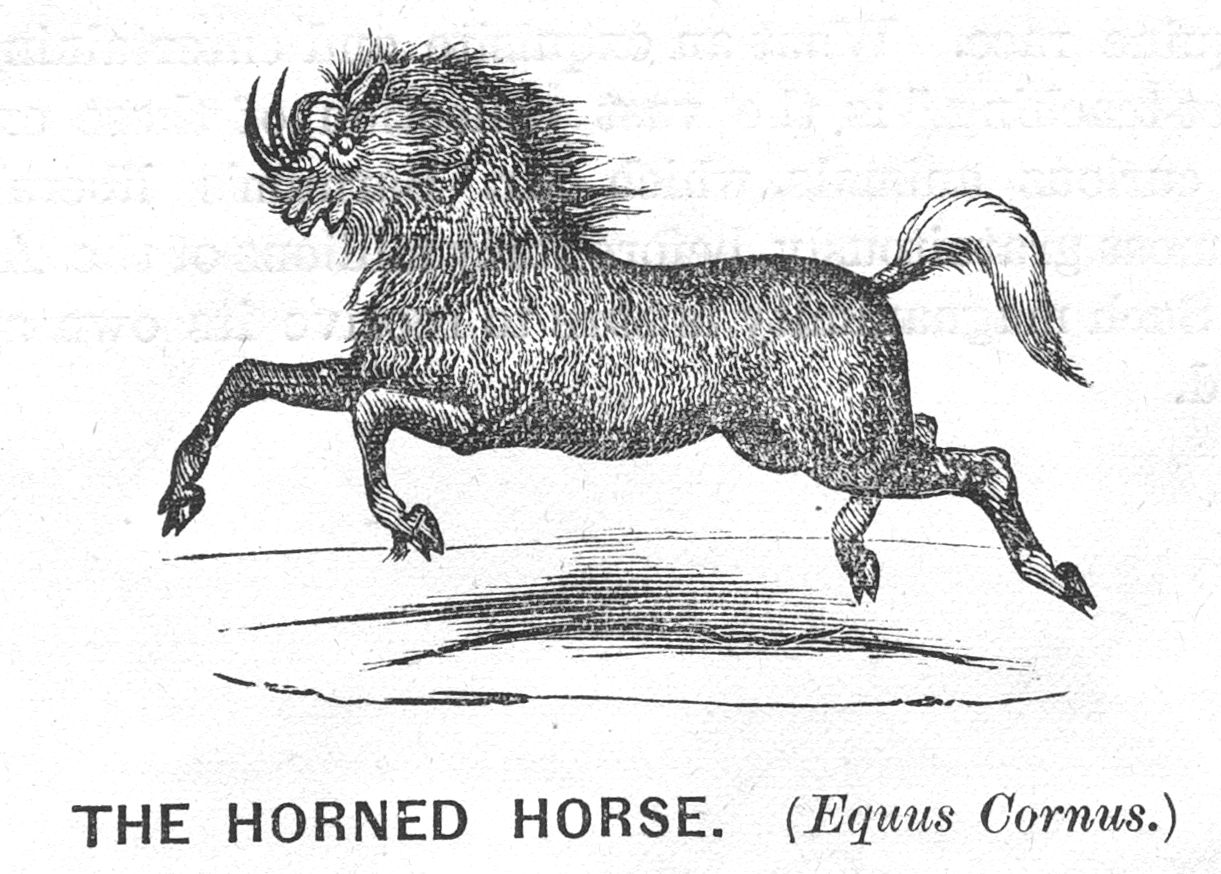
THE existence of such an animal as a Horned Horse, in the zoologic sense of that term, although frequent attempts to verify it have been made by naturalists of some pretensions, is, from the best sources of information within our reach, somewhat apocryphal. There is, however, an animal very much resembling the wild horse found in Tartary, with horns growing out of his head, somewhat similar to the Cape Buffalo - the Impfoo, or brindled Gnu - but, on close examination, proves to be closely allied to the Bison tribe. The illustration of this animal, as given in the above picture, is a sketch from life, by our artist, who never follows the delineation of the old-time naturalists. But the noble creature imported by the proprietor of this establishment differs materially from any ever before exhibited in this country. It has been supposed by some to be the same animal which Job called the "Unicorn," although, if that be the case, it is a misnomer, as that implies an animal with a single horn.
In speaking of that fabulous animal, Job says (chap. xxxix.): "Will the unicorn be willing to serve thee, or abide by the crib? Canst thou bind the unicorn with his band in the furrow? or will he harrow the valleys after thee? Wilt thou trust him because his strength is great? or wilt thou leave thy labor to him?" This evidently has reference to the rhinoceros, and not to the horned horse. Like his great prototype, he is represented as pawing in the valley and rejoicing in his strength, - of mocking at fear and not easily frightened; the quiver that rattleth against him, the glittering spear and the brazen shield, nor the fierceness of the sword, the sound of the trumpet, nor the thunders of the captains, seem to have any effect upon this marvelous specimen of the equine race. What an exquisite and entertaining school for "object-teaching" is the vast collection of these extremely rare and curious animals, which Mr. Barnum's liberality has placed, almost gratuitously, before forty millions of the American people! Such magnanimity is sure to receive its own appropriate reward.
MUSEUM CURIOSITIES.
In addition to the catalogue of leading Wild Animals in Barnum's Great Menagerie, a brief description and illustration of which are given in the preceding pages of this pamphlet, the Museum Department of the same great Traveling Exposition of the Wonder World contains many thousands of living and representative curiosities from all parts of the earth, gathered at an enormous expenditure of time and means, and exhibited for the first time under canvas.
We have neither the time nor the space to give more than a brief description of a few of the leading features of this diversified melange of the prodigious and unique.
Visitors to this department of the exhibition, through the aid of this brief catalogue, will be better prepared to judge of the merits of the entertainment, and to form an intelligent conception of the numerous leading objects placed on exhibition.
AUTOMATON, GYMNAST, DRUMMER, AND TRUMPETER.
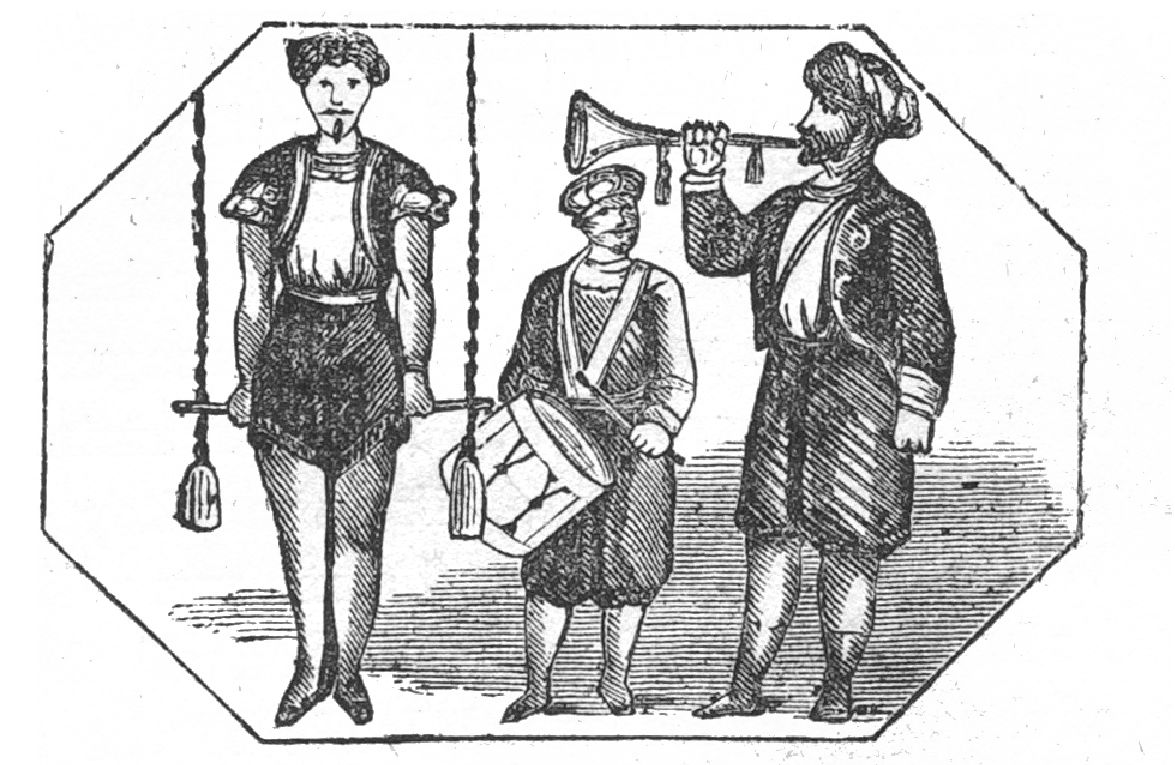
THESE remarkable figures are entirely mechanical. The Gymnast is made to accomplish all the difficult and hazardous feats of the great Leotard; the Drummer performs marvelously upon the drum, playing such pieces as the spectators may select, looks around upon the audience, answers questions in geography, arithmetic, history, etc., and surprises everybody at the facility and precision of all its skillful accomplishments with the drum.
The Trumpeter is also a very elaborate piece of mechanism, made by the celebrated M. Houdin, of Paris; plays beautiful and harmonious melodies with the trumpet, whose clarion notes fairly eclipse that of Ehud, the famous trumpeter of Israel. It is really astonishing to see what genius and mechanism have wrought in giving apparent life and animation to inanimate things.
LIVE DIGGER AND MODOC INDIANS.
From Utah and the great Yo-Semite Valley, California, will also be found in the department of Natural History. This tribe of native aborigines is the most degraded of the race. They are called Digger Indians from their habit of digging in the earth, and living on roots, herbs, etc., found in the territories of the Great West.
Notwithstanding the existence and extent of native Indians on this continent, it is surprising how few of our people know anything practically of these primeval sovereigns of the American forests. Mr. Barnum, realizing this fact in its fullest sense - in its special application to citizens of the Northern and Eastern States - has, at great trouble and expense, secured from the far West specimens of the first Digger and Modoc Indians ever seen east of the Mississippi, as far as we are able to learn.
[1873 edition: INFANT ESAU, OR BEARDED CHILD.
THIS interesting little girl, so imperfectly represented in tl1e cut, was born in Marion, South Western Virginia, on the range of the Blue Ridge Mountains, in 1866. She is only seven years old, and yet, strange to say, is covered with hair several inches long, having on her cheeks and upper lip a well-developed moustache and side whiskers!Instances are known of women of mature age being possessed of an uncommon hirsute development upon the face, giving them a coarse masculine appearance; but the idea of a beautiful little girl, a mere child, being endowed with an exquisitely formed moustache and whiskers with a massive head of black hair, and long Persian eye-lashes that would be envied by a queen, is such an uncommon thing as scarcely to be credited, if the proof did not actually stare u in the face as a living incontestable fact! The parents of little Annie Jones, for that is her name, are the same as other people, with nothing in their appearance or habits to indicate the possibility of a prodigy of this remarkable kind The only parallel to this strange lusus naturae to be found in the annals of history is that of Esau, the "first begotten of Rebekah," which happened more than three thousand seven hundred years ago; and we very much doubt if the long interval between has ever been characterized by a similar occurrence. This curiosity will be viewed and investigated by the savans, as well as the great multitude, with marked interest.]
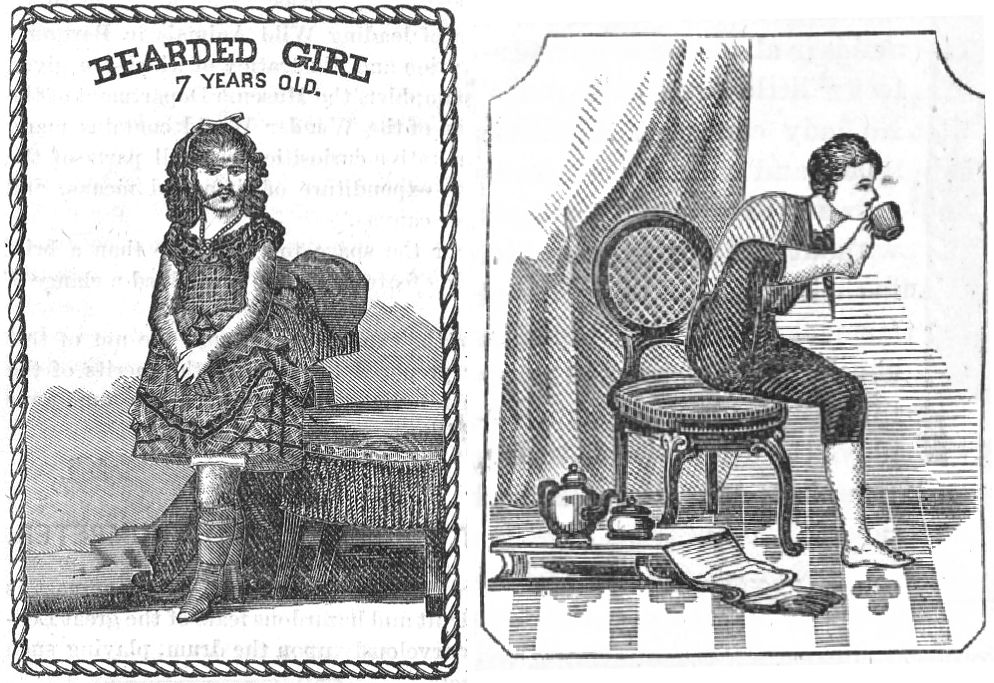
[1873 edition: A MAN BORN WITHOUT ARMS
CHARLES B. TRIPP, Esq., the young man represented in the picture, performs with his feet and toes many "unhandy" things with a dexterity truly marvelous. He eats, drinks, whittles, sews, makes change, figures, writes, ciphers, and keeps perfect accounts of all transactions with a facility almost equal to an expert chirographer.]THE ORNITHOLOGICAL DEPARTMENT
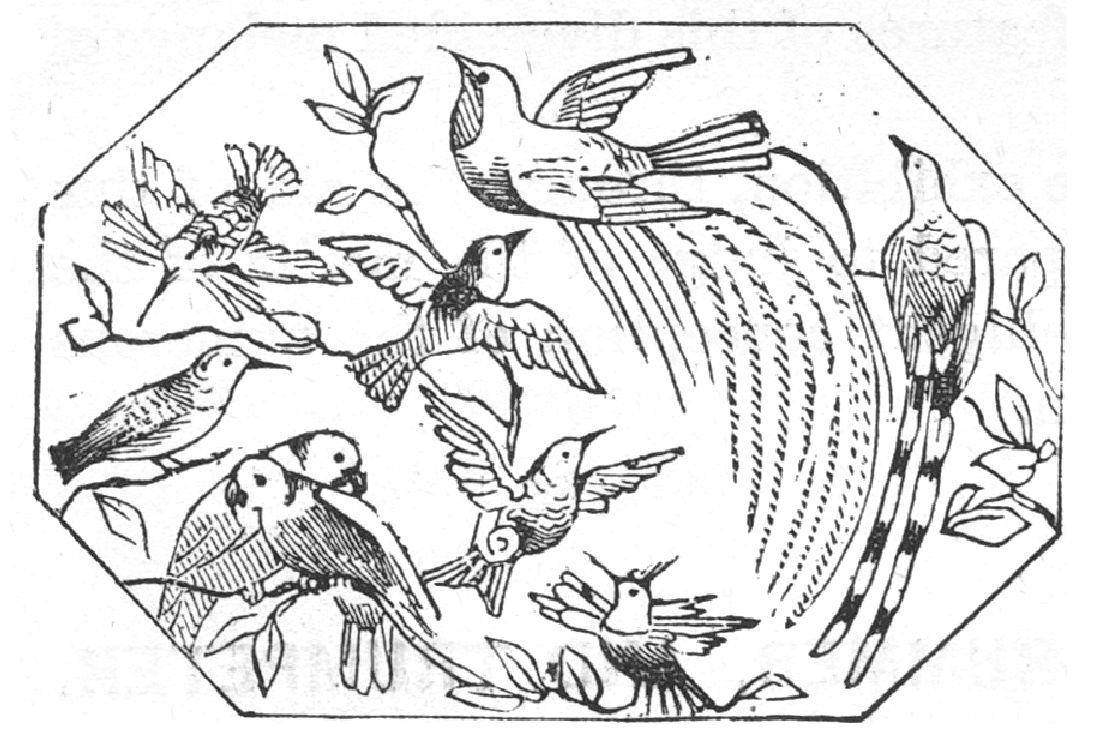
CONTAINS 1000 magnificent specimens of rare living and stuffed birds, from all parts of the earth - including parrots, macaws, cockatoos, and birds of Paradise, beautiful plumed birds from the tropics, India, Africa, and Asia, and North and South America. Among the largest of the living varieties are the ostrich and cassowary, heron, pelican, cranes, eagles, etc., and many hundreds of others, the list of which we cannot give for want of space.
"WHAT IS IT?" OR MAN-MONKEY.
PERHAPS no one feature of the Old Broadway Museum, while it was in successful operation, created more sensation or talk at the time, than that peculiarly strange nondescript, demi-humano simiade specimen, called "What Is It?" which was sent to the manager from the interior of Africa, where it was found roaming at large, in a perfectly natural state, like a monkey or orang-outang.
While its face, hands and arms were distinctly human, Its head, feet and legs possessed all the characteristics of the ape species, which leads to the supposition that it has descended from a mixed ancestry. The existence of a race of beings, half human and half savage, like the gorilla, was believed in by the ancient Carthaginians, a powerful and flourishing nation at one time, who fitted out an expedition, 350 years B. C., for the purpose of exterminating them from the coasts of Africa. It consisted of 60 large vessels, and about 30,000 men, under command of Hanno, who advanced as far as Sierra Leone, and was forced to abandon the enterprise for lack of provisions. Enough was discovered, however, to satisfy Hanno that such animals did exist; that though " covered entirely with hair, they were capable of throwing stones, and defending themselves in an admirable manner." A living specimen of this man-monkey will be found among the collection, which will be viewed with some interest by anthropologists.
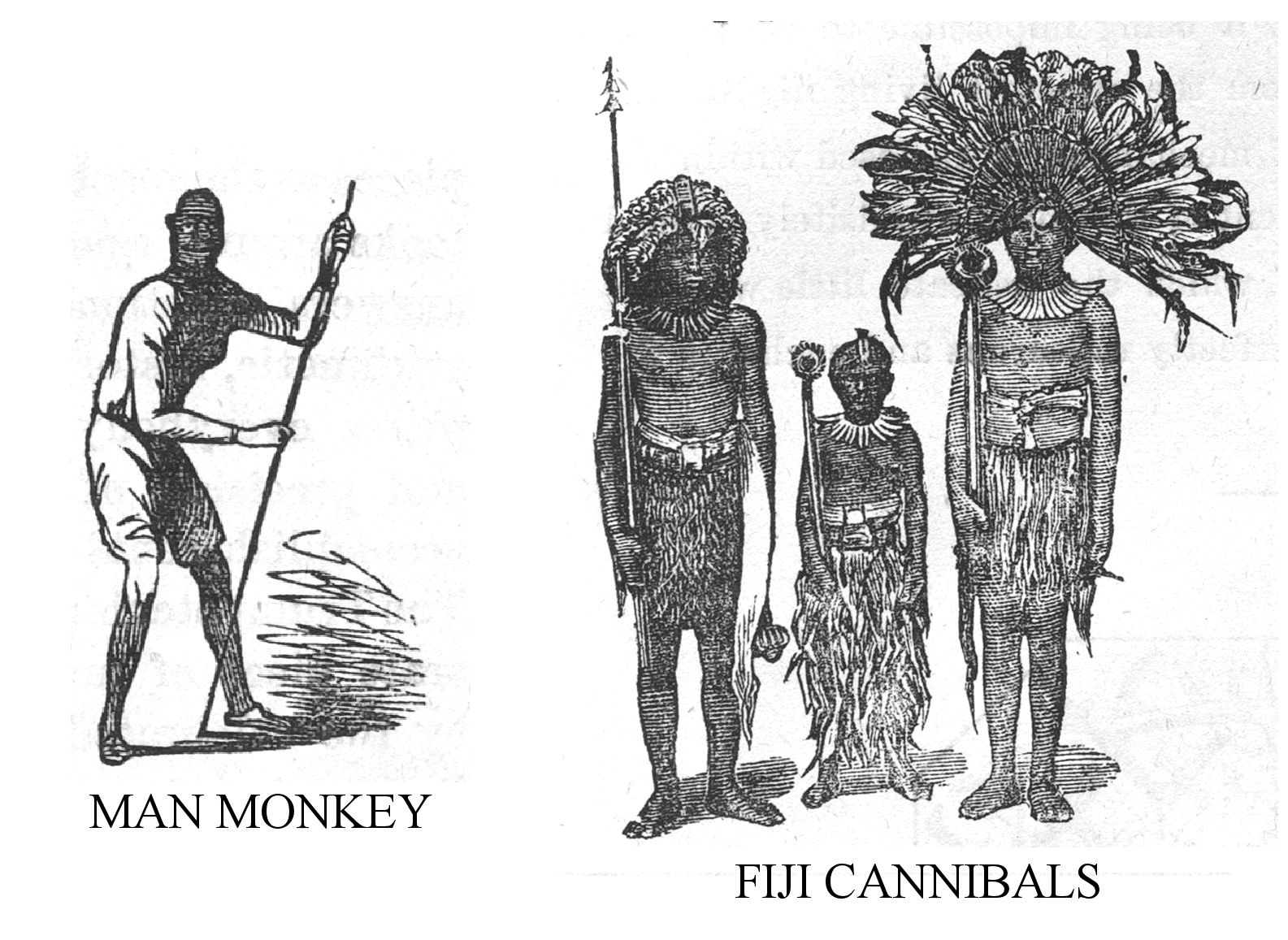
THE LIVING FIJI CANNIBALS.
Our artist has given us a tolerably correct outline of these strange anthropophagi, from Burautu of the Cannibal Islands. They were originally held as captives by King Thokambau, at Na Vita Levu. They belonged to a wild, nomadic, savage tribe from the island of Vanna Levu, which Thokambau subjugated, these captives being held as hostages of war. One of Mr. Barnum's agents in the South Sea Islands, W. C. Gardenhire, believing they would be a great curiosity to add to Mr. Barnum's anthropological collection, paid King Thokambau several thousand dollars for three years' service of them, to place on exhibition in his great traveling show. Their wild, frantic, demon-like performances, war, fan, and challenge dances, are not the least entertaining and instructive features of Mr. Barnum's Museum, and will be witnessed with deep interest by all.
AUTOMATON MUSICAL BAND,
Consisting of monkey violinist, musical rabbit, cat, and bear, strictly mechanical, and so adroitly and skillfully made as nearly to defy detection, being an infinite source of delight to the little folks, if not to "children" of maturer growth.

MECHANICAL SINGING BIRDS,
PERFECTLY natural and life-like, it being impossible to detect the notes or movements of the birds from the sweetest living nightingale or canaries. A diminutive piece of mechanism is enclosed within the natural skin and feathery integument of the most exquisitely plumed of the tiny songsters, by means of which the delicate little warblers trill their dulcet notes, which are perfectly rapturous and enchanting.
ANCIENT ARMS.
Swords, anchos, lance, missiles, long and broad swords and shields, arrows, darts, quivers, and many weapons of personal combat and international warfare used by the Ancient Greeks and Romans, Persians, and Hindoos.
ADMIRAL DOT, THE CALIFORNIA DWARF.
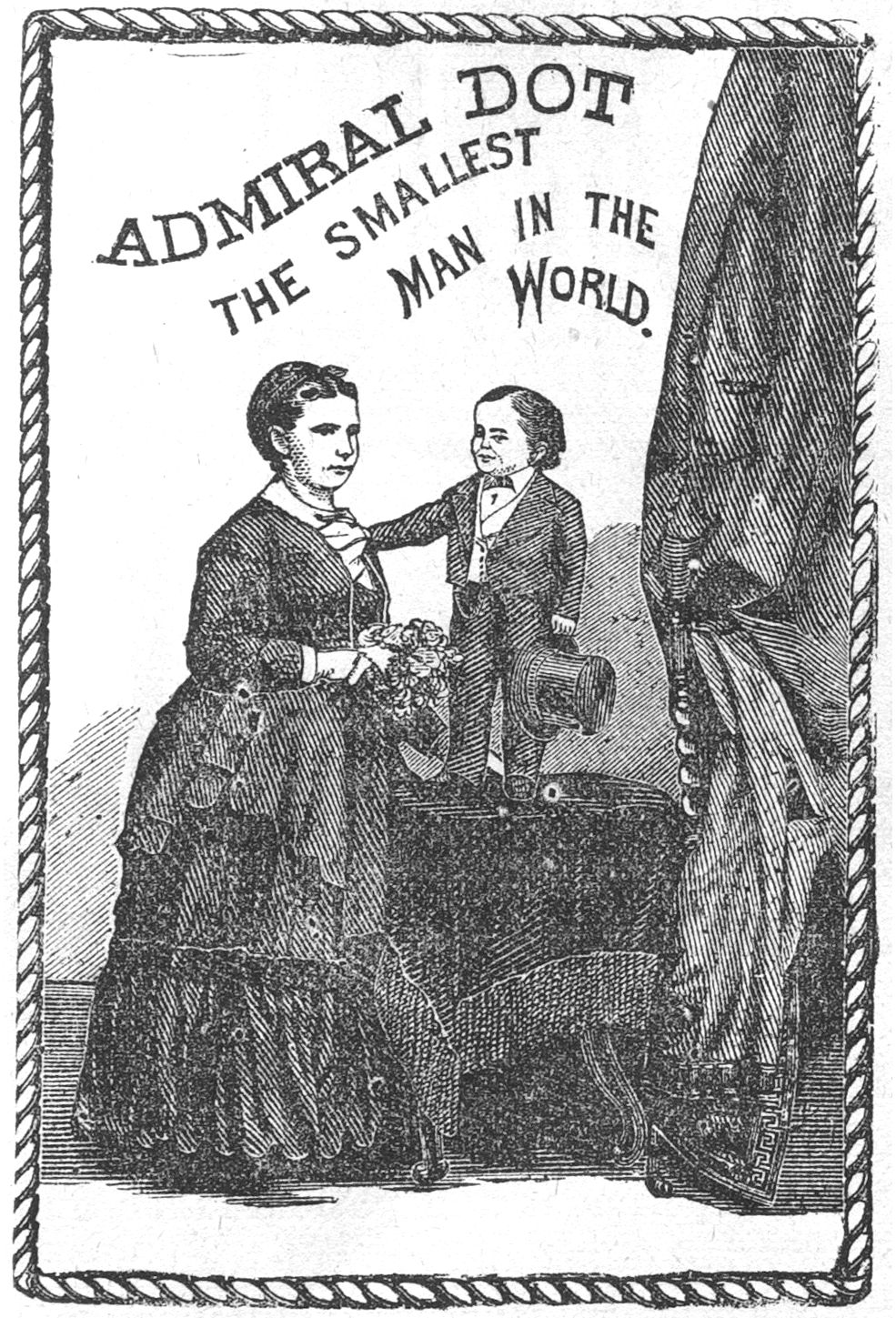
THE charming little Admiral Dot is the smallest specimen of the genus homo that walks the earth, of which we have any knowledge. He was born of German parentage in San Francisco, in 1858 - is in every respect a well-formed, perfectly developed little man in miniature - fifteen years old, twenty-five inches high, and weighs just fifteen pounds, being four times smaller than the famous General Tom Thumb! He is quick, bright, and. intelligent, has acquired the mastery of two languages, and is in all his manners a perfect "little love of a man." No lady can visit the little fellow and witness the manliness and dignity of his address without wishing to take him in their arms and plant a good "smack" on his liliputian cheek. He has learned many interesting performance:- plays the drum, sings, dances, and gives many classical poses, representing Jupiter, Ajax, Hercules, and Alexander the Great.
MECHANICAL BELL-RINGERS,
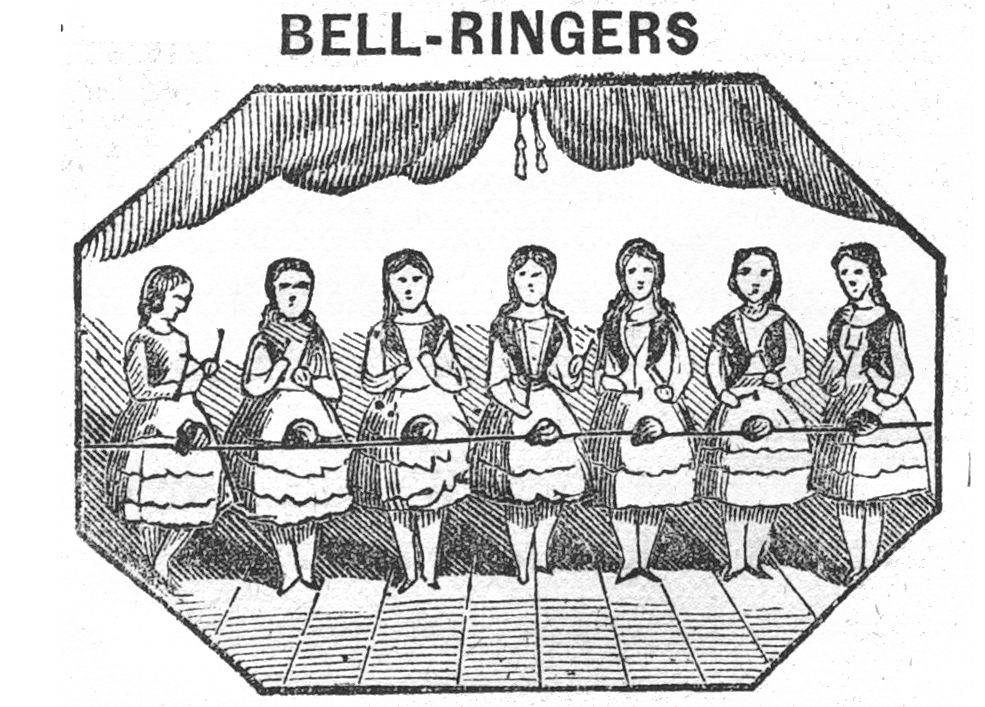
LiFE-SIZE, beautifully draped, play the most charming melodies on silver bells. These seven young ladies are all strictly mechanical; they turn their heads in different directions, and execute the most difficult pieces of music on bells, by request of the Spectators.
1874 edition: THE MARVELOUS TALKING-MACHINE.
THIS most wonderful achievement, which presents the only successful solution of a scientific and mechanical problem that has baffled the ingenuity of inventors for several centuries, is the marvelous result of nearly fifty years of genius-inspired experiment and patient labor, and the crowning attraction amid the myriad of art and artisan triumphs of all nations, collected in Mr. Barnum's priceless Museum and: Polytechnic Exposition. Wherever exhibited, it has excited the wildest interest among scientists, as well as the masses, and elicited expressions of unqualified admiration from the most celebrated of living physicists. A written description of the modus operandi and intricate mechanical construction of this lingual chef d'oeuvre would utterly fail to convey any adequate idea of its complex character and capabilities. In order to be appreciated it must be seen and heard. Suffice it here to give positive assurance that it SINGS, LAUGHS, and TALKS, with perfect fluency, in undetectable imitation of the human voice, being absolutely endowed by the extraordinary skill of the inventor with the gift of tongues, and conversing with equal perfection in all languages. Exhibited elsewhere, the price of admission would be as much, if not more, than that charged to the entire Great World's Fair of animate and inanimate wonders where it is alone to be seen.

[1873 edition: PROFESSOR FABER'S TALKING-MACHINE.
ONE of the most marvelous triumphs of mechanical science and human ingenuity known to physicists of the nineteenth century is the Wonderful life-like TALKING-MACHINE of Prof. Faber, connected with this exhibition. The accompanying illustration will give a tolerably good idea of the appearance of this instrument externally, but a very inadequate conception of its great intricacy and perfection. It is operated by means of a foot-bellows, the nozzle of which passes into an ingeniously- constructed trachea, or Wind-pipe, and is so adjusted as to produce both a dilatation and contraction of the glottis. While the bellows operates as the "breath of life," the glottis is moved in exact imitation of the human tongue by a delicate combination of little springs, connected with keys similar to those of the piano-forte, each key representing the letters, vowels, consonants, dipthongs, and the umlauts even of the German language, so difficult in pronunciation by learners, as to elicit applause from the most accomplished professors, so life-like are its imitations of all the delicate shades of lingual pronunciation. It not only speaks out loudly and distinctly the rich round words of die Mutter-Sprache, but gives also the melli?uent liquids and sibilants of the Italian and French, the euphonism of the Castilian, as well as the terrors of our own English vernacular. This ingenious production is the result of almost a lifetime of patient unremitting mechanical and scienti?c manipulation. It was commenced in 1825, and brought nearly to its present state of perfection by the distinguished German inventor in 1861, before his death, While he was yet occupying the Professorship in the Polytechnic Institute of Vienna.His intricate and extremely complicated plans have been successfully brought out by his nephew, Herr Faber, the present owner, and the ma- chine needs only to be seen and heard to call forth the admiration of all.
It has been exhibited principally to the Professors and crowned heads of Continental Europe, and to a limited number of the Colleges of America, with the most cordial and appreciative indorsements by the distingue of both Worlds. We give only one out of hundreds of like testimony.
COLUMBIA COLLEGE,
New York, November 8, 1872.
The machine of Prof. Faber, for the imitation of human speech, presents a. very near approach to a perfect solution of a scienti?c and mechanical problem which has baffled the ingenuity of inventors for several centuries. The exhibition of this machine has excited the widest interest in the principal cities of Continental Europe, and its ingenious combinations have elicited expressions of unquali?ed admiration from many of the most celebrated of living physicists. Prof. Faber is cordially recommended to the good o?ices of all the friends of science and to the con?dence of the public.
F. A. P. BARNARD,
President of Columbia College. ]
[1873 edition: THE COUNCIL of WAR.
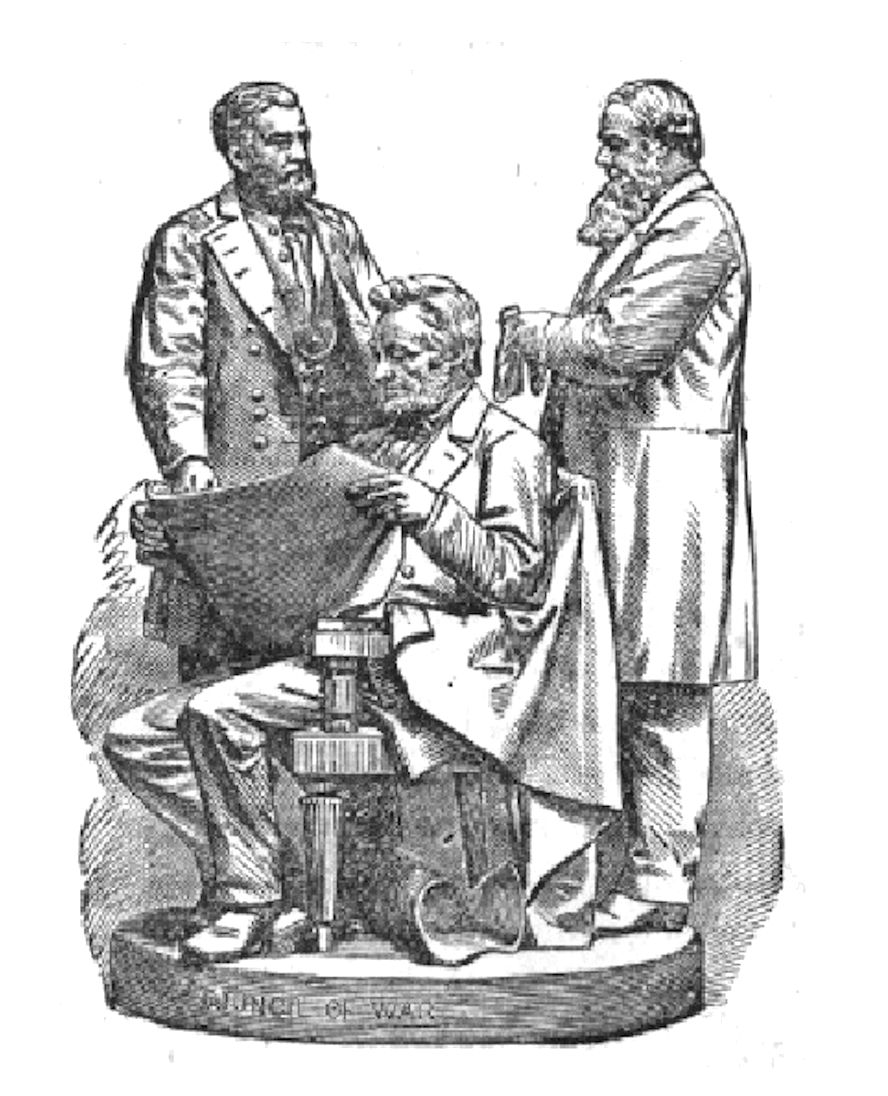
AUSTRALIAN WOMBAT.
THIS is a very remarkable animal, and it belongs to the rodent species. It is a native of Australia and Borneo. There are few specimens of this animal on exhibition in traveling menageries. It is nearly as large as a common bear - an adipose waddler, feeding principally on vegetation. Being an exotic, the voyage across the Atlantic usually proves fatal. When once acclimated, it forms an invaluable acquisition to a well-selected zoological collection. The large and beautiful specimen in the department of comparative zoology is very fine.
THE TASMANIAN DEVIL. (Diabolus Ursinus.)
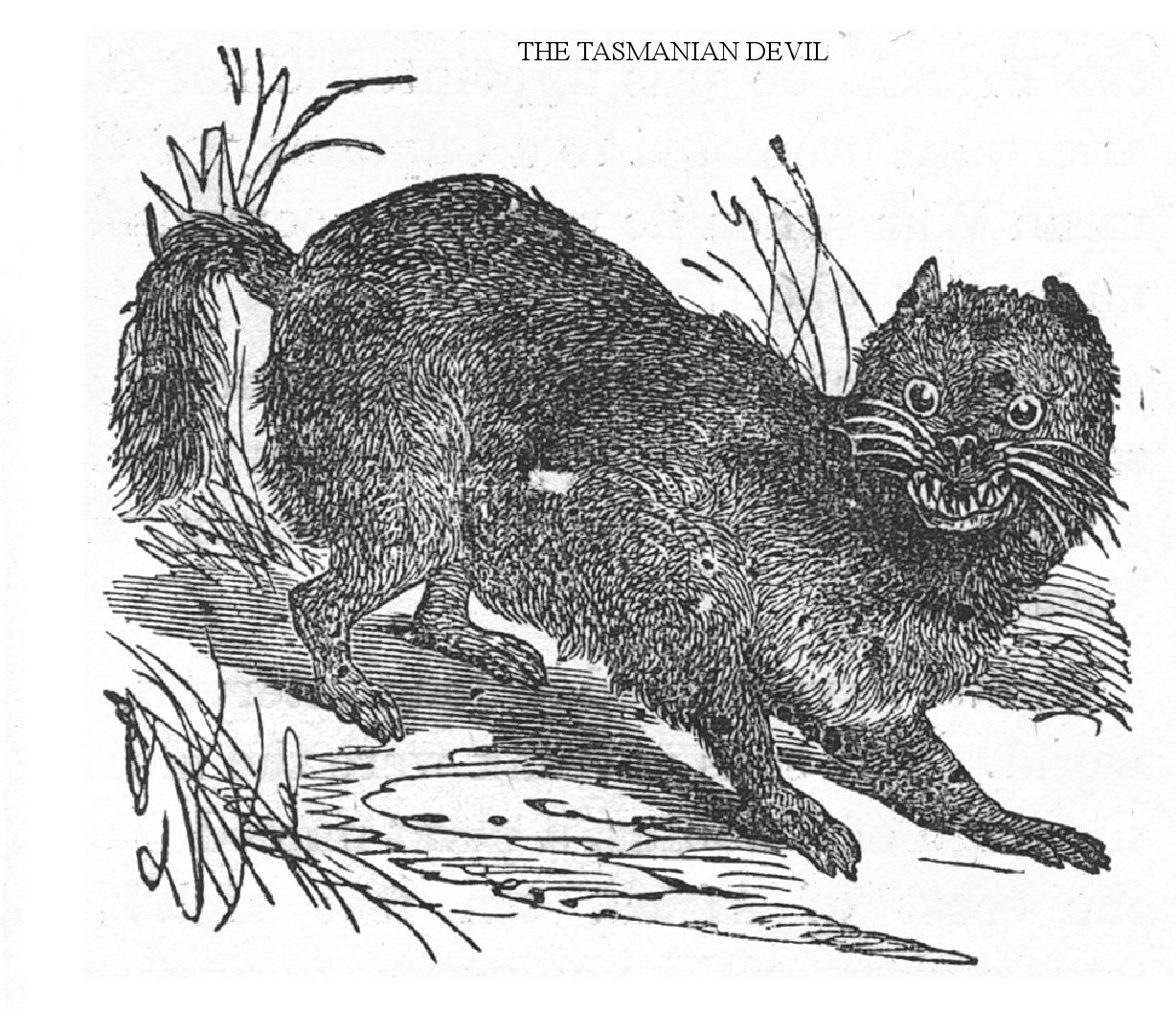
THIS strange animal, which belongs to the genus lupus, is a native of Tasmania. It has just been added to our great animal collection, and is one of the most indomitable, diabolic brutes of the whole animal kingdom. Its haunts are among the densest forests, amid the deep recesses of rock crevices, where the light of day never penetrates, and it only goes forth under the cover of the darkest nights. The early inhabitants of Van Dieman's Land called it the NATIVE DEVIL.
The Rev. J.G. Wood, in his great "Illustrated Natural History," speaking of this animal, page 487, says: "The innate and apparently ineradicable ferocity of the creature can hardly be conceived except by those who have had personal experience of its demeanor. Even in captivity its sullen and purposeless anger is continually excited, and the animal appears to be more obtuse to kindness than any other creature of whom we have practical knowledge. Generally, a caged animal soon learns to recognize its keeper, and to welcome the hand that supplies it with food; but the Tasmanian Devil seems to be diabolically devoid of gratitude, and attacks indiscriminately every being that approaches it. I have frequently had opportunities of testing the character of this curious animal, and have found it equally savage and intractable. Without the least cause it would fly at the bars of its cage, and endeavor, by dint of teeth and claws, to wreak its vengeance on me, while it gave vent to its passionate feelings in short, hoarse screams of rage. There was no reason for these outbursts of anger, for the animal behaved precisely in the same manner if anyone happened to pause in front of its domicile.
THE FRENCH GIANT.
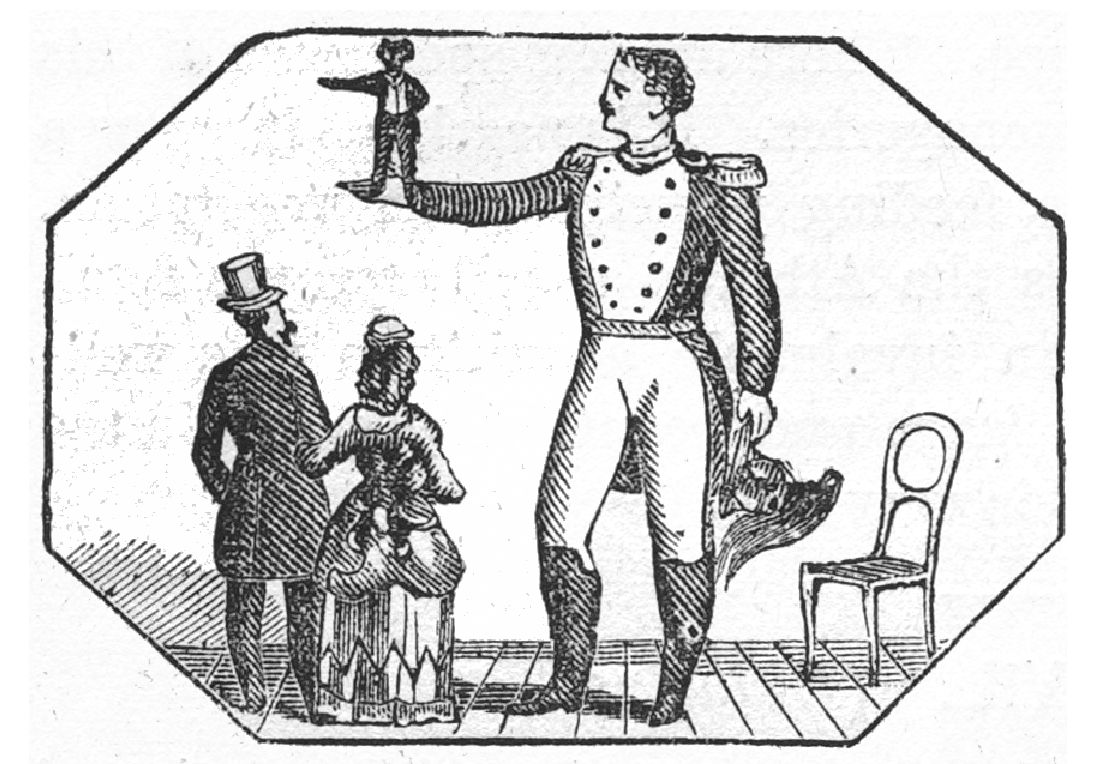
MONSIEUR GOLIATH, the great French Giant, is eight feet and two inches high - without doubt the tallest man that inhabits the earth at the present time! He was born in France, during the brief reign of the first Napoleon; distinguished himself in the revolution of '48, when Louis Phillip was expelled from Paris; also at the famous coup d'etat of 51, when Napoleon III. became the distingue parvenu of the French Empire. For his bravery and fidelity to the recent Emperor of the French, he was appointed Chief Gendarme of the Tuilleries, and afterward promoted to a Captaincy of the Garde Mobile, until the Crimean War, when he received a commission as Commander of a Battalion under Canrobert.
Being a man of gigantic proportions, and unused to any occupation, save that of the military, Monsieur Goliath sought an interview with the great curiosity caterer, P. T. Barnum, who forthwith secured him for the Museum.
Giants have existed at long intervals, from the earliest history of the world. The sons of Anak were the most famous giants of Palestine. In the reign of Claudius, a giant named Galbara was brought to Rome from the coast of Africa, ten feet high! Goropius informs us that a female giant, of like enormous stature, appeared about the same time. Proaeresius, a Greek sophist, is said to have been nine feet in height. Maximinian, the Roman Emperor, according to Julius Capitolinus, was eight feet and a half; while a Swede, of the Life-guard of Frederick the Great, was of the same size.
- * -/P>
In addition to the objects of special interest, which have been faintly illustrated by means of pictures, drawings, and designs by our artist, the Museum department contains many rare curiosities, which will be viewed with interest by historians, naturalists, archaeologists, ornithologists, geologists, conchologists, paleontologists, zoologists, and ichthyologists of every conceivable shade of opinion, whether they have attained to heights of eminence in these specialties or occupy a more humble position in the empire of the unknown.
In the brief period allotted since the disastrous fire of December 24, 1872, for the accumulation of these interesting objects, the difficulty of transporting them through the country, and the comparatively narrow space (although filling a separate colossal tent) for exhibiting them advantageously to the public, Mr. Barnum is deserving of great credit for the admirable manner in which his gigantic plan has been conceived, and the successful and interesting manner in which he has placed it before the public. He subsidizes present means to the generous end he has in view, viz., of benefitting and instructing the public, that class of his fellow citizens–for he belongs to the people–who have hitherto been prevented, by circumstances over which they had no control, from visiting his Broadway Museum, when in operation, or who otherwise have lacked opportunities of witnessing and studying natural history, through living specimens; the beautiful works of art by eminent masters; the triumphs of mechanic and automatic skill, by world-renowned artisans; the fossiliferous remains of past generations of animals and men; the diversified objects of household and culinary utensils used in all nations; and the arts, manufactures, and wearing stuffs and apparels by the different nations of the earth.
To the great masses of the public this mammoth enterprise, so magnanimously and liberally instituted, will be a treat which will be appreciated for many generations.
It may not be inappropriate to remark, en passant, that what has already been accomplished to place this establishment on its present footing is but the beginning of what Mr. Barnum proposes to do hereafter. Many years ago he conceived the project of accumulating groups of the different races of men, from all parts of the earth, as well as specimens of the animal kingdom, ornithology, and ichthyology, etc., and presenting them in such a light that the veritable contrasts may be seen at once, from which more might be learned in a single hour than could possibly be accomplished by a lifetime of hard study.
No man in America is better qualified to conceive and accomplish gigantic enterprises, and place them successfully and attractively before the public, than P. T. Barnum, whose name will pass into history as the most persevering, energetic, and audacious manager the world has ever known.